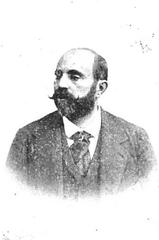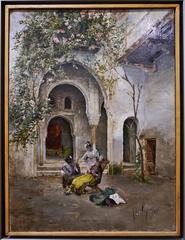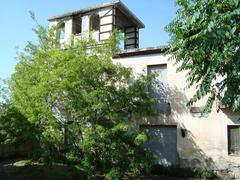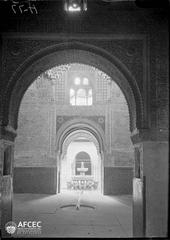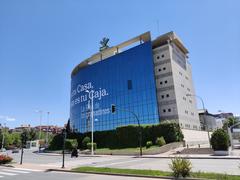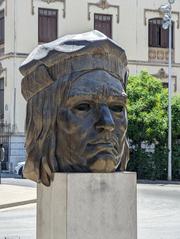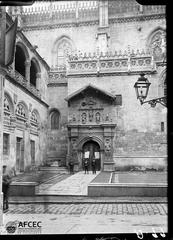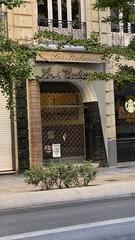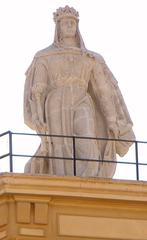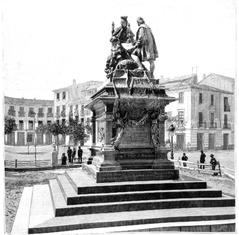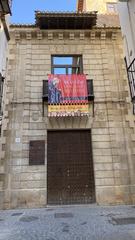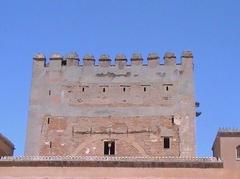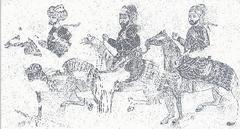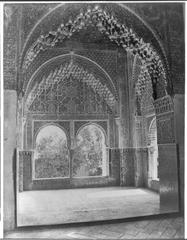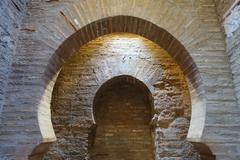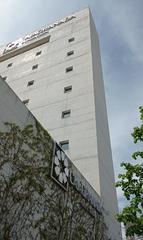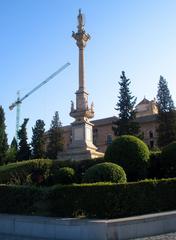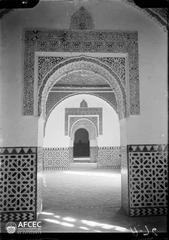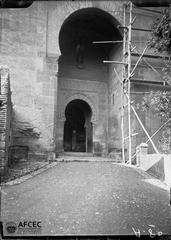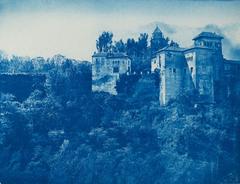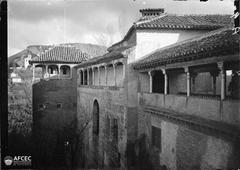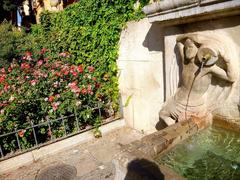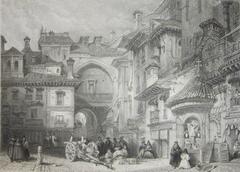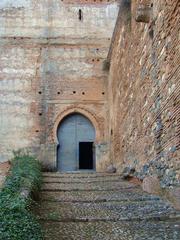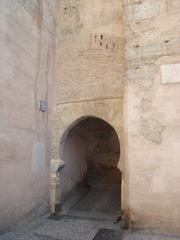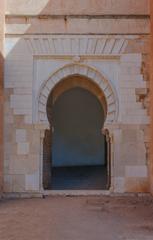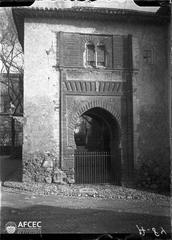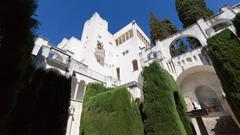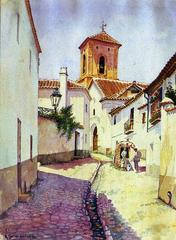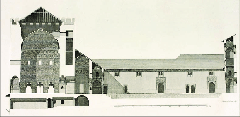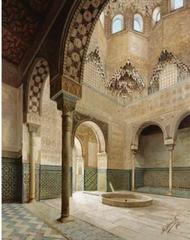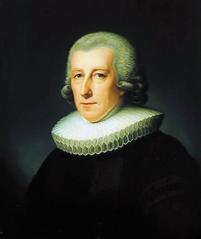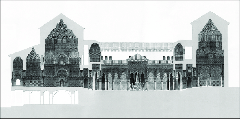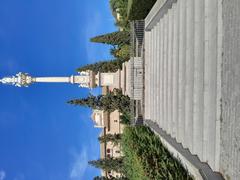
अल्काज़ार जेनिल, ग्रेनाडा: आगंतुकों के लिए एक व्यापक मार्गदर्शिका
तिथि: 04/07/2025
परिचय
ग्रेनाडा का समृद्ध इतिहास और स्थापत्य वैभव अल्काज़ार जेनिल में समाहित है, जो 13वीं सदी का एक उल्लेखनीय महल है जो अंडालूसी इस्लामी संस्कृति की ऊंचाइयों को दर्शाता है। जेनिल नदी के किनारे, पुराने शहर के ठीक बाहर स्थित, अल्काज़ार जेनिल एक शांत आश्रय स्थल और शहर के गतिशील अतीत की खिड़की दोनों के रूप में कार्य करता है। मूल रूप से अल्मोहाद काल के दौरान निर्मित और बाद में नसरी राजवंश द्वारा संवर्धित, इस महल ने शाही संपदा, राजनीतिक केंद्र और अंतिम नसरी राजा, बोबडिल की मां, आइक्सा से निकटता से जुड़ी सांस्कृतिक स्थल के रूप में महत्वपूर्ण भूमिका निभाई। आज, अल्काज़ार जेनिल आगंतुकों को अपने सुरुचिपूर्ण नसरी मेहराबों, विस्तृत प्लास्टरवर्क, कूफी शिलालेखों और अपने विशाल अल्बेरकोन जलाशय के अवशेषों का पता लगाने के लिए आमंत्रित करता है, जो अब आसन्न मेट्रो स्टेशन पर आंशिक रूप से दिखाई दे रहा है।
यह व्यापक मार्गदर्शिका अल्काज़ार जेनिल के इतिहास, वास्तुशिल्प विशेषताओं, आगंतुकों के घंटों और टिकटों (मुफ्त प्रवेश सहित), पहुंच, निर्देशित पर्यटन और अल्हम्ब्रा और गेनरालिफ़ गार्डन जैसे आस-पास के आकर्षणों के साथ अपनी यात्रा को जोड़ने के तरीकों पर व्यावहारिक जानकारी को कवर करती है। चाहे आप इतिहास के उत्साही हों या जिज्ञासु यात्री, यह संसाधन आपको ग्रेनाडा के सबसे मनोरम और कम ज्ञात खजानों में से एक की अपनी यात्रा का अधिकतम लाभ उठाने में मदद करेगा (फ्रांसिस्को अयाला फाउंडेशन, ग्रेनाडा कल्चरल टूर्स, हेग्रेनाडा)।
त्वरित आगंतुक जानकारी
- खुलने का समय: सोमवार से शुक्रवार, सुबह 9:00 बजे से दोपहर 3:00 बजे तक
- टिकट: नि: शुल्क प्रवेश
- स्थान: जेनिल नदी के बाएं किनारे पर, ग्रेनाडा शहर के केंद्र से लगभग 1 किमी दूर
- पहुँच: साइट आगंतुकों के लिए है जो कम गतिशीलता वाले हैं
- निर्देशित पर्यटन और कार्यक्रम: फ्रांसिस्को अयाला फाउंडेशन के माध्यम से आयोजित; शेड्यूल और विशेष प्रोग्रामिंग के लिए उनकी वेबसाइट देखें
ऐतिहासिक पृष्ठभूमि
उत्पत्ति और ऐतिहासिक महत्व
लगभग 1218–1219 में ग्रेनाडा के अल्मोहाद गवर्नर, सईद ईशाक द्वारा निर्मित, अल्काज़ार जेनिल - मूल रूप से अल-कासर अल-सईद के नाम से जाना जाता था - एक अल्मुनिया, या ग्रामीण महल के रूप में डिजाइन किया गया था, जिसमें विस्तृत बगीचे और एक प्रभावशाली अल्बेरकोन, सिंचाई और नौसैनिक युद्धों जैसे मनोरंजक कार्यक्रमों के लिए उपयोग किया जाने वाला जलाशय था। नसरी राजवंश के उदय के साथ, विशेष रूप से सुल्तान यूसुफ प्रथम के अधीन, महल को एक माध्यमिक शाही निवास में बदल दिया गया, जिसमें विस्तृत प्लास्टर, ज्यामितीय रूपांकनों और नसरी कलात्मकता का उदाहरण देने वाले कूफी शिलालेख शामिल थे। यह महल विशेष रूप से अंतिम नसरी राजा, बोबडिल की मां, आइक्सा अल-होर्रा से जुड़ा हुआ है, जो मुस्लिम शासन के तहत ग्रेनाडा के अंतिम वर्षों के दौरान यहां रहती थीं।
ईसाई पुन: विनियोजन और बाद का विकास
कैथोलिक सम्राटों द्वारा 1492 में ग्रेनाडा की विजय के बाद, अल्काज़ार जेनिल एक ईसाई संपत्ति बन गया, और सैन सेबेस्टियन चैपल को इसके मैदान में जोड़ा गया। सदियों से, संपत्ति हाथों-हाथ बदली, उद्यानों का विनाश हुआ, और शहरी विकास से प्रभावित हुई। 20वीं सदी के अंत में बहाली की पहलों ने केंद्रीय नसरी मंडप (कुब्बा) और प्रमुख सजावटी तत्वों को संरक्षित किया है, जिससे साइट की निरंतर सांस्कृतिक प्रासंगिकता सुनिश्चित होती है।
वास्तुशिल्प मुख्य बातें
- प्रवेश और लेआउट: महल को नुकीले घोड़े की नाल के मेहराब के माध्यम से प्रवेश किया जाता है, जो एक केंद्रीय हॉल की ओर जाता है जिसमें लकड़ी का गुंबद और जाली वाली खिड़कियां प्राकृतिक प्रकाश को छानती हैं।
- आंतरिक सजावट: प्लास्टर वनस्पति रूपांकनों, कूफी लिपि, और मूल नीली और सफेद टाइल वाली फर्श नसरी शिल्प कौशल का प्रदर्शन करती हैं।
- 19वीं सदी के संवर्द्धन: वास्तुकार राफेल कॉन्ट्रेरास ने पार्श्व पंखों और एक पोर्टिको को जोड़ा जो नसरी संरचना को उसके चरित्र को हावी किए बिना पूरक करता है।
- बगीचे: आसपास के अंडालूसी बगीचों में मर्टल, लैवेंडर, अनार और हैकबेरी के पौधे लगाए गए हैं, जो आगंतुकों के लिए एक शांत वातावरण बनाते हैं।
अल्बेरकोन और पुरातात्विक अनुभव
संपत्ति की एक परिभाषित विशेषता इसका विशाल अल्बेरकोन था, जो 120 मीटर से अधिक फैला हुआ जलाशय था। ग्रेनाडा मेट्रो के निर्माण के दौरान, इस मध्ययुगीन हाइड्रोलिक चमत्कार के अवशेषों का पता चला और अब उन्हें अल्काज़ार जेनिल मेट्रो स्टेशन के नीचे संरक्षित किया गया है। आगंतुक इन पुरातात्विक अवशेषों को देख सकते हैं, जो ग्रेनाडा के मध्ययुगीन और आधुनिक इतिहासों को मिश्रित करते हैं (हेग्रेनाडा)।
अपनी यात्रा की योजना बनाना
वहाँ कैसे पहुँचें
- मेट्रो द्वारा: अल्काज़ार जेनिल मेट्रो स्टेशन सीधे महल के बगल में है और पूरी तरह से सुलभ है।
- बस द्वारा: लाइनें 5, 11, और 21 सभी साइट से कुछ ही मिनटों की पैदल दूरी पर रुकती हैं (थ्रिलफिलिया)।
- पैदल: महल केंद्रीय ग्रेनाडा से पैदल दूरी पर है।
- कार द्वारा: सीमित सड़क पार्किंग; सार्वजनिक परिवहन की सिफारिश की जाती है।
आगंतुक सेवाएँ और सुविधाएँ
- केंद्रीय मंडप: आगंतुकों के लिए खुला है, जिसमें प्रदर्शनियाँ और सांस्कृतिक गतिविधियाँ होती हैं।
- पुस्तकालय और प्रदर्शनी स्थान: फ्रांसिस्को अयाला फाउंडेशन द्वारा प्रबंधित, अस्थायी प्रदर्शनियों और अयाला के व्यक्तिगत संग्रह तक पहुंच के साथ।
- शौचालय और सुविधाएँ: मंडप और मेट्रो स्टेशन में उपलब्ध।
- पहुँच: रैंप, आधुनिक प्रवेश द्वार, और पूरी तरह से सुलभ कार्यक्रम स्थान, जिसमें जिमेनेज़ टोरेसिल्लास बहुउद्देशीय हॉल शामिल है (2031ग्रेनाडा)।
- बगीचे: अच्छी तरह से बनाए रखा गया है और जंगली बिल्लियों के एक दोस्ताना समुदाय का घर है (रेडिट)।
कार्यक्रम और गतिविधियाँ
फ्रांसिस्को अयाला फाउंडेशन विभिन्न प्रकार के सांस्कृतिक कार्यक्रमों की मेजबानी करता है, जिनमें शामिल हैं:
- अस्थायी कला और फोटोग्राफी प्रदर्शनियाँ
- साहित्यिक और पुस्तक प्रस्तुतियाँ
- संगीत कार्यक्रम और पुरस्कार समारोह
- स्थानीय स्कूलों और सामुदायिक संगठनों के लिए शैक्षिक गतिविधियाँ
आसन्न जिमेनेज़ टोरेसिल्लास हॉल बड़े कार्यक्रमों के लिए एक आधुनिक स्थल प्रदान करता है, जिसमें उन्नत ध्वनिक और मल्टीमीडिया सुविधाएं हैं (2031ग्रेनाडा)।
यात्रा का सबसे अच्छा समय
- सप्ताहांत की सुबह: एक शांत अनुभव और इष्टतम फोटोग्राफी स्थितियों के लिए।
- वसंत और शरद ऋतु: महल और बगीचों दोनों को खोजने के लिए हल्का मौसम।
- कार्यक्रमों के दौरान: वर्तमान प्रदर्शनियों और सांस्कृतिक प्रोग्रामिंग पर जानकारी के लिए फाउंडेशन की वेबसाइट देखें।
आवश्यक आगंतुक युक्तियाँ
- घंटे सत्यापित करें: हमेशा ऑनलाइन नवीनतम आगंतुक घंटे और कार्यक्रम शेड्यूल की जांच करें।
- फोटोग्राफी: अधिकांश क्षेत्रों में अनुमति है, लेकिन फ्लैश और तिपाई प्रतिबंधित हो सकते हैं।
- स्मारक का सम्मान करें: कर्मचारियों के निर्देशों और पोस्ट किए गए संकेतों का पालन करें।
- आकर्षणों को मिलाएं: सांस्कृतिक अन्वेषण के पूरे दिन के लिए अल्हम्ब्रा, गेनरालिफ़ गार्डन, या अल्बेसिन के साथ अपनी यात्रा को जोड़ें।
- बगीचों का आनंद लें: निवासी बिल्ली समुदाय का निरीक्षण करें, लेकिन उन्हें खाना न खिलाएं या परेशान न करें।
अक्सर पूछे जाने वाले प्रश्न (FAQ)
Q: अल्काज़ार जेनिल के खुलने का समय क्या है? A: सोमवार से शुक्रवार, सुबह 9:00 बजे से दोपहर 3:00 बजे तक; सप्ताहांत और छुट्टियों पर बंद।
Q: क्या प्रवेश शुल्क है? A: प्रवेश निःशुल्क है; कुछ कार्यक्रमों के लिए टिकट या पंजीकरण की आवश्यकता हो सकती है।
Q: क्या निर्देशित पर्यटन उपलब्ध हैं? A: हाँ, फ्रांसिस्को अयाला फाउंडेशन या स्थानीय पर्यटन सेवाओं के माध्यम से निर्देशित पर्यटन बुक किए जा सकते हैं।
Q: क्या साइट कम गतिशीलता वाले आगंतुकों के लिए सुलभ है? A: हाँ, हालिया उन्नयन ने पहुंच में सुधार किया है। व्यक्तिगत सहायता के लिए फाउंडेशन से संपर्क करें।
Q: क्या मैं अल्बेरकोन पुरातात्विक अवशेष देख सकता हूँ? A: हाँ, वे अल्काज़ार जेनिल मेट्रो स्टेशन में एकीकृत हैं।
दृश्य और इंटरैक्टिव संसाधन
- फ्रांसिस्को अयाला फाउंडेशन के माध्यम से वर्चुअल टूर और उच्च-रिज़ॉल्यूशन छवि गैलरी का अन्वेषण करें।
- आगंतुकों के मानचित्र और मार्गदर्शिकाएँ ऑनलाइन उपलब्ध हैं, जिसमें “अल्काज़ार जेनिल मंडप नसरी वास्तुकला” और “ग्रेनाडा में अल्काज़ार जेनिल स्थान दिखाने वाला मानचित्र” जैसे चित्र को कीवर्ड से बेहतर बनाने के लिए उपयोग किया गया है।
निष्कर्ष
अल्काज़ार जेनिल नसरी कला, ऐतिहासिक अनुनाद और आधुनिक सांस्कृतिक जुड़ाव का एक अनूठा मिश्रण है। अपने शांतिपूर्ण बगीचों, खूबसूरती से संरक्षित वास्तुकला और समृद्ध कार्यक्रमों के साथ, यह ग्रेनाडा के व्यस्त आकर्षणों का एक अंतरंग विकल्प प्रदान करता है। मुफ्त प्रवेश, पहुंच सुविधाओं और अन्य प्रमुख साइटों से निकटता इसे ग्रेनाडा की विरासत की पूरी टेपेस्ट्री का अनुभव करने के इच्छुक किसी भी व्यक्ति के लिए एक आवश्यक गंतव्य बनाती है।
योजना बनाने में आगे रहें, आधिकारिक संसाधनों का उपयोग करें, और निर्देशित पर्यटन और अंदरूनी युक्तियों के लिए ऑडियाला ऐप डाउनलोड करने पर विचार करें। अपडेट किए गए शेड्यूल, कार्यक्रमों और आगंतुक जानकारी के लिए, फ्रांसिस्को अयाला फाउंडेशन और ग्रेनाडा मेट्रो से परामर्श करें।
संदर्भ
- अल्काज़ार जेनिल: ग्रेनाडा के छिपे हुए रत्न के लिए आगंतुक घंटे, टिकट और ऐतिहासिक मार्गदर्शिका (फ्रांसिस्को अयाला फाउंडेशन)
- अल्काज़ार जेनिल: ग्रेनाडा के ऐतिहासिक नसरी महल के लिए आगंतुक घंटे, टिकट और अन्वेषण (ibnbattutatravel.com)
- अल्काज़ार डेल जेनिल: ग्रेनाडा के छिपे हुए रत्न के लिए आगंतुक घंटे, टिकट और इतिहास (ग्रेनाडा कल्चरल टूर्स)
- अल्काज़ार जेनिल आगंतुक घंटे, टिकट और ग्रेनाडा के ऐतिहासिक रत्न के लिए मार्गदर्शिका (हेग्रेनाडा)
- अल्काज़ार जेनिल: ग्रेनाडा के ऐतिहासिक रत्न के लिए आगंतुक घंटे, टिकट और गाइड (थ्रिलफिलिया)
- सामुदायिक प्रभाव और स्थानीय युक्तियाँ (रेडिट)
- नया बहुउद्देश्यीय हॉल और पहुंच उन्नयन (2031ग्रेनाडा)
ऑडियाला2024{‘date’: ‘04/07/2025’, ‘task’: {‘model’: ‘gpt-4.1-mini’, ‘query’: ‘Comprehensive guide to visiting Alcázar Genil, Granada, Spain: history, significance, visitor tips, and everything tourists need to know for a memorable experience.’, ‘verbose’: False, ‘guidelines’: [“Keyword Research: Identify relevant keywords that potential visitors are likely to search for, such as ‘[Monument Name] visiting hours,’ ‘[Monument Name] tickets,’ and ‘[City] historical sites.’ Use these keywords strategically throughout the article, including in the title, headers, and body text, but avoid keyword stuffing.”, ‘Engaging and Informative Title: Craft a title that is both SEO-friendly and compelling to encourage clicks. Include the main keyword and make it clear what the article will cover.’, ‘Structured Content: Use headings (H1, H2, H3) to organize the content effectively. This helps with SEO and makes the article easier for readers to navigate. Include an introduction that hooks the reader, a detailed body that covers all relevant aspects, and a conclusion that summarizes the key points.’, ‘Comprehensive Coverage: Address common questions and topics of interest such as the history of the monument, its cultural significance, visitor information (e.g., ticket prices, opening hours), travel tips, nearby attractions, and accessibility. Include sections that might be unique to the monument, like special events, guided tours, and photographic spots.’, ‘Quality Content: Ensure the content is well-researched, accurate, and provides real value to readers. Use reliable sources and provide factual information. Write in a clear, engaging, and accessible style. Consider your audience and use language that is appropriate for those likely to visit the monument.’, ‘Visuals and Media: Incorporate high-quality images or videos of the monument. These should be optimized for the web (correct sizing, alt tags with keywords). Consider interactive elements like virtual tours or maps.’, ‘Internal and External Links: Include links to other related articles on your site to encourage deeper engagement (internal links). Link to official websites for the monument or credible sources for further reading (external links).’, ‘FAQ: Incorporate FAQ sections to target voice search queries and featured snippets’, ‘Visit and Stay Up to Date: End the article with a call to action, such as encouraging readers to download our mobile app Audiala, check out other related posts, or follow on social media for more updates.’], ‘max_sections’: 4, ‘publish_formats’: {‘pdf’: False, ‘docx’: False, ‘markdown’: True}, ‘follow_guidelines’: True}, ‘title’: ‘Alcázar Genil, Granada: A Comprehensive Visitor’s Guide’, ‘report’: ”# Alcázar Genil Granada: Visiting Hours, Tickets, and Historical Guide\n\n#### Date: 04/07/2025\n\n## Introduction\n\nGranada’s rich history and architectural splendor are embodied in the Alcázar Genil, a remarkable 13th-century palace reflecting the heights of Andalusian Islamic culture. Situated on the banks of the Genil River, just outside the old city, the Alcázar Genil serves as both a tranquil retreat and a window into the city’s dynamic past. Originally constructed during the Almohad period and later enhanced by the Nasrid dynasty, the palace played a significant role as a royal estate, a political hub, and a cultural landmark closely tied to Aixa, mother of Boabdil—the last Nasrid king. Today, the Alcázar Genil invites visitors to explore its elegant Nasrid arches, elaborate stucco work, Kufic inscriptions, and the remnants of its vast albercón reservoir, now partially visible at the adjacent metro station.\n\nThis comprehensive guide covers the Alcázar Genil’s history, architectural features, practical information on visiting hours and tickets (including free admission), accessibility, guided tours, and ways to enrich your experience by connecting your visit to nearby attractions like the Alhambra and Generalife Gardens. Whether you are a history enthusiast or a curious traveler, this resource will help you make the most of your visit to one of Granada’s most captivating and lesser-known treasures (Francisco Ayala Foundation, Granada Cultural Tours, HeyGranada).\n\n---\n\n## Quick Visitor Information\n\n- Opening Hours: Monday to Friday, 9:00 AM – 3:00 PM \n- Tickets: Free entry \n- Location: Left bank of the Genil River, approximately 1 km from Granada’s city center \n- Accessibility: The site accommodates visitors with reduced mobility \n- Guided Tours & Events: Organized through the Francisco Ayala Foundation; check their website for schedules and special programming\n\n---\n\n## Historical Background\n\n### Origins and Historical Significance\n\nBuilt around 1218–1219 by Sayyid Ishaq, the Almohad governor of Granada, the Alcázar Genil—originally known as al-Qasr al-Sayyid—was designed as an almunia, or rural palace, with expansive gardens and an impressive albercón, a reservoir used for both irrigation and recreational events like mock naval battles. With the rise of the Nasrid dynasty, particularly under Sultan Yusuf I, the palace was transformed into a secondary royal residence, acquiring intricate stucco, geometric motifs, and Kufic inscriptions that exemplify Nasrid artistry. The palace is notably associated with Aixa al-Horra, mother of the last Nasrid king, Boabdil, who resided here during Granada’s final years under Muslim rule.\n\n### Christian Reappropriation and Later Developments\n\nAfter the 1492 conquest of Granada by the Catholic Monarchs, the Alcázar Genil became a Christian estate, and the Ermita de San Sebastián chapel was added to its grounds. Over the centuries, the property changed hands, underwent garden destruction, and was altered by urban development. Restoration initiatives in the late 20th century have preserved the central Nasrid pavilion (qubba) and key decorative elements, ensuring the site’s continued cultural relevance.\n\n---\n\n## Architectural Highlights\n\n- Entrance & Layout: The palace is entered through a pointed horseshoe arch, leading into a central hall with a wooden dome and lattice windows filtering natural light.\n- Interior Decoration: Stucco vegetal motifs, Kufic script, and original blue and white tiled floors showcase Nasrid craftsmanship.\n- 19th-Century Enhancements: Architect Rafael Contreras added lateral wings and a portico that complement the Nasrid structure without overshadowing its character.\n- Gardens: The surrounding Andalusian gardens are planted with myrtle, lavender, pomegranate, and hackberry, creating a serene environment for visitors.\n\n---\n\n## The Albercón and the Archaeological Experience\n\nA defining feature of the estate was its massive albercón, a reservoir stretching over 120 meters. During the construction of the Granada Metro, remains of this medieval hydraulic marvel were uncovered and are now preserved beneath the Alcázar Genil metro station. Visitors can view these archaeological remains, blending Granada’s medieval and modern histories (HeyGranada).\n\n---\n\n## Planning Your Visit\n\n### Getting There\n\n- By Metro: The Alcázar Genil metro station is directly adjacent to the palace and fully accessible.\n- By Bus: Lines 5, 11, and 21 all stop within a few minutes’ walk of the site (Thrillophilia).\n- On Foot: The palace is within walking distance of central Granada.\n- By Car: Limited street parking; public transport recommended.\n\n### Visitor Services & Facilities\n\n- Central Pavilion: Open to visitors, featuring exhibitions and cultural activities.\n- Library & Exhibition Spaces: Managed by the Francisco Ayala Foundation, with temporary exhibits and access to Ayala’s personal collection.\n- Restrooms & Amenities: Available in the pavilion and metro station.\n- Accessibility: Ramps, modern entrances, and fully accessible event spaces, including the Jiménez Torrecillas multi-purpose hall (2031Granada).\n- Gardens: Well-maintained and home to a friendly community of feral cats (Reddit).\n\n---\n\n## Events and Activities\n\nThe Francisco Ayala Foundation hosts a variety of cultural events, including:\n- Temporary art and photography exhibitions\n- Literary and book presentations\n- Concerts and award ceremonies\n- Educational activities for local schools and community organizations\n\nThe adjacent Jiménez Torrecillas Hall provides a modern venue for larger events, with advanced acoustic and multimedia facilities (2031Granada).\n\n---\n\n## Best Times to Visit\n\n- Weekday Mornings: For a tranquil experience and optimal photography conditions.\n- Spring & Autumn: Mild weather for exploring both the palace and gardens.\n- During Events: Check the Foundation’s website for information on current exhibitions and cultural programming.\n\n---\n\n## Essential Visitor Tips\n\n- Verify Hours: Always check the latest visiting hours and event schedules online.\n- Photography: Permitted in most areas, but flash and tripods may be restricted.\n- Respect the Monument: Follow staff instructions and posted signage.\n- Combine Attractions: Pair your visit with the Alhambra, Generalife Gardens, or the Albaicín for a full day of cultural exploration.\n- Enjoy the Gardens: Observe the resident cat community, but do not feed or disturb them.\n\n---\n\n## Frequently Asked Questions (FAQ)\n\nQ: What are the Alcázar Genil visiting hours? \nA: Monday to Friday, 9:00 AM to 3:00 PM; closed weekends and holidays.\n\nQ: Is there an entrance fee? \nA: Admission is free; some events may require tickets or registration.\n\nQ: Are guided tours available? \nA: Yes, guided tours can be booked through the Francisco Ayala Foundation or local tourism services.\n\nQ: Is the site accessible for visitors with reduced mobility? \nA: Yes, recent upgrades have improved accessibility. Contact the Foundation for personalized assistance.\n\nQ: Can I see the albercón archaeological remains? \nA: Yes, they are integrated into the Alcázar Genil metro station.\n\n---\n\n## Visual & Interactive Resources\n\n- Explore virtual tours and high-resolution image galleries via the Francisco Ayala Foundation.\n- Maps and visitor guides are available online, with alt text for images such as “Alcázar Genil pavilion Nasrid architecture” and “Map showing Alcázar Genil location in Granada” to enhance accessibility.\n\n---\n\n## Conclusion\n\nThe Alcázar Genil is a unique blend of Nasrid art, historical resonance, and modern cultural engagement. With its peaceful gardens, beautifully preserved architecture, and enriching events, it offers an intimate alternative to Granada’s busier attractions. Free admission, accessibility features, and proximity to other major sites make it an essential destination for anyone seeking to experience the full tapestry of Granada’s heritage.\n\nPlan ahead, utilize official resources, and consider downloading the Audiala app for guided tours and insider tips. For updated schedules, events, and visitor information, consult the Francisco Ayala Foundation and Granada Metro.\n\n---\n\n## References\n\n- Alcázar Genil: Visiting Hours, Tickets & Historical Guide to Granada’s Hidden Gem (Francisco Ayala Foundation)\n- Alcázar Genil: Visiting Hours, Tickets, and Exploring Granada’s Historic Nasrid Palace (ibnbattutatravel.com)\n- Alcázar del Genil: Visiting Hours, Tickets, and History of Granada’s Hidden Gem (Granada Cultural Tours)\n- Alcázar Genil Visiting Hours, Tickets & Guide to Granada’s Historical Gem (HeyGranada)\n- Alcázar Genil: Events and Visitor Experience (Thrillophilia)\n- Community Impressions and Local Tips (Reddit)\n- New Multi-Purpose Hall and Accessibility Upgrades (2031Granada)\n\n---\n\n”, ‘headers’: {‘date’: ‘Date’, ‘title’: ‘Alcazar Genil Granada Visiting Hours Tickets and Historical Site Guide’, ‘conclusion’: ‘Summary of key information about Alcazar Genil and visitor recommendations’, ‘references’: ‘References including official websites and credible sources for further reading’, ‘introduction’: ‘Introduction to Alcazar Genil in Granada including its history and cultural significance’, ‘table_of_contents’: ‘Table of Contents covering visiting hours tickets travel tips nearby attractions and accessibility’}, ‘sources’: [”- Alcázar Genil: Visiting Hours, Tickets & Historical Guide to Granada’s Hidden Gem (2025) https://www.fundacionayala.com/”, ’- Alcázar Genil: Visiting Hours, Tickets, and Exploring Granada’s Historic Nasrid Palace (2025) https://en.ibnbattutatravel.com/place/alcazar-genil/’, ’- Alcázar del Genil: Visiting Hours, Tickets, and History of Granada’s Hidden Gem (2025) https://www.granadaculturaltours.com/alcazar-del-genil-lugar-historico-granada/’, ’- Alcázar Genil Visiting Hours, Tickets & Guide to Granada’s Historical Gem (2025) https://heygranada.com/en/granada-metro/’], ‘sections’: [‘Historical Overview’, ‘Architectural Highlights’, ‘Cultural and Historical Significance’, ‘Visiting Alcázar Genil: Practical Information’], ‘conclusion’: ‘The Alcázar Genil stands as a testament to Granada’s rich Islamic past and its complex historical narrative, bridging the Almohad and Nasrid periods with the later Christian transformations. Offering free access, a peaceful atmosphere, and a wealth of architectural and archaeological treasures, this palace provides an intimate experience distinct from Granada’s more crowded landmarks. Its intricate tilework, stucco artistry, and historic gardens reveal the sophisticated craftsmanship and cultural symbolism of Andalusian rulers. The nearby integration of the medieval albercón within the modern metro station further enriches the visitor experience by showcasing Granada’s layered urban history.\n\nVisitors are encouraged to plan their trips considering the Alcázar Genil’s weekday visiting hours, accessibility accommodations, and opportunities for guided tours through the Francisco Ayala Foundation. Combining this visit with Granada’s Alhambra, Generalife Gardens, and Albaicín neighborhood creates a comprehensive exploration of the city’s heritage. Regular cultural events at the site and interactive resources, including virtual tours and detailed guides, enhance understanding and appreciation. Staying updated through official websites and mobile apps like Audiala ensures a rewarding and immersive visit.\n\nIn sum, the Alcázar Genil is not only a hidden architectural jewel but also a vibrant cultural center that invites reflection on Granada’s multifaceted history. It is an essential destination for anyone seeking to delve deeper into the Andalusian legacy and the enduring beauty of Nasrid art and architecture (Francisco Ayala Foundation, Granada Cultural Tours, HeyGranada).’, ‘introduction’: ‘Granada, a city renowned for its rich tapestry of history and architecture, is home to the Alcázar Genil, a captivating 13th-century Nasrid palace that offers visitors an exceptional glimpse into Andalusia’s Islamic heritage. Situated along the banks of the Genil River, just outside Granada’s medieval medina, the Alcázar Genil stands as a serene oasis combining historical significance, exquisite Nasrid architectural elements, and tranquil gardens. Originally constructed around 1218–1219 during the Almohad period and later enhanced under the Nasrid dynasty, this palace was more than a royal countryside estate; it was a cultural and political hub, famously linked to Aixa, mother of Boabdil, the last Nasrid king of Granada. Visitors today can explore its pointed horseshoe arches, intricate stucco decorations, Kufic inscriptions, and the remnants of its vast albercón reservoir, which uniquely integrates archaeological remains visible at the adjacent metro station.\n\nThis comprehensive visitor’s guide delves into the Alcázar Genil’s origins, architectural marvels, and its role in Granada’s transition from Muslim to Christian rule. It provides detailed practical information, including visiting hours, ticketing (free admission), accessibility options, guided tours offered by the Francisco Ayala Foundation, and tips for combining this visit with nearby iconic sites such as the Alhambra and Generalife Gardens. Whether you are a history enthusiast, architecture lover, or cultural explorer, this guide will equip you to fully appreciate one of Granada’s most treasured hidden gems (Francisco Ayala Foundation, Granada Cultural Tours, HeyGranada).’, ‘research_data’: [{“Alcázar Genil: Visiting Hours, Tickets & Historical Guide to Granada’s Hidden Gem”: ”## Discover the Alcázar Genil: A Must-Visit Historical Site in Granada\n\nNestled along the banks of the Genil River just outside Granada’s medieval medina, the Alcázar Genil is a fascinating glimpse into Andalusia’s rich past. This hidden gem, originally built in the early 13th century, offers visitors a unique experience combining history, architecture, and serene natural beauty. Whether you’re a history buff or a casual traveler exploring Granada’s historical sites, this guide will help you make the most of your visit to the Alcázar Genil.\n\n---\n\n## Quick Visitor Information\n\nOpening Hours: Monday to Friday, 9:00 AM – 3:00 PM\n\nTickets: Entry is free\n\nLocation: Left bank of the Genil River, about 1 km from Granada’s old town\n\nAccessibility: The site is accessible for visitors with reduced mobility\n\nContact: Headquarters of the Francisco Ayala Foundation – visit their website for current events and guided tours\n\n---\n\n## Origins and Historical Significance\n\nThe Alcázar Genil, originally known as al-Qasr al-Sayyid (“the palace of the lord”), was built around 1218–1219 by Sayyid Ishaq, the Almohad governor of Granada. Positioned outside the city walls, it served as a royal countryside estate, or almunia, combining agricultural productivity with leisure. Its large gardens and an impressive albercón (water reservoir) were used not only for irrigation but also for staging elaborate naumachiae – mock naval battles that entertained the elite.\n\nDuring the Nasrid dynasty (from 1237 onward), the palace was remodeled under Sultan Yusuf I, who added intricate stucco decorations, geometric designs, and beautiful Kufic inscriptions praising Allah and the sultans. It served as a secondary royal residence and a diplomatic venue, famously housing Aixa, mother of Boabdil, the last Nasrid king.\n\n---\n\n## Christian Reappropriation and Later History\n\nFollowing the 1492 conquest of Granada by the Catholic Monarchs, the site gained further historical importance as the nearby location where Boabdil surrendered the city. The estate became Christian property, with the construction of the Ermita de San Sebastián chapel on its grounds. Over the centuries, the Alcázar Genil passed into private hands, suffered garden destruction, and underwent urban development that altered its original layout.\n\nRestoration efforts in the late 20th century preserved the central pavilion, known as the qubba, with its wooden dome and decorative features.\n\n---\n\n## Architectural Highlights\n\nVisitors will appreciate the palace’s pointed horseshoe arch entrance, the filtered light through lattice windows, and the central fountain surrounded by alcoves with stunning stucco vegetal motifs and Kufic script. The original blue and white tiled floors add to the site’s charm. The 19th-century additions by architect Rafael Contreras include lateral wings and a portico that complement the historic structure.\n\n---\n\n## The Albercón and Archaeological Experience\n\nOne of the estate’s most remarkable features was the enormous albercón, a reservoir over 120 meters long, used for irrigation and entertainment. During the construction of the Granada Metro, archaeological remains of this reservoir were discovered and are now preserved under the Alcázar Genil metro station. Visitors can view these medieval hydraulic engineering marvels integrated into the modern station.\n\n---\n\n## Planning Your Visit\n\n- Getting There: The Alcázar Genil is easily reachable on foot or by metro (Alcázar Genil station).\n- Guided Tours: Check with the Francisco Ayala Foundation for guided visits and special events.\n- Photography Tips: Early morning visits offer peaceful lighting to capture the intricate stucco details and tranquil gardens.\n- Nearby Attractions: Combine your visit with the Generalife Gardens and the Alhambra for a full day of Nasrid history.\n\n---\n\n## Frequently Asked Questions (FAQs)\n\nQ: Are there entrance fees for Alcázar Genil?\nA: No, entry to the Alcázar Genil is free.\n\nQ: What are the opening hours?\nA: The palace is open Monday to Friday from 9:00 AM to 3:00 PM.\n\nQ: Is the site suitable for visitors with mobility issues?\nA: Yes, the site is accessible to visitors with reduced mobility.\n\nQ: Can I visit the archaeological remains of the albercón?\nA: Yes, these are visible at the Alcázar Genil metro station.\n\nQ: Are guided tours available?\nA: Guided tours can be arranged through the Francisco Ayala Foundation; check their official website for details.\n\n---\n\n## Explore More of Granada’s Heritage\n\nFor more information on Granada’s historical sites, check out our guides on the Alhambra, Generalife Gardens, and Dar al-Arusa. Enhance your visit by downloading the Audiala app for audio guides and up-to-date event information.\n\n---\n\n## Plan Your Visit Today!\n\nDon’t miss the chance to explore the Alcázar Genil, a serene oasis rich in history and architectural beauty. Whether you’re interested in medieval palaces, Nasrid art, or Granada’s cultural transformation, this hidden gem offers something for every traveler. Follow us on social media for the latest updates and insider tips to make your visit unforgettable!”}, {‘Alcázar Genil: Visiting Hours, Tickets, and Exploring Granada’s Historic Nasrid Palace’: ”## Introduction\n\nThe Alcázar Genil is a captivating Nasrid palace located in Granada, Spain, renowned for its rich history and exquisite Islamic architecture. This article provides a comprehensive guide to visiting the Alcázar Genil, including detailed information on visiting hours, ticketing, and tips for making the most of your visit to one of Granada’s most treasured historical sites. Additionally, we explore the palace’s architectural highlights, historical context, and preservation efforts, offering visitors a deeper appreciation for this Andalusian gem.\n\n## Historical Context and Architectural Evolution\n\nThe Alcázar Genil, constructed in the thirteenth century during the Nasrid dynasty, served as a leisure palace and royal retreat. It reflects the sophisticated tastes and cultural priorities of Islamic rulers in Al-Andalus. The palace played a pivotal role in Spanish history when King Muhammad XII (Boabdil) surrendered Granada to the Catholic Monarchs in 1492, marking the end of Muslim rule in Spain (ibnbattutatravel.com).\n\n## Layout and Spatial Organization\n\nTypical of Nasrid palatial architecture, the Alcázar Genil features a compact and harmonious layout set within lush gardens. The design emphasizes privacy and inward focus, with rooms arranged around a central hall oriented toward the gardens. Thick walls and small openings provide security and insulation, while the arrangement maximizes natural light and ventilation.\n\n## Architectural Features and Decorative Elements\n\n### Exterior Design\n\nThe palace’s exterior is modest and functional, constructed from brick and stucco with small arched windows that offer glimpses of the gardens. The entrance is marked by a simple portal with geometric tilework and carved stucco, reflecting its original purpose as a private retreat.\n\n### Interior Spaces\n\nThe interior boasts a central hall with a high wooden-beamed ceiling and intricate plasterwork (yesería) featuring geometric patterns, arabesques, and calligraphy. Glazed ceramic tiles (azulejos) adorn the floors, creating complex geometric designs that regulate temperature and humidity.\n\n### Water Features and Gardens\n\nWater channels and pools are integral to the design, symbolizing paradise and providing cooling in the Andalusian climate. The gardens include fruit trees, aromatic herbs, and flowering shrubs, enhancing the sensory experience.\n\n## Construction Techniques and Materials\n\nLocally sourced brick, lime plaster, carved stucco, woodwork, and glazed ceramic tiles were used, showcasing traditional Nasrid craftsmanship. Features like the coffered artesonado ceiling highlight Andalusian architectural distinctiveness.\n\n## Preservation and Restoration\n\nThe Alcázar Genil has undergone careful restoration to stabilize the structure, conserve decorative elements, and restore the gardens to their historical layout. Efforts prioritize authenticity and minimal intervention, allowing visitors to experience the palace much as it was during the Nasrid period (ibnbattutatravel.com).\n\n## Visiting the Alcázar Genil: Hours, Tickets, and Tips\n\n- Visiting Hours: Open Monday to Friday from 9:00 am to 2:00 pm; closed on weekends and public holidays.\n- Tickets: Entrance is free, but visitors are encouraged to check the official website for any temporary changes or special exhibitions.\n- How to Get There: The Alcázar Genil is easily accessible from central Granada by bus or taxi.\n- Guided Tours: Available on request; guided tours offer valuable insights into the palace’s history and architecture.\n- Accessibility: The site has limited accessibility for visitors with reduced mobility; please inquire in advance.\n- Nearby Attractions: Combine your visit with stops at the Alhambra, Generalife, and Granada Cathedral to enrich your Andalusian heritage experience.\n\n## Visual and Interactive Resources\n\nVisitors and readers are encouraged to explore high-quality images and virtual tours available on the official Alcázar Genil webpage and related platforms. These media assets enhance understanding and appreciation of the palace’s intricate design and gardens.\n\n## Frequently Asked Questions (FAQ)\n\nQ: Is there an entrance fee for the Alcázar Genil?\nA: Entrance is generally free, but it’s recommended to verify current policies before visiting.\n\nQ: Are guided tours available?\nA: Yes, guided tours can be arranged and provide detailed historical and architectural information.\n\nQ: What are the best visiting hours to avoid crowds?\nA: Weekday mornings, especially early opening hours, tend to be less crowded.\n\nQ: Is the palace suitable for children?\nA: Yes, the gardens and historic architecture offer an engaging experience for visitors of all ages.\n\nQ: Can I purchase tickets online?\nA: Since entry is usually free, tickets are not required; however, check the official site for any special events requiring registration.\n\n## Conclusion\n\nThe Alcázar Genil is a must-visit site for anyone interested in Granada historical sites and Nasrid architecture. Its intimate scale, rich history, and stunning integration with gardens provide a unique glimpse into the private world of Islamic Spain’s last rulers. Plan your visit by checking Alcázar Genil visiting hours and tickets in advance, and consider guided tours to enrich your experience.\n\nFor the latest visitor information, ticket details, and virtual tours, visit the official Alcázar Genil page.\n\n---\n\nPlan your trip now and explore the enchanting Alcázar Genil — a hidden treasure in Granada’s historical landscape!\n\nFor more travel tips and updates on Andalusian heritage sites, follow our social media channels and download the Audiala app, your ultimate guide to Spain’s cultural landmarks.\n\n\n”}, {‘Alcázar del Genil: Visiting Hours, Tickets, and History of Granada’s Hidden Gem’: ’## Introduction\n\nDiscover the rich cultural and historical heritage of the Alcázar del Genil, one of Granada’s most captivating hidden gems. This 13th-century palace offers visitors a unique glimpse into the Almohad and Nasrid periods, blending stunning Islamic architecture with a fascinating royal past. In this comprehensive guide, you”ll find essential information about Alcázar del Genil visiting hours, tickets, accessibility, and nearby attractions, alongside its historical significance.\n\n## Origins and Historical Context\n\nThe Alcázar del Genil is a significant historical monument in Granada, Spain, with origins tracing back to the 13th century during the Almohad period. Constructed as a rural palace (almunia) on the banks of the Genil River, it was originally intended as a recreational and agricultural estate for the Muslim elite of Granada. The Almohad dynasty, which ruled much of the Iberian Peninsula and North Africa, was known for its architectural innovations and the integration of lush gardens and water features into their palatial complexes. The Alcázar del Genil exemplifies these characteristics, serving as a testament to the sophisticated lifestyle and cultural priorities of the period (Granada Cultural Tours).\n\n## Role in Nasrid Granada\n\nDuring the Nasrid dynasty, the last Muslim rulers of Granada, the Alcázar del Genil gained further prominence. It became the residence of Aixa al-Horra, the mother of Boabdil (Muhammad XII), the last Nasrid sultan of Granada. Aixa’s residence at the Alcázar underscores its importance as a royal retreat and a place of political significance during the turbulent final years of Muslim rule in Spain. The palace remained a focal point of courtly life until the Catholic Monarchs, Ferdinand and Isabella, captured Granada in 1492, marking the end of Muslim rule in the Iberian Peninsula (Granada Cultural Tours).\n\n## Architectural and Artistic Significance\n\nThe Alcázar del Genil is a rare surviving example of Almohad and Nasrid architecture outside the Alhambra. Its design reflects the transition from Almohad to Nasrid styles, featuring elements such as:\n\n- Azulejos (Glazed Tiles): The palace’s interior is adorned with intricate tilework, similar to that found in the Alhambra, showcasing geometric patterns and vibrant colors.\n- Mocárabes (Honeycomb Vaulting): The ceilings and arches display the characteristic stalactite-like ornamentation, a hallmark of Islamic architecture in Al-Andalus.\n- Lacería (Interlacing Designs): Decorative wooden and plasterwork with interlaced motifs further enhance the palace’s aesthetic appeal.\n\nThese features not only highlight the technical mastery of Islamic artisans but also illustrate the cultural exchange and continuity between different dynasties in Granada (Granada Cultural Tours).\n\n## Symbolism and Cultural Legacy\n\nThe Alcázar del Genil stands as a symbol of Granada’s multicultural past, representing the coexistence and eventual transition between Islamic and Christian rule. Its association with Aixa and Boabdil imbues the site with a sense of historical drama, as it witnessed the final days of Al-Andalus and the profound changes that followed the Reconquista.\n\nIn the centuries after the Christian conquest, the palace underwent various modifications, reflecting the changing tastes and needs of its occupants. Despite these alterations, the core structure and decorative elements have been preserved, allowing visitors to experience a tangible link to Granada’s Islamic heritage.\n\n## Visitor Information: Alcázar del Genil Visiting Hours, Tickets, and Accessibility\n\n### Visiting Hours\nThe Alcázar del Genil is open to visitors from Monday to Friday, 09:00 to 15:00. It is closed on weekends and public holidays. These visiting hours allow ample time to explore the palace’s rich history and architectural beauty.\n\n### Tickets and Admission\nAdmission to the Alcázar del Genil is free of charge, making it an accessible cultural site for all visitors. While no tickets are required, guided tours are available upon request and can be arranged through the official Granada tourism website.\n\n### Accessibility\nThe palace is partially accessible to visitors with reduced mobility. Due to its historic structure, some areas may present challenges, but efforts have been made to accommodate wheelchair users and those with other accessibility needs. Visitors are encouraged to contact the Fundación Francisco Ayala or the local tourism office ahead of their visit for specific accessibility information.\n\n### Getting There and Nearby Attractions\nLocated near the Palacio de Congresos, the Alcázar del Genil is easily accessible via public transport and taxi services within Granada. It is situated along the Genil River, providing scenic surroundings.\n\nVisitors can combine their trip with a visit to other Granada historical sites such as the Alhambra, the Generalife Gardens, and the Albaicín neighborhood. Nearby public transport options include buses that connect to the city center and major tourist hubs.\n\n## Visuals and Media\n\nFor an enhanced experience, visitors can find online virtual tours and galleries featuring the Alcázar del Genil’s exquisite tilework and architectural details. Optimized images with descriptive alt tags such as “Alcázar del Genil visiting hours” and “Alcázar del Genil tickets” are available on official tourism portals and cultural websites to assist virtual visitors and planners.\n\n## Comparative Importance within Granada\n\nWhile the Alhambra is undoubtedly Granada’s most famous monument, the Alcázar del Genil offers a more intimate and less crowded experience of Islamic architecture and history. Its similarities to the Alhambra in terms of decorative motifs and spatial organization make it an important complementary site for those interested in the broader context of Nasrid art and society.\n\nThe palace’s location near the Palacio de Congresos and its relatively modest scale allow visitors to appreciate the subtleties of Islamic design without the overwhelming crowds often found at larger sites. This makes the Alcázar del Genil a valuable destination for those seeking a deeper understanding of Granada’s layered history (Granada Cultural Tours).\n\n## Influence on Literature and the Arts\n\nThe Alcázar del Genil’s evocative history and architecture have inspired numerous writers, artists, and historians. Its connection to Francisco Ayala, whose works explore themes of memory, identity, and historical change, reinforces the palace’s role as a site of reflection and creativity. The foundation’s activities, including exhibitions and cultural events, continue to draw attention to the enduring relevance of Granada’s past in contemporary discourse.\n\n## Accessibility and Community Engagement\n\nThe Alcázar del Genil is open to visitors from Monday to Friday, 09:00 to 15:00, offering guided tours and educational programs that highlight its historical and cultural significance (Granada Cultural Tours). Its integration into the urban fabric of modern Granada ensures that it remains a living part of the city’s heritage, accessible to both locals and tourists.\n\nCommunity engagement initiatives, such as collaborations with local schools and cultural organizations, further enhance the palace’s role as a center for learning and cultural exchange. These efforts contribute to the ongoing appreciation and preservation of Granada’s diverse historical legacy.\n\n## FAQ: Alcázar del Genil Visiting Hours, Tickets, and More\n\nQ: What are the Alcázar del Genil visiting hours?\nA: The palace is open Monday to Friday from 09:00 to 15:00 and closed on weekends and public holidays.\n\nQ: How much do Alcázar del Genil tickets cost?\nA: Admission is free; no tickets are required.\n\nQ: Is the Alcázar del Genil wheelchair accessible?\nA: The site is partially accessible; visitors with mobility needs should contact the Fundación Francisco Ayala or local tourism office for details.\n\nQ: Are guided tours available at the Alcázar del Genil?\nA: Yes, guided tours can be arranged by contacting local tourism providers or the foundation.\n\nQ: What other Granada historical sites are nearby?\nA: The Alhambra, Generalife Gardens, and Albaicín neighborhood are all nearby and easily reachable.\n\n## Conclusion\n\nThe Alcázar del Genil is a must-visit site for anyone interested in Granada’s rich Islamic heritage and the complex history of Al-Andalus. With free admission, convenient visiting hours, and a central location, it offers an accessible and enriching experience. Whether you are a history enthusiast, architecture lover, or cultural explorer, the Alcázar del Genil provides a unique window into the past and a vibrant space for contemporary cultural engagement.\n\nPlan your visit today to this remarkable Granada historical site and explore its mesmerizing beauty and stories.\n\n---\n\nFor more detailed visitor information, ticketing, and cultural events, visit the official Granada Tourism Website and Granada Cultural Tours.\n\n### Call to Action\nStay connected with the latest updates on Granada’s historical sites by following us on social media. Download the Audiala mobile app for guided tours, maps, and insider tips to make the most of your visit to the Alcázar del Genil and other Granada treasures. Explore related articles on Granada”s rich cultural heritage and plan your unforgettable journey today!’}, {‘Alcázar Genil Visiting Hours, Tickets & Guide to Granada’s Historical Gem’: ’## Discover Alcázar Genil: Your Complete Visitor’s Guide to Granada’s Historical Gem\n\nNestled along the southern bank of the River Genil, just outside Granada’s ancient city walls, the Alcázar Genil stands as a remarkable example of Nasrid architecture and Andalusian heritage. Whether you’re planning your visit to explore its exquisite gardens, cultural exhibitions, or historic pavilion, this comprehensive guide covers everything from Alcázar Genil visiting hours and tickets to accessibility and nearby attractions. Read on to make the most of your trip to one of Granada’s most captivating historical sites.\n\n## Location and Accessibility\n\nAlcázar Genil is conveniently located near Granada’s city center, making it easily reachable for both local residents and international tourists. The palace lies adjacent to the modern Alcázar Genil Metro Station, which uniquely integrates archaeological remains and serves as a cultural gateway to the site (HeyGranada).\n\n### By Metro\n\nThe Granada Metro offers the simplest route to Alcázar Genil. The Alcázar Genil station is the largest in the metropolitan area and features a design that highlights the site’s historical importance. It is fully accessible, with clear signage and modern facilities, and is only a short walk from the palace (HeyGranada).\n\n### By Bus\n\nSeveral city bus lines serve the area near Alcázar Genil:\n- Line 5: Stops at Cno. Ronda 4, just a minute’s walk from the palace.\n- Line 11: Alights at Plaza De Las Américas, three minutes on foot.\n- Line 21: Stops at Fernando De Los Ríos, within walking distance (Thrillophilia).\n\n### On Foot or by Car\n\nIf you’re staying in central Granada, Alcázar Genil is within easy walking distance of many hotels and other historical sites. Street parking near the palace is limited; therefore, public transportation is recommended to avoid traffic restrictions and ensure a hassle-free visit.\n\n## Alcázar Genil Visiting Hours and Tickets\n\nThe Alcázar Genil pavilion, currently home to the Francisco Ayala Foundation, typically opens during standard cultural institution hours, primarily weekday mornings and early afternoons. Since hours can vary depending on exhibitions and special events, it’s best to check the Francisco Ayala Foundation’s official website for the latest information on Alcázar Genil visiting hours.\n\nAdmission is generally free or low-cost, especially for exhibitions and guided tours. Some special events, such as concerts or book presentations, may require advance ticket booking or registration (Thrillophilia).\n\n## Facilities and Visitor Services\n\n### Cultural Spaces\n\nThe palace’s surviving pavilion includes:\n- Central Qubba: A richly decorated chamber with intricate plasterwork, muqarnas, and a wooden Nasrid-era roof, open to visitors.\n- Right Pavilion: Contains administrative offices, a library, and a meeting room for the Foundation.\n- Left Pavilion: Dedicated to exhibitions and activities, including the Luz García-Duarte room and Francisco Ayala’s personal library (Thrillophilia).\n\n### Gardens\n\nThe tranquil Andalusian gardens boast flora such as myrtle, lavender, pomegranate, and hackberry. Visitors often enjoy the charming presence of a community of cats that have made the gardens their home (Reddit).\n\n### Accessibility\n\nRecent upgrades include a new entrance and modern facilities designed to accommodate visitors with reduced mobility. The adjacent Jiménez Torrecillas multi-purpose hall, located in the metro station, offers state-of-the-art sound, lighting, and projection systems and is fully accessible (2031Granada).\n\n### Visitor Amenities\n\n- Restrooms: Available within the pavilion and metro station.\n- Seating: Benches and shaded spots in the gardens.\n- Information: Multilingual signage and staff, with brochures and guides during exhibitions.\n- Wi-Fi: Possibly available in public areas of the Foundation.\n\n## Events and Activities\n\nThe Francisco Ayala Foundation hosts regular cultural events such as:\n- Temporary exhibitions featuring photography, art, and literature\n- Book clubs, award ceremonies, and conferences\n- Music concerts and book presentations\n\nThe Jiménez Torrecillas Hall adjacent to the palace supports larger events with seating for over 200 guests and advanced acoustic insulation that minimizes metro noise (2031Granada).\n\n## Best Time to Visit Alcázar Genil\n\n- Morning Hours: For a peaceful visit with fewer crowds.\n- Weekdays: Less busy than weekends and holidays.\n- Spring and Autumn: Ideal weather for exploring both indoors and the gardens (Thrillophilia).\n\n## Essential Tips for Visitors\n\n- Plan Ahead: Verify Alcázar Genil visiting hours and ticket requirements on the Foundation’s website.\n- Photography: Allowed in most areas; however, flash and tripods may be restricted.\n- Respect the Site: Follow signage and staff instructions to preserve this historical monument.\n- Combine Visits: Easily paired with Granada’s Alhambra, Cathedral, and Albaicín district for a rich cultural experience (Reddit).\n- Gardens’ Cats: Enjoy watching the friendly feral cats but avoid feeding or disturbing them.\n\n## Safety and Accessibility Information\n\n- Security: The area is monitored and patrolled, with additional security in the metro station.\n- Mobility: Accessible ramps and entrances are available; contact the Foundation for special assistance.\n- Weather Considerations: Summers can be hot; bring water, sun protection, and comfortable footwear for garden walks.\n\n## Nearby Services and Amenities\n\n- Dining: Numerous cafés and restaurants nearby offer Andalusian and international cuisine.\n- Shopping: El Corte Inglés Genil, close by, is perfect for gourmet food and souvenirs (Reddit).\n- Transport Links: The metro and bus systems connect Alcázar Genil with Granada’s main train station and surrounding areas.\n\n## Frequently Asked Questions (FAQ)\n\nQ: What are the Alcázar Genil visiting hours?\nA: Generally, the site is open weekday mornings and early afternoons, but hours may vary. Check the Francisco Ayala Foundation’s website for current times.\n\nQ: Is there an admission fee for Alcázar Genil?\nA: Admission is usually free or low-cost, with some special events requiring tickets.\n\nQ: Is Alcázar Genil accessible for visitors with reduced mobility?\nA: Yes, the site has ramps and accessible entrances. Contact the Foundation ahead for personalized assistance.\n\nQ: Can I bring my camera?\nA: Photography is permitted in most areas without flash or tripods.\n\n## Visual and Interactive Resources\n\nVisitors are encouraged to explore virtual tours and photo galleries available on the Francisco Ayala Foundation’s website, offering immersive previews of the Alcázar Genil pavilion and gardens. Maps highlighting the site’s location relative to other Granada historical sites can enhance planning.\n\n## Conclusion\n\nAlcázar Genil is a must-see Granada historical site, blending rich Nasrid architecture, cultural events, and serene gardens. To ensure a seamless visit, plan ahead by checking Alcázar Genil visiting hours and ticket details online. Don’t forget to explore nearby attractions for a full experience of Granada’s heritage. Stay connected by following the Francisco Ayala Foundation’s social media channels for updates on exhibitions and events.\n\nFor more information, visit the Francisco Ayala Foundation and the Granada Metro website.\n\n---\n\nInternal Links:\n- [Explore Granada’s Alhambra: Visiting Hours & Tickets Guide]\n- [Top Things to Do in Granada’s Historic Albaicín District]\n- [Granada Metro: Your Transit Guide to the City’s Top Attractions]\n\nImages and maps within this article include alt text such as “Alcázar Genil pavilion Nasrid architecture” and “Map showing Alcázar Genil location in Granada” to enhance SEO and accessibility.’}], ‘initial_research’: ’# Alcázar Genil, Granada: A Comprehensive Visitor’s Guide\n\n## Abstract\n\nThe Alcázar Genil in Granada, Spain, is a lesser-known yet historically significant monument that encapsulates the city’s rich Islamic heritage and its transformation through the centuries. This report provides an in-depth exploration of the Alcázar Genil, covering its origins, architectural features, cultural significance, current uses, and practical visitor information. Drawing on a range of authoritative sources, the guide aims to equip travelers with everything they need for a memorable and insightful visit to this unique site.\n\n---\n\n## Table of Contents\n\n1. Introduction\n2. Historical Overview\n - Origins and Islamic Era\n - Nasrid Period and the Conquest of Granada\n - Post-Reconquista Transformations\n3. Architectural Highlights\n - The Qubba and Pavilion\n - Moorish Decorative Elements\n - Gardens and Surroundings\n4. Cultural and Historical Significance\n - Symbolism in Granada’s History\n - The Francisco Ayala Foundation\n - Integration with Modern Granada\n5. Visiting Alcázar Genil: Practical Information\n - Location and Access\n - Opening Hours and Admission\n - Facilities and Accessibility\n - Visitor Experience and Tips\n6. Events and Contemporary Use\n - Cultural Programming\n - The Sala Jiménez Torrecillas\n7. Comparative Insights: Alcázar Genil vs. Other Granada Monuments\n8. Conclusion\n9. References\n\n---\n\n## 1. Introduction\n\nGranada, renowned for the Alhambra and its vibrant Moorish legacy, is also home to the Alcázar Genil—a site that, while often overshadowed by its more famous neighbor, offers a unique window into the city’s layered past. Nestled beside the River Genil and now enveloped by modern urban development, the Alcázar Genil stands as a testament to Granada’s enduring cultural dynamism and its ongoing dialogue between history and modernity.\n\n---\n\n## 2. Historical Overview\n\n### Origins and Islamic Era\n\nThe Alcázar Genil traces its origins to the early 13th century, during the Almohad dynasty’s rule over Granada. Commissioned in 1218 by Sayyid Ishaq (also known as Sayyid Ishad ben Yusuf), the palace was originally called al-Qasr al-Sayyid (“the palace of the lord”). Its location—outside the city walls, along the fertile plains by the River Genil—was typical of the buhayra or recreational estates favored by Muslim rulers, who sought respite from the urban bustle in these lush, garden-filled retreats (Wikipedia; Turismo Granada).\n\n### Nasrid Period and the Conquest of Granada\n\nDuring the Nasrid dynasty (1230–1492), the Alcázar Genil became a favored country villa for the royal family, hosting grand receptions and serving as accommodation for visiting dignitaries. The palace’s most poignant historical moment came on January 2, 1492, when Muhammad XII (Boabdil), the last Nasrid king, surrendered the keys of Granada to the Catholic Monarchs, marking the end of Muslim rule in Spain. This symbolic act took place in the forecourt of the Alcázar Genil, cementing its place in Spanish history (Cicerone Granada; IBN Battuta Travel).\n\n### Post-Reconquista Transformations\n\nFollowing the Christian conquest, the palace was transferred to the Catholic Monarchs and subsequently passed to the Duke of Gor. Over the centuries, the estate underwent significant alterations, including the destruction of its central pond and the addition of historicist side modules and an entrance shrine. Urban development in the 20th century further changed its context, with the once-rural estate now surrounded by residential and commercial buildings (Turismo Granada; Cicerone Granada).\n\n---\n\n## 3. Architectural Highlights\n\n### The Qubba and Pavilion\n\nToday, only a portion of the original complex survives: a central pavilion featuring a square chamber known as the qubba, flanked by two lateral bedrooms. The qubba—measuring approximately 25 square meters and rising 10 meters high—was lavishly decorated during the Nasrid period with intricate plasterwork, muqarnas (stalactite vaulting), and a wooden cupola adorned with geometric motifs (Thrillophilia).\n\n### Moorish Decorative Elements\n\nThe interiors of the pavilion showcase classic Moorish artistry: carved stuccos, Quranic inscriptions, lattice windows, and horseshoe arches. The flooring combines stone and glazed ceramic, while the ceilings feature painted woodwork. These elements exemplify the refined aesthetic of Andalusian Islamic architecture, echoing the grandeur of the Alhambra but on a more intimate scale (Thrillophilia).\n\n### Gardens and Surroundings\n\nOriginally, the Alcázar Genil was set amidst extensive gardens and a large central pond, designed for both beauty and agricultural productivity. Although much of the original landscaping has been lost to urbanization, the remaining gardens still feature typical Andalusian species such as myrtle, lavender, pomegranate, and hackberry. The gardens are also known for their community of feral cats, which have become a charming fixture for visitors (Thrillophilia; Reddit).\n\n---\n\n## 4. Cultural and Historical Significance\n\n### Symbolism in Granada’s History\n\nThe Alcázar Genil’s role as the site of Granada’s surrender to the Catholic Monarchs imbues it with profound symbolic weight. It represents both the culmination of centuries of Islamic civilization in Spain and the dawn of a new era under Christian rule. This duality is reflected in the building’s architecture and its layered history of adaptation and reuse (Cicerone Granada).\n\n### The Francisco Ayala Foundation\n\nSince its restoration in 1994, the Alcázar Genil has housed the Francisco Ayala Foundation, dedicated to the life and work of Granada’s most celebrated 20th-century intellectual. The foundation maintains the central pavilion as a museum and cultural center, hosting exhibitions, literary events, and educational programs. The right pavilion contains administrative offices and a library, while the left pavilion is used for activities and houses Ayala’s personal library and the Luz García-Duarte room (Thrillophilia; Cicerone Granada).\n\n### Integration with Modern Granada\n\nThe Alcázar Genil’s survival amidst modern development is a testament to Granada’s commitment to preserving its heritage. Recent urban projects, such as the integration of the Alcázar Genil metro station and the creation of the Sala Jiménez Torrecillas, have further embedded the site within the city’s cultural fabric, making it accessible to both locals and visitors (2031 Granada).\n\n---\n\n## 5. Visiting Alcázar Genil: Practical Information\n\n### Location and Access\n\n- Address: Paseo del Violón, Granada, Spain\n- Proximity: Approximately 1 km from Granada’s historic center, near the River Genil and the Camino de Ronda.\n\nHow to Get There:\n- By Bus: Line 5 (Cno. Ronda 4 station), Line 11 (Plaza De Las Américas), or Line 21 (Fernando De Los Ríos). All stops are within a short walk of the palace.\n- By Metro: Take transit line M to Recogidas Metro Station, then walk approximately 10 minutes to the Alcázar Genil (Thrillophilia).\n\n### Opening Hours and Admission\n\n- General Opening Hours: Monday to Friday, 9:00 am – 3:00 pm.\n- Closed: Saturdays, Sundays, and public holidays.\n- Admission: Entry is generally free, as the site is managed by the Francisco Ayala Foundation. No advance booking is required for individual visitors. Special group visits (schools, associations) can be arranged by contacting the foundation (Cicerone Granada; IBN Battuta Travel).\n\nNote: The palace may occasionally be closed for renovations or special events. It is advisable to check the official tourism website or contact the Francisco Ayala Foundation before visiting.\n\n### Facilities and Accessibility\n\n- Facilities: The site includes exhibition spaces, a library, meeting rooms, and gardens. The Sala Jiménez Torrecillas, located in the adjacent metro station, offers modern amenities for cultural events, including sound, lighting, and projection systems, and can accommodate over 200 people (2031 Granada).\n- Accessibility: Recent investments have improved accessibility, including a new entrance and acoustic insulation to minimize metro noise. The site is suitable for visitors with reduced mobility.\n\n### Visitor Experience and Tips\n\n- Best Time to Visit: Mornings, as soon as the palace opens, are recommended for a quieter experience and ample time to explore. Weekdays are less crowded than weekends and public holidays (Thrillophilia).\n- Duration: Allow at least 1–2 hours to fully appreciate the architecture, gardens, and exhibitions.\n- Photography: Photography is generally permitted, but flash may be restricted in certain areas.\n- Gardens: Take time to enjoy the gardens and observe the local cat community, a favorite among visitors (Reddit).\n- Nearby Attractions: The Alcázar Genil is within walking distance of other notable sites, such as the Palacio de Congresos and the historic center.\n\n---\n\n## 6. Events and Contemporary Use\n\n### Cultural Programming\n\nThe Alcázar Genil, through the Francisco Ayala Foundation, regularly hosts exhibitions, literary events, book clubs, music concerts, and conferences. These activities celebrate both the site’s historical legacy and its ongoing role in Granada’s cultural life (Thrillophilia).\n\n### The Sala Jiménez Torrecillas\n\nA significant recent development is the opening of the Sala Jiménez Torrecillas, a multi-purpose cultural space integrated into the Alcázar Genil metro station. Named after the architect Antonio Jiménez Torrecillas, who played a key role in integrating the station with the site’s archaeological remains, the sala is equipped for exhibitions, concerts, and conferences. It represents Granada’s commitment to blending heritage with innovation and supports the city’s bid for European Capital of Culture 2031 (2031 Granada).\n\n---\n\n## 7. Comparative Insights: Alcázar Genil vs. Other Granada Monuments\n\nWhile the Alhambra is undoubtedly Granada’s most famous monument, the Alcázar Genil offers a more intimate and contemplative experience. Its smaller scale, tranquil gardens, and lack of crowds make it ideal for visitors seeking a deeper connection with the city’s Islamic past. Unlike the Alhambra, which requires advance booking and can be overwhelming due to its size and popularity, the Alcázar Genil is accessible, free, and often overlooked—a hidden gem for discerning travelers (Cicerone Granada; Reddit).\n\n---\n\n## 8. Conclusion\n\nThe Alcázar Genil stands as a microcosm of Granada’s complex history: a site of royal leisure, political transition, and cultural renewal. Its architectural beauty, historical resonance, and contemporary vitality make it a must-visit for anyone interested in the deeper currents of Andalusian heritage. Whether you are a history enthusiast, an architecture lover, or a cultural explorer, the Alcázar Genil promises a rewarding and memorable experience—one that complements and enriches the broader narrative of Granada.\n\n---\n\n## 9. References\n\n- Wikipedia: Alcázar Genil\n- Turismo Granada: Palace Alcázar del Genil\n- Thrillophilia: Alcázar Genil Granada\n- Cicerone Granada: Alcázar del Genil Almohad Palace\n- IBN Battuta Travel: Alcázar Genil\n- 2031 Granada: Sala Jiménez Torrecillas\n- Reddit: Tourists’ Impressions of Granada\n\n---\n\nThis report is based on information available as of July 4, 2025. For the latest updates, visitors are encouraged to consult the official websites and local tourism offices.’, ‘table_of_contents’: ’- Discover the Alcázar Genil: A Must-Visit Historical Site in Granada\n- Quick Visitor Information\n- Origins and Historical Significance\n- Christian Reappropriation and Later History\n- Architectural Highlights\n- The Albercón and Archaeological Experience\n- Planning Your Visit\n- Frequently Asked Questions (FAQs)\n- Introduction\n- Historical Context and Architectural Evolution\n- Layout and Spatial Organization\n- Architectural Features and Decorative Elements\n - Exterior Design\n - Interior Spaces\n - Water Features and Gardens\n- Construction Techniques and Materials\n- Preservation and Restoration\n- Visiting the Alcázar Genil: Hours, Tickets, and Tips\n- Visual and Interactive Resources\n- Frequently Asked Questions (FAQ)\n- Conclusion\n- Introduction\n- Origins and Historical Context\n- Role in Nasrid Granada\n- Architectural and Artistic Significance\n- Symbolism and Cultural Legacy\n- Visitor Information: Alcázar del Genil Visiting Hours, Tickets, and Accessibility\n - Visiting Hours\n - Tickets and Admission\n - Accessibility\n - Getting There and Nearby Attractions\n- Visuals and Media\n- Comparative Importance within Granada\n- Influence on Literature and the Arts\n- Accessibility and Community Engagement\n- FAQ: Alcázar del Genil Visiting Hours, Tickets, and More\n- Conclusion\n- Location and Accessibility\n - By Metro\n - By Bus\n - On Foot or by Car\n- Alcázar Genil Visiting Hours and Tickets\n- Facilities and Visitor Services\n - Cultural Spaces\n - Gardens\n - Accessibility\n - Visitor Amenities\n- Events and Activities\n- Best Time to Visit Alcázar Genil\n- Essential Tips for Visitors\n- Safety and Accessibility Information\n- Nearby Services and Amenities\n- Frequently Asked Questions (FAQ)\n- Visual and Interactive Resources\n- Conclusion’}], ‘initial_research’: ’# Alcázar Genil, Granada: A Comprehensive Visitor’s Guide\n\n## Abstract\n\nThe Alcázar Genil in Granada, Spain, is a lesser-known yet historically significant monument that encapsulates the city’s rich Islamic heritage and its transformation through the centuries. This report provides an in-depth exploration of the Alcázar Genil, covering its origins, architectural features, cultural significance, current uses, and practical visitor information. Drawing on a range of authoritative sources, the guide aims to equip travelers with everything they need for a memorable and insightful visit to this unique site.\n\n---\n\n## Table of Contents\n\n1. Introduction\n2. Historical Overview\n - Origins and Islamic Era\n - Nasrid Period and the Conquest of Granada\n - Post-Reconquista Transformations\n3. Architectural Highlights\n - The Qubba and Pavilion\n - Moorish Decorative Elements\n - Gardens and Surroundings\n4. Cultural and Historical Significance\n - Symbolism in Granada’s History\n - The Francisco Ayala Foundation\n - Integration with Modern Granada\n5. Visiting Alcázar Genil: Practical Information\n - Location and Access\n - Opening Hours and Admission\n - Facilities and Accessibility\n - Visitor Experience and Tips\n6. Events and Contemporary Use\n - Cultural Programming\n - The Sala Jiménez Torrecillas\n7. Comparative Insights: Alcázar Genil vs. Other Granada Monuments\n8. Conclusion\n9. References\n\n---\n\n## 1. Introduction\n\nGranada, renowned for the Alhambra and its vibrant Moorish legacy, is also home to the Alcázar Genil—a site that, while often overshadowed by its more famous neighbor, offers a unique window into the city’s layered past. Nestled beside the River Genil and now enveloped by modern urban development, the Alcázar Genil stands as a testament to Granada’s enduring cultural dynamism and its ongoing dialogue between history and modernity.\n\n---\n\n## 2. Historical Overview\n\n### Origins and Islamic Era\n\nThe Alcázar Genil traces its origins to the early 13th century, during the Almohad dynasty’s rule over Granada. Commissioned in 1218 by Sayyid Ishaq (also known as Sayyid Ishad ben Yusuf), the palace was originally called al-Qasr al-Sayyid (“the palace of the lord”). Its location—outside the city walls, along the fertile plains by the River Genil—was typical of the buhayra or recreational estates favored by Muslim rulers, who sought respite from the urban bustle in these lush, garden-filled retreats (Wikipedia; Turismo Granada).\n\n### Nasrid Period and the Conquest of Granada\n\nDuring the Nasrid dynasty (1230–1492), the Alcázar Genil became a favored country villa for the royal family, hosting grand receptions and serving as accommodation for visiting dignitaries. The palace’s most poignant historical moment came on January 2, 1492, when Muhammad XII (Boabdil), the last Nasrid king, surrendered the keys of Granada to the Catholic Monarchs, marking the end of Muslim rule in Spain. This symbolic act took place in the forecourt of the Alcázar Genil, cementing its place in Spanish history (Cicerone Granada; IBN Battuta Travel).\n\n### Post-Reconquista Transformations\n\nFollowing the Christian conquest, the palace was transferred to the Catholic Monarchs and subsequently passed to the Duke of Gor. Over the centuries, the estate underwent significant alterations, including the destruction of its central pond and the addition of historicist side modules and an entrance shrine. Urban development in the 20th century further changed its context, with the once-rural estate now surrounded by residential and commercial buildings (Turismo Granada; Cicerone Granada).\n\n---\n\n## 3. Architectural Highlights\n\n### The Qubba and Pavilion\n\nToday, only a portion of the original complex survives: a central pavilion featuring a square chamber known as the qubba, flanked by two lateral bedrooms. The qubba—measuring approximately 25 square meters and rising 10 meters high—was lavishly decorated during the Nasrid period with intricate plasterwork, muqarnas (stalactite vaulting), and a wooden cupola adorned with geometric motifs (Thrillophilia).\n\n### Moorish Decorative Elements\n\nThe interiors of the pavilion showcase classic Moorish artistry: carved stuccos, Quranic inscriptions, lattice windows, and horseshoe arches. The flooring combines stone and glazed ceramic, while the ceilings feature painted woodwork. These elements exemplify the refined aesthetic of Andalusian Islamic architecture, echoing the grandeur of the Alhambra but on a more intimate scale (Thrillophilia).\n\n### Gardens and Surroundings\n\nOriginally, the Alcázar Genil was set amidst extensive gardens and a large central pond, designed for both beauty and agricultural productivity. Although much of the original landscaping has been lost to urbanization, the remaining gardens still feature typical Andalusian species such as myrtle, lavender, pomegranate, and hackberry. The gardens are also known for their community of feral cats, which have become a charming fixture for visitors (Thrillophilia; Reddit).\n\n---\n\n## 4. Cultural and Historical Significance\n\n### Symbolism in Granada’s History\n\nThe Alcázar Genil’s role as the site of Granada’s surrender to the Catholic Monarchs imbues it with profound symbolic weight. It represents both the culmination of centuries of Islamic civilization in Spain and the dawn of a new era under Christian rule. This duality is reflected in the building’s architecture and its layered history of adaptation and reuse (Cicerone Granada).\n\n### The Francisco Ayala Foundation\n\nSince its restoration in 1994, the Alcázar Genil has housed the Francisco Ayala Foundation, dedicated to the life and work of Granada’s most celebrated 20th-century intellectual. The foundation maintains the central pavilion as a museum and cultural center, hosting exhibitions, literary events, and educational programs. The right pavilion contains administrative offices and a library, while the left pavilion is used for activities and houses Ayala’s personal library and the Luz García-Duarte room (Thrillophilia; Cicerone Granada).\n\n### Integration with Modern Granada\n\nThe Alcázar Genil’s survival amidst modern development is a testament to Granada’s commitment to preserving its heritage. Recent urban projects, such as the integration of the Alcázar Genil metro station and the creation of the Sala Jiménez Torrecillas, have further embedded the site within the city’s cultural fabric, making it accessible to both locals and visitors (2031 Granada).\n\n---\n\n## 5. Visiting Alcázar Genil: Practical Information\n\n### Location and Access\n\n- Address: Paseo del Violón, Granada, Spain\n- Proximity: Approximately 1 km from Granada’s historic center, near the River Genil and the Camino de Ronda.\n\nHow to Get There:\n- By Bus: Line 5 (Cno. Ronda 4 station), Line 11 (Plaza De Las Américas), or Line 21 (Fernando De Los Ríos). All stops are within a short walk of the palace.\n- By Metro: Take transit line M to Recogidas Metro Station, then walk approximately 10 minutes to the Alcázar Genil (Thrillophilia).\n\n### Opening Hours and Admission\n\n- General Opening Hours: Monday to Friday, 9:00 am – 3:00 pm.\n- Closed: Saturdays, Sundays, and public holidays.\n- Admission: Entry is generally free, as the site is managed by the Francisco Ayala Foundation. No advance booking is required for individual visitors. Special group visits (schools, associations) can be arranged by contacting the foundation (Cicerone Granada; IBN Battuta Travel).\n\nNote: The palace may occasionally be closed for renovations or special events. It is advisable to check the official tourism website or contact the Francisco Ayala Foundation before visiting.\n\n### Facilities and Accessibility\n\n- Facilities: The site includes exhibition spaces, a library, meeting rooms, and gardens. The Sala Jiménez Torrecillas, located in the adjacent metro station, offers modern amenities for cultural events, including sound, lighting, and projection systems, and can accommodate over 200 people (2031 Granada).\n- Accessibility: Recent investments have improved accessibility, including a new entrance and acoustic insulation to minimize metro noise. The site is suitable for visitors with reduced mobility.\n\n### Visitor Experience and Tips\n\n- Best Time to Visit: Mornings, as soon as the palace opens, are recommended for a quieter experience and ample time to explore. Weekdays are less crowded than weekends and public holidays (Thrillophilia).\n- Duration: Allow at least 1–2 hours to fully appreciate the architecture, gardens, and exhibitions.\n- Photography: Photography is generally permitted, but flash may be restricted in certain areas.\n- Gardens: Take time to enjoy the gardens and observe the local cat community, a favorite among visitors (Reddit).\n- Nearby Attractions: The Alcázar Genil is within walking distance of other notable sites, such as the Palacio de Congresos and the historic center.\n\n---\n\n## 6. Events and Contemporary Use\n\n### Cultural Programming\n\nThe Alcázar Genil, through the Francisco Ayala Foundation, regularly hosts exhibitions, literary events, book clubs, music concerts, and conferences. These activities celebrate both the site’s historical legacy and its ongoing role in Granada’s cultural life (Thrillophilia).\n\n### The Sala Jiménez Torrecillas\n\nA significant recent development is the opening of the Sala Jiménez Torrecillas, a multi-purpose cultural space integrated into the Alcázar Genil metro station. Named after the architect Antonio Jiménez Torrecillas, who played a key role in integrating the station with the site’s archaeological remains, the sala is equipped for exhibitions, concerts, and conferences. It represents Granada’s commitment to blending heritage with innovation and supports the city’s bid for European Capital of Culture 2031 (2031 Granada).\n\n---\n\n## 7. Comparative Insights: Alcázar Genil vs. Other Granada Monuments\n\nWhile the Alhambra is undoubtedly Granada’s most famous monument, the Alcázar Genil offers a more intimate and contemplative experience. Its smaller scale, tranquil gardens, and lack of crowds make it ideal for visitors seeking a deeper connection with the city’s Islamic past. Unlike the Alhambra, which requires advance booking and can be overwhelming due to its size and popularity, the Alcázar Genil is accessible, free, and often overlooked—a hidden gem for discerning travelers (Cicerone Granada; Reddit).\n\n---\n\n## 8. Conclusion\n\nThe Alcázar Genil stands as a microcosm of Granada’s complex history: a site of royal leisure, political transition, and cultural renewal. Its architectural beauty, historical resonance, and contemporary vitality make it a must-visit for anyone interested in the deeper currents of Andalusian heritage. Whether you are a history enthusiast, an architecture lover, or a cultural explorer, the Alcázar Genil promises a rewarding and memorable experience—one that complements and enriches the broader narrative of Granada.\n\n---\n\n## 9. References\n\n- Wikipedia: Alcázar Genil\n- Turismo Granada: Palace Alcázar del Genil\n- Thrillophilia: Alcázar Genil Granada\n- Cicerone Granada: Alcázar del Genil Almohad Palace\n- IBN Battuta Travel: Alcázar Genil\n- 2031 Granada: Sala Jiménez Torrecillas\n- Reddit: Tourists’ Impressions of Granada\n\n---\n\nThis report is based on information available as of July 4, 2025. For the latest updates, visitors are encouraged to consult the official websites and local tourism offices.’, ‘table_of_contents’: ’- Discover the Alcázar Genil: A Must-Visit Historical Site in Granada\n- Quick Visitor Information\n- Origins and Historical Significance\n- Christian Reappropriation and Later History\n- Architectural Highlights\n- The Albercón and Archaeological Experience\n- Planning Your Visit\n- Frequently Asked Questions (FAQs)\n- Introduction\n- Historical Context and Architectural Evolution\n- Layout and Spatial Organization\n- Architectural Features and Decorative Elements\n - Exterior Design\n - Interior Spaces\n - Water Features and Gardens\n- Construction Techniques and Materials\n- Preservation and Restoration\n- Visiting the Alcázar Genil: Hours, Tickets, and Tips\n- Visual and Interactive Resources\n- Frequently Asked Questions (FAQ)\n- Conclusion\n- Introduction\n- Origins and Historical Context\n- Role in Nasrid Granada\n- Architectural and Artistic Significance\n- Symbolism and Cultural Legacy\n- Visitor Information: Alcázar del Genil Visiting Hours, Tickets, and Accessibility\n - Visiting Hours\n - Tickets and Admission\n - Accessibility\n - Getting There and Nearby Attractions\n- Visuals and Media\n- Comparative Importance within Granada\n- Influence on Literature and the Arts\n- Accessibility and Community Engagement\n- FAQ: Alcázar del Genil Visiting Hours, Tickets, and More\n- Conclusion\n- Location and Accessibility\n - By Metro\n - By Bus\n - On Foot or by Car\n- Alcázar Genil Visiting Hours and Tickets\n- Facilities and Visitor Services\n - Cultural Spaces\n - Gardens\n - Accessibility\n - Visitor Amenities\n- Events and Activities\n- Best Time to Visit Alcázar Genil\n- Essential Tips for Visitors\n- Safety and Accessibility Information\n- Nearby Services and Amenities\n- Frequently Asked Questions (FAQ)\n- Visual and Interactive Resources\n- Conclusion’}], ‘initial_research’: ’# Alcázar Genil, Granada: A Comprehensive Visitor’s Guide\n\n## Abstract\n\nThe Alcázar Genil in Granada, Spain, is a lesser-known yet historically significant monument that encapsulates the city’s rich Islamic heritage and its transformation through the centuries. This report provides an in-depth exploration of the Alcázar Genil, covering its origins, architectural features, cultural significance, current uses, and practical visitor information. Drawing on a range of authoritative sources, the guide aims to equip travelers with everything they need for a memorable and insightful visit to this unique site.\n\n---\n\n## Table of Contents\n\n1. Introduction\n2. Historical Overview\n - Origins and Islamic Era\n - Nasrid Period and the Conquest of Granada\n - Post-Reconquista Transformations\n3. Architectural Highlights\n - The Qubba and Pavilion\n - Moorish Decorative Elements\n - Gardens and Surroundings\n4. Cultural and Historical Significance\n - Symbolism in Granada’s History\n - The Francisco Ayala Foundation\n - Integration with Modern Granada\n5. Visiting Alcázar Genil: Practical Information\n - Location and Access\n - Opening Hours and Admission\n - Facilities and Accessibility\n - Visitor Experience and Tips\n6. Events and Contemporary Use\n - Cultural Programming\n - The Sala Jiménez Torrecillas\n7. Comparative Insights: Alcázar Genil vs. Other Granada Monuments\n8. Conclusion\n9. References\n\n---\n\n## 1. Introduction\n\nGranada, renowned for the Alhambra and its vibrant Moorish legacy, is also home to the Alcázar Genil—a site that, while often overshadowed by its more famous neighbor, offers a unique window into the city’s layered past. Nestled beside the River Genil and now enveloped by modern urban development, the Alcázar Genil stands as a testament to Granada’s enduring cultural dynamism and its ongoing dialogue between history and modernity.\n\n---\n\n## 2. Historical Overview\n\n### Origins and Islamic Era\n\nThe Alcázar Genil traces its origins to the early 13th century, during the Almohad dynasty’s rule over Granada. Commissioned in 1218 by Sayyid Ishaq (also known as Sayyid Ishad ben Yusuf), the palace was originally called al-Qasr al-Sayyid (“the palace of the lord”). Its location—outside the city walls, along the fertile plains by the River Genil—was typical of the buhayra or recreational estates favored by Muslim rulers, who sought respite from the urban bustle in these lush, garden-filled retreats (Wikipedia; Turismo Granada).\n\n### Nasrid Period and the Conquest of Granada\n\nDuring the Nasrid dynasty (1230–1492), the Alcázar Genil became a favored country villa for the royal family, hosting grand receptions and serving as accommodation for visiting dignitaries. The palace’s most poignant historical moment came on January 2, 1492, when Muhammad XII (Boabdil), the last Nasrid king, surrendered the keys of Granada to the Catholic Monarchs, marking the end of Muslim rule in Spain. This symbolic act took place in the forecourt of the Alcázar Genil, cementing its place in Spanish history (Cicerone Granada; IBN Battuta Travel).\n\n### Post-Reconquista Transformations\n\nFollowing the Christian conquest, the palace was transferred to the Catholic Monarchs and subsequently passed to the Duke of Gor. Over the centuries, the estate underwent significant alterations, including the destruction of its central pond and the addition of historicist side modules and an entrance shrine. Urban development in the 20th century further changed its context, with the once-rural estate now surrounded by residential and commercial buildings (Turismo Granada; Cicerone Granada).\n\n---\n\n## 3. Architectural Highlights\n\n### The Qubba and Pavilion\n\nToday, only a portion of the original complex survives: a central pavilion featuring a square chamber known as the qubba, flanked by two lateral bedrooms. The qubba—measuring approximately 25 square meters and rising 10 meters high—was lavishly decorated during the Nasrid period with intricate plasterwork, muqarnas (stalactite vaulting), and a wooden cupola adorned with geometric motifs (Thrillophilia).\n\n### Moorish Decorative Elements\n\nThe interiors of the pavilion showcase classic Moorish artistry: carved stuccos, Quranic inscriptions, lattice windows, and horseshoe arches. The flooring combines stone and glazed ceramic, while the ceilings feature painted woodwork. These elements exemplify the refined aesthetic of Andalusian Islamic architecture, echoing the grandeur of the Alhambra but on a more intimate scale (Thrillophilia).\n\n### Gardens and Surroundings\n\nOriginally, the Alcázar Genil was set amidst extensive gardens and a large central pond, designed for both beauty and agricultural productivity. Although much of the original landscaping has been lost to urbanization, the remaining gardens still feature typical Andalusian species such as myrtle, lavender, pomegranate, and hackberry. The gardens are also known for their community of feral cats, which have become a charming fixture for visitors (Thrillophilia; Reddit).\n\n---\n\n## 4. Cultural and Historical Significance\n\n### Symbolism in Granada’s History\n\nThe Alcázar Genil’s role as the site of Granada’s surrender to the Catholic Monarchs imbues it with profound symbolic weight. It represents both the culmination of centuries of Islamic civilization in Spain and the dawn of a new era under Christian rule. This duality is reflected in the building’s architecture and its layered history of adaptation and reuse (Cicerone Granada).\n\n### The Francisco Ayala Foundation\n\nSince its restoration in 1994, the Alcázar Genil has housed the Francisco Ayala Foundation, dedicated to the life and work of Granada’s most celebrated 20th-century intellectual. The foundation maintains the central pavilion as a museum and cultural center, hosting exhibitions, literary events, and educational programs. The right pavilion contains administrative offices and a library, while the left pavilion is used for activities and houses Ayala’s personal library and the Luz García-Duarte room (Thrillophilia; Cicerone Granada).\n\n### Integration with Modern Granada\n\nThe Alcázar Genil’s survival amidst modern development is a testament to Granada’s commitment to preserving its heritage. Recent urban projects, such as the integration of the Alcázar Genil metro station and the creation of the Sala Jiménez Torrecillas, have further embedded the site within the city’s cultural fabric, making it accessible to both locals and visitors (2031 Granada).\n\n---\n\n## 5. Visiting Alcázar Genil: Practical Information\n\n### Location and Access\n\n- Address: Paseo del Violón, Granada, Spain\n- Proximity: Approximately 1 km from Granada’s historic center, near the River Genil and the Camino de Ronda.\n\nHow to Get There:\n- By Bus: Line 5 (Cno. Ronda 4 station), Line 11 (Plaza De Las Américas), or Line 21 (Fernando De Los Ríos). All stops are within a short walk of the palace.\n- By Metro: Take transit line M to Recogidas Metro Station, then walk approximately 10 minutes to the Alcázar Genil (Thrillophilia).\n\n### Opening Hours and Admission\n\n- General Opening Hours: Monday to Friday, 9:00 am – 3:00 pm.\n- Closed: Saturdays, Sundays, and public holidays.\n- Admission: Entry is generally free, as the site is managed by the Francisco Ayala Foundation. No advance booking is required for individual visitors. Special group visits (schools, associations) can be arranged by contacting the foundation (Cicerone Granada; IBN Battuta Travel).\n\nNote: The palace may occasionally be closed for renovations or special events. It is advisable to check the official tourism website or contact the Francisco Ayala Foundation before visiting.\n\n### Facilities and Accessibility\n\n- Facilities: The site includes exhibition spaces, a library, meeting rooms, and gardens. The Sala Jiménez Torrecillas, located in the adjacent metro station, offers modern amenities for cultural events, including sound, lighting, and projection systems, and can accommodate over 200 people (2031 Granada).\n- Accessibility: Recent investments have improved accessibility, including a new entrance and acoustic insulation to minimize metro noise. The site is suitable for visitors with reduced mobility.\n\n### Visitor Experience and Tips\n\n- Best Time to Visit: Mornings, as soon as the palace opens, are recommended for a quieter experience and ample time to explore. Weekdays are less crowded than weekends and public holidays (Thrillophilia).\n- Duration: Allow at least 1–2 hours to fully appreciate the architecture, gardens, and exhibitions.\n- Photography: Photography is generally permitted, but flash may be restricted in certain areas.\n- Gardens: Take time to enjoy the gardens and observe the local cat community, a favorite among visitors (Reddit).\n- Nearby Attractions: The Alcázar Genil is within walking distance of other notable sites, such as the Palacio de Congresos and the historic center.\n\n---\n\n## 6. Events and Contemporary Use\n\n### Cultural Programming\n\nThe Alcázar Genil, through the Francisco Ayala Foundation, regularly hosts exhibitions, literary events, book clubs, music concerts, and conferences. These activities celebrate both the site’s historical legacy and its ongoing role in Granada’s cultural life (Thrillophilia).\n\n### The Sala Jiménez Torrecillas\n\nA significant recent development is the opening of the Sala Jiménez Torrecillas, a multi-purpose cultural space integrated into the Alcázar Genil metro station. Named after the architect Antonio Jiménez Torrecillas, who played a key role in integrating the station with the site’s archaeological remains, the sala is equipped for exhibitions, concerts, and conferences. It represents Granada’s commitment to blending heritage with innovation and supports the city’s bid for European Capital of Culture 2031 (2031 Granada).\n\n---\n\n## 7. Comparative Insights: Alcázar Genil vs. Other Granada Monuments\n\nWhile the Alhambra is undoubtedly Granada’s most famous monument, the Alcázar Genil offers a more intimate and contemplative experience. Its smaller scale, tranquil gardens, and lack of crowds make it ideal for visitors seeking a deeper connection with the city’s Islamic past. Unlike the Alhambra, which requires advance booking and can be overwhelming due to its size and popularity, the Alcázar Genil is accessible, free, and often overlooked—a hidden gem for discerning travelers (Cicerone Granada; Reddit).\n\n---\n\n## 8. Conclusion\n\nThe Alcázar Genil stands as a microcosm of Granada’s complex history: a site of royal leisure, political transition, and cultural renewal. Its architectural beauty, historical resonance, and contemporary vitality make it a must-visit for anyone interested in the deeper currents of Andalusian heritage. Whether you are a history enthusiast, an architecture lover, or a cultural explorer, the Alcázar Genil promises a rewarding and memorable experience—one that complements and enriches the broader narrative of Granada.\n\n---\n\n## 9. References\n\n- Wikipedia: Alcázar Genil\n- Turismo Granada: Palace Alcázar del Genil\n- Thrillophilia: Alcázar Genil Granada\n- Cicerone Granada: Alcázar del Genil Almohad Palace\n- IBN Battuta Travel: Alcázar Genil\n- 2031 Granada: Sala Jiménez Torrecillas\n- Reddit: Tourists’ Impressions of Granada\n\n---\n\nThis report is based on information available as of July 4, 2025. For the latest updates, visitors are encouraged to consult the official websites and local tourism offices.’, ‘table_of_contents’: ’- Discover the Alcázar Genil: A Must-Visit Historical Site in Granada\n- Quick Visitor Information\n- Origins and Historical Significance\n- Christian Reappropriation and Later History\n- Architectural Highlights\n- The Albercón and Archaeological Experience\n- Planning Your Visit\n- Frequently Asked Questions (FAQs)\n- Introduction\n- Historical Context and Architectural Evolution\n- Layout and Spatial Organization\n- Architectural Features and Decorative Elements\n - Exterior Design\n - Interior Spaces\n - Water Features and Gardens\n- Construction Techniques and Materials\n- Preservation and Restoration\n- Visiting the Alcázar Genil: Hours, Tickets, and Tips\n- Visual and Interactive Resources\n- Frequently Asked Questions (FAQ)\n- Conclusion\n- Introduction\n- Origins and Historical Context\n- Role in Nasrid Granada\n- Architectural and Artistic Significance\n- Symbolism and Cultural Legacy\n- Visitor Information: Alcázar del Genil Visiting Hours, Tickets, and Accessibility\n - Visiting Hours\n - Tickets and Admission\n - Accessibility\n - Getting There and Nearby Attractions\n- Visuals and Media\n- Comparative Importance within Granada\n- Influence on Literature and the Arts\n- Accessibility and Community Engagement\n- FAQ: Alcázar del Genil Visiting Hours, Tickets, and More\n- Conclusion\n- Location and Accessibility\n - By Metro\n - By Bus\n - On Foot or by Car\n- Alcázar Genil Visiting Hours and Tickets\n- Facilities and Visitor Services\n - Cultural Spaces\n - Gardens\n - Accessibility\n - Visitor Amenities\n- Events and Activities\n- Best Time to Visit Alcázar Genil\n- Essential Tips for Visitors\n- Safety and Accessibility Information\n- Nearby Services and Amenities\n- Frequently Asked Questions (FAQ)\n- Visual and Interactive Resources\n- Conclusion’}], ‘initial_research’: ’# Alcázar Genil, Granada: A Comprehensive Visitor’s Guide\n\n## Abstract\n\nThe Alcázar Genil in Granada, Spain, is a lesser-known yet historically significant monument that encapsulates the city’s rich Islamic heritage and its transformation through the centuries. This report provides an in-depth exploration of the Alcázar Genil, covering its origins, architectural features, cultural significance, current uses, and practical visitor information. Drawing on a range of authoritative sources, the guide aims to equip travelers with everything they need for a memorable and insightful visit to this unique site.\n\n---\n\n## Table of Contents\n\n1. Introduction\n2. Historical Overview\n - Origins and Islamic Era\n - Nasrid Period and the Conquest of Granada\n - Post-Reconquista Transformations\n3. Architectural Highlights\n - The Qubba and Pavilion\n - Moorish Decorative Elements\n - Gardens and Surroundings\n4. Cultural and Historical Significance\n - Symbolism in Granada’s History\n - The Francisco Ayala Foundation\n - Integration with Modern Granada\n5. Visiting Alcázar Genil: Practical Information\n - Location and Access\n - Opening Hours and Admission\n - Facilities and Accessibility\n - Visitor Experience and Tips\n6. Events and Contemporary Use\n - Cultural Programming\n - The Sala Jiménez Torrecillas\n7. Comparative Insights: Alcázar Genil vs. Other Granada Monuments\n8. Conclusion\n9. References\n\n---\n\n## 1. Introduction\n\nGranada, renowned for the Alhambra and its vibrant Moorish legacy, is also home to the Alcázar Genil—a site that, while often overshadowed by its more famous neighbor, offers a unique window into the city’s layered past. Nestled beside the River Genil and now enveloped by modern urban development, the Alcázar Genil stands as a testament to Granada’s enduring cultural dynamism and its ongoing dialogue between history and modernity.\n\n---\n\n## 2. Historical Overview\n\n### Origins and Islamic Era\n\nThe Alcázar Genil traces its origins to the early 13th century, during the Almohad dynasty’s rule over Granada. Commissioned in 1218 by Sayyid Ishaq (also known as Sayyid Ishad ben Yusuf), the palace was originally called al-Qasr al-Sayyid (“the palace of the lord”). Its location—outside the city walls, along the fertile plains by the River Genil—was typical of the buhayra or recreational estates favored by Muslim rulers, who sought respite from the urban bustle in these lush, garden-filled retreats (Wikipedia; Turismo Granada).\n\n### Nasrid Period and the Conquest of Granada\n\nDuring the Nasrid dynasty (1230–1492), the Alcázar Genil became a favored country villa for the royal family, hosting grand receptions and serving as accommodation for visiting dignitaries. The palace’s most poignant historical moment came on January 2, 1492, when Muhammad XII (Boabdil), the last Nasrid king, surrendered the keys of Granada to the Catholic Monarchs, marking the end of Muslim rule in Spain. This symbolic act took place in the forecourt of the Alcázar Genil, cementing its place in Spanish history (Cicerone Granada; IBN Battuta Travel).\n\n### Post-Reconquista Transformations\n\nFollowing the Christian conquest, the palace was transferred to the Catholic Monarchs and subsequently passed to the Duke of Gor. Over the centuries, the estate underwent significant alterations, including the destruction of its central pond and the addition of historicist side modules and an entrance shrine. Urban development in the 20th century further changed its context, with the once-rural estate now surrounded by residential and commercial buildings (Turismo Granada; Cicerone Granada).\n\n---\n\n## 3. Architectural Highlights\n\n### The Qubba and Pavilion\n\nToday, only a portion of the original complex survives: a central pavilion featuring a square chamber known as the qubba, flanked by two lateral bedrooms. The qubba—measuring approximately 25 square meters and rising 10 meters high—was lavishly decorated during the Nasrid period with intricate plasterwork, muqarnas (stalactite vaulting), and a wooden cupola adorned with geometric motifs (Thrillophilia).\n\n### Moorish Decorative Elements\n\nThe interiors of the pavilion showcase classic Moorish artistry: carved stuccos, Quranic inscriptions, lattice windows, and horseshoe arches. The flooring combines stone and glazed ceramic, while the ceilings feature painted woodwork. These elements exemplify the refined aesthetic of Andalusian Islamic architecture, echoing the grandeur of the Alhambra but on a more intimate scale (Thrillophilia).\n\n### Gardens and Surroundings\n\nOriginally, the Alcázar Genil was set amidst extensive gardens and a large central pond, designed for both beauty and agricultural productivity. Although much of the original landscaping has been lost to urbanization, the remaining gardens still feature typical Andalusian species such as myrtle, lavender, pomegranate, and hackberry. The gardens are also known for their community of feral cats, which have become a charming fixture for visitors (Thrillophilia; Reddit).\n\n---\n\n## 4. Cultural and Historical Significance\n\n### Symbolism in Granada’s History\n\nThe Alcázar Genil’s role as the site of Granada’s surrender to the Catholic Monarchs imbues it with profound symbolic weight. It represents both the culmination of centuries of Islamic civilization in Spain and the dawn of a new era under Christian rule. This duality is reflected in the building’s architecture and its layered history of adaptation and reuse (Cicerone Granada).\n\n### The Francisco Ayala Foundation\n\nSince its restoration in 1994, the Alcázar Genil has housed the Francisco Ayala Foundation, dedicated to the life and work of Granada’s most celebrated 20th-century intellectual. The foundation maintains the central pavilion as a museum and cultural center, hosting exhibitions, literary events, and educational programs. The right pavilion contains administrative offices and a library, while the left pavilion is used for activities and houses Ayala’s personal library and the Luz García-Duarte room (Thrillophilia; Cicerone Granada).\n\n### Integration with Modern Granada\n\nThe Alcázar Genil’s survival amidst modern development is a testament to Granada’s commitment to preserving its heritage. Recent urban projects, such as the integration of the Alcázar Genil metro station and the creation of the Sala Jiménez Torrecillas, have further embedded the site within the city’s cultural fabric, making it accessible to both locals and visitors (2031 Granada).\n\n---\n\n## 5. Visiting Alcázar Genil: Practical Information\n\n### Location and Access\n\n- Address: Paseo del Violón, Granada, Spain\n- Proximity: Approximately 1 km from Granada’s historic center, near the River Genil and the Camino de Ronda.\n\nHow to Get There:\n- By Bus: Line 5 (Cno. Ronda 4 station), Line 11 (Plaza De Las Américas), or Line 21 (Fernando De Los Ríos). All stops are within a short walk of the palace.\n- By Metro: Take transit line M to Recogidas Metro Station, then walk approximately 10 minutes to the Alcázar Genil (Thrillophilia).\n\n### Opening Hours and Admission\n\n- General Opening Hours: Monday to Friday, 9:00 am – 3:00 pm.\n- Closed: Saturdays, Sundays, and public holidays.\n- Admission: Entry is generally free, as the site is managed by the Francisco Ayala Foundation. No advance booking is required for individual visitors. Special group visits (schools, associations) can be arranged by contacting the foundation (Cicerone Granada; IBN Battuta Travel).\n\nNote: The palace may occasionally be closed for renovations or special events. It is advisable to check the official tourism website or contact the Francisco Ayala Foundation before visiting.\n\n### Facilities and Accessibility\n\n- Facilities: The site includes exhibition spaces, a library, meeting rooms, and gardens. The Sala Jiménez Torrecillas, located in the adjacent metro station, offers modern amenities for cultural events, including sound, lighting, and projection systems, and can accommodate over 200 people (2031 Granada).\n- Accessibility: Recent investments have improved accessibility, including a new entrance and acoustic insulation to minimize metro noise. The site is suitable for visitors with reduced mobility.\n\n### Visitor Experience and Tips\n\n- Best Time to Visit: Mornings, as soon as the palace opens, are recommended for a quieter experience and ample time to explore. Weekdays are less crowded than weekends and public holidays (Thrillophilia).\n- Duration: Allow at least 1–2 hours to fully appreciate the architecture, gardens, and exhibitions.\n- Photography: Photography is generally permitted, but flash may be restricted in certain areas.\n- Gardens: Take time to enjoy the gardens and observe the local cat community, a favorite among visitors (Reddit).\n- Nearby Attractions: The Alcázar Genil is within walking distance of other notable sites, such as the Palacio de Congresos and the historic center.\n\n---\n\n## 6. Events and Contemporary Use\n\n### Cultural Programming\n\nThe Alcázar Genil, through the Francisco Ayala Foundation, regularly hosts exhibitions, literary events, book clubs, music concerts, and conferences. These activities celebrate both the site’s historical legacy and its ongoing role in Granada’s cultural life (Thrillophilia).\n\n### The Sala Jiménez Torrecillas\n\nA significant recent development is the opening of the Sala Jiménez Torrecillas, a multi-purpose cultural space integrated into the Alcázar Genil metro station. Named after the architect Antonio Jiménez Torrecillas, who played a key role in integrating the station with the site’s archaeological remains, the sala is equipped for exhibitions, concerts, and conferences. It represents Granada’s commitment to blending heritage with innovation and supports the city’s bid for European Capital of Culture 2031 (2031 Granada).\n\n---\n\n## 7. Comparative Insights: Alcázar Genil vs. Other Granada Monuments\n\nWhile the Alhambra is undoubtedly Granada’s most famous monument, the Alcázar Genil offers a more intimate and contemplative experience. Its smaller scale, tranquil gardens, and lack of crowds make it ideal for visitors seeking a deeper connection with the city’s Islamic past. Unlike the Alhambra, which requires advance booking and can be overwhelming due to its size and popularity, the Alcázar Genil is accessible, free, and often overlooked—a hidden gem for discerning travelers (Cicerone Granada; Reddit).\n\n---\n\n## 8. Conclusion\n\nThe Alcázar Genil stands as a microcosm of Granada’s complex history: a site of royal leisure, political transition, and cultural renewal. Its architectural beauty, historical resonance, and contemporary vitality make it a must-visit for anyone interested in the deeper currents of Andalusian heritage. Whether you are a history enthusiast, an architecture lover, or a cultural explorer, the Alcázar Genil promises a rewarding and memorable experience—one that complements and enriches the broader narrative of Granada.\n\n---\n\n## 9. References\n\n- Wikipedia: Alcázar Genil\n- Turismo Granada: Palace Alcázar del Genil\n- Thrillophilia: Alcázar Genil Granada\n- Cicerone Granada: Alcázar del Genil Almohad Palace\n- IBN Battuta Travel: Alcázar Genil\n- 2031 Granada: Sala Jiménez Torrecillas\n- Reddit: Tourists’ Impressions of Granada\n\n---\n\nThis report is based on information available as of July 4, 2025. For the latest updates, visitors are encouraged to consult the official websites and local tourism offices.’, ‘table_of_contents’: ’- Discover the Alcázar Genil: A Must-Visit Historical Site in Granada\n- Quick Visitor Information\n- Origins and Historical Significance\n- Christian Reappropriation and Later History\n- Architectural Highlights\n- The Albercón and Archaeological Experience\n- Planning Your Visit\n- Frequently Asked Questions (FAQs)\n- Introduction\n- Historical Context and Architectural Evolution\n- Layout and Spatial Organization\n- Architectural Features and Decorative Elements\n - Exterior Design\n - Interior Spaces\n - Water Features and Gardens\n- Construction Techniques and Materials\n- Preservation and Restoration\n- Visiting the Alcázar Genil: Hours, Tickets, and Tips\n- Visual and Interactive Resources\n- Frequently Asked Questions (FAQ)\n- Conclusion\n- Introduction\n- Origins and Historical Context\n- Role in Nasrid Granada\n- Architectural and Artistic Significance\n- Symbolism and Cultural Legacy\n- Visitor Information: Alcázar del Genil Visiting Hours, Tickets, and Accessibility\n - Visiting Hours\n - Tickets and Admission\n - Accessibility\n - Getting There and Nearby Attractions\n- Visuals and Media\n- Comparative Importance within Granada\n- Influence on Literature and the Arts\n- Accessibility and Community Engagement\n- FAQ: Alcázar del Genil Visiting Hours, Tickets, and More\n- Conclusion\n- Location and Accessibility\n - By Metro\n - By Bus\n - On Foot or by Car\n- Alcázar Genil Visiting Hours and Tickets\n- Facilities and Visitor Services\n - Cultural Spaces\n - Gardens\n - Accessibility\n - Visitor Amenities\n- Events and Activities\n- Best Time to Visit Alcázar Genil\n- Essential Tips for Visitors\n- Safety and Accessibility Information\n- Nearby Services and Amenities\n- Frequently Asked Questions (FAQ)\n- Visual and Interactive Resources\n- Conclusion’}], ‘initial_research’: ’# Alcázar Genil, Granada: A Comprehensive Visitor’s Guide\n\n## Abstract\n\nThe Alcázar Genil in Granada, Spain, is a lesser-known yet historically significant monument that encapsulates the city’s rich Islamic heritage and its transformation through the centuries. This report provides an in-depth exploration of the Alcázar Genil, covering its origins, architectural features, cultural significance, current uses, and practical visitor information. Drawing on a range of authoritative sources, the guide aims to equip travelers with everything they need for a memorable and insightful visit to this unique site.\n\n---\n\n## Table of Contents\n\n1. Introduction\n2. Historical Overview\n - Origins and Islamic Era\n - Nasrid Period and the Conquest of Granada\n - Post-Reconquista Transformations\n3. Architectural Highlights\n - The Qubba and Pavilion\n - Moorish Decorative Elements\n - Gardens and Surroundings\n4. Cultural and Historical Significance\n - Symbolism in Granada’s History\n - The Francisco Ayala Foundation\n - Integration with Modern Granada\n5. Visiting Alcázar Genil: Practical Information\n - Location and Access\n - Opening Hours and Admission\n - Facilities and Accessibility\n - Visitor Experience and Tips\n6. Events and Contemporary Use\n - Cultural Programming\n - The Sala Jiménez Torrecillas\n7. Comparative Insights: Alcázar Genil vs. Other Granada Monuments\n8. Conclusion\n9. References\n\n---\n\n## 1. Introduction\n\nGranada, renowned for the Alhambra and its vibrant Moorish legacy, is also home to the Alcázar Genil—a site that, while often overshadowed by its more famous neighbor, offers a unique window into the city’s layered past. Nestled beside the River Genil and now enveloped by modern urban development, the Alcázar Genil stands as a testament to Granada’s enduring cultural dynamism and its ongoing dialogue between history and modernity.\n\n---\n\n## 2. Historical Overview\n\n### Origins and Islamic Era\n\nThe Alcázar Genil traces its origins to the early 13th century, during the Almohad dynasty’s rule over Granada. Commissioned in 1218 by Sayyid Ishaq (also known as Sayyid Ishad ben Yusuf), the palace was originally called al-Qasr al-Sayyid (“the palace of the lord”). Its location—outside the city walls, along the fertile plains by the River Genil—was typical of the buhayra or recreational estates favored by Muslim rulers, who sought respite from the urban bustle in these lush, garden-filled retreats (Wikipedia; Turismo Granada).\n\n### Nasrid Period and the Conquest of Granada\n\nDuring the Nasrid dynasty (1230–1492), the Alcázar Genil became a favored country villa for the royal family, hosting grand receptions and serving as accommodation for visiting dignitaries. The palace’s most poignant historical moment came on January 2, 1492, when Muhammad XII (Boabdil), the last Nasrid king, surrendered the keys of Granada to the Catholic Monarchs, marking the end of Muslim rule in Spain. This symbolic act took place in the forecourt of the Alcázar Genil, cementing its place in Spanish history (Cicerone Granada; IBN Battuta Travel).\n\n### Post-Reconquista Transformations\n\nFollowing the Christian conquest, the palace was transferred to the Catholic Monarchs and subsequently passed to the Duke of Gor. Over the centuries, the estate underwent significant alterations, including the destruction of its central pond and the addition of historicist side modules and an entrance shrine. Urban development in the 20th century further changed its context, with the once-rural estate now surrounded by residential and commercial buildings (Turismo Granada; Cicerone Granada).\n\n---\n\n## 3. Architectural Highlights\n\n### The Qubba and Pavilion\n\nToday, only a portion of the original complex survives: a central pavilion featuring a square chamber known as the qubba, flanked by two lateral bedrooms. The qubba—measuring approximately 25 square meters and rising 10 meters high—was lavishly decorated during the Nasrid period with intricate plasterwork, muqarnas (stalactite vaulting), and a wooden cupola adorned with geometric motifs (Thrillophilia).\n\n### Moorish Decorative Elements\n\nThe interiors of the pavilion showcase classic Moorish artistry: carved stuccos, Quranic inscriptions, lattice windows, and horseshoe arches. The flooring combines stone and glazed ceramic, while the ceilings feature painted woodwork. These elements exemplify the refined aesthetic of Andalusian Islamic architecture, echoing the grandeur of the Alhambra but on a more intimate scale (Thrillophilia).\n\n### Gardens and Surroundings\n\nOriginally, the Alcázar Genil was set amidst extensive gardens and a large central pond, designed for both beauty and agricultural productivity. Although much of the original landscaping has been lost to urbanization, the remaining gardens still feature typical Andalusian species such as myrtle, lavender, pomegranate, and hackberry. The gardens are also known for their community of feral cats, which have become a charming fixture for visitors (Thrillophilia; Reddit).\n\n---\n\n## 4. Cultural and Historical Significance\n\n### Symbolism in Granada’s History\n\nThe Alcázar Genil’s role as the site of Granada’s surrender to the Catholic Monarchs imbues it with profound symbolic weight. It represents both the culmination of centuries of Islamic civilization in Spain and the dawn of a new era under Christian rule. This duality is reflected in the building’s architecture and its layered history of adaptation and reuse (Cicerone Granada).\n\n### The Francisco Ayala Foundation\n\nSince its restoration in 1994, the Alcázar Genil has housed the Francisco Ayala Foundation, dedicated to the life and work of Granada’s most celebrated 20th-century intellectual. The foundation maintains the central pavilion as a museum and cultural center, hosting exhibitions, literary events, and educational programs. The right pavilion contains administrative offices and a library, while the left pavilion is used for activities and houses Ayala’s personal library and the Luz García-Duarte room (Thrillophilia; Cicerone Granada).\n\n### Integration with Modern Granada\n\nThe Alcázar Genil’s survival amidst modern development is a testament to Granada’s commitment to preserving its heritage. Recent urban projects, such as the integration of the Alcázar Genil metro station and the creation of the Sala Jiménez Torrecillas, have further embedded the site within the city’s cultural fabric, making it accessible to both locals and visitors (2031 Granada).\n\n---\n\n## 5. Visiting Alcázar Genil: Practical Information\n\n### Location and Access\n\n- Address: Paseo del Violón, Granada, Spain\n- Proximity: Approximately 1 km from Granada’s historic center, near the River Genil and the Camino de Ronda.\n\nHow to Get There:\n- By Bus: Line 5 (Cno. Ronda 4 station), Line 11 (Plaza De Las Américas), or Line 21 (Fernando De Los Ríos). All stops are within a short walk of the palace.\n- By Metro: Take transit line M to Recogidas Metro Station, then walk approximately 10 minutes to the Alcázar Genil (Thrillophilia).\n\n### Opening Hours and Admission\n\n- General Opening Hours: Monday to Friday, 9:00 am – 3:00 pm.\n- Closed: Saturdays, Sundays, and public holidays.\n- Admission: Entry is generally free, as the site is managed by the Francisco Ayala Foundation. No advance booking is required for individual visitors. Special group visits (schools, associations) can be arranged by contacting the foundation (Cicerone Granada; IBN Battuta Travel).\n\nNote: The palace may occasionally be closed for renovations or special events. It is advisable to check the official tourism website or contact the Francisco Ayala Foundation before visiting.\n\n### Facilities and Accessibility\n\n- Facilities: The site includes exhibition spaces, a library, meeting rooms, and gardens. The Sala Jiménez Torrecillas, located in the adjacent metro station, offers modern amenities for cultural events, including sound, lighting, and projection systems, and can accommodate over 200 people (2031 Granada).\n- Accessibility: Recent investments have improved accessibility, including a new entrance and acoustic insulation to minimize metro noise. The site is suitable for visitors with reduced mobility.\n\n### Visitor Experience and Tips\n\n- Best Time to Visit: Mornings, as soon as the palace opens, are recommended for a quieter experience and ample time to explore. Weekdays are less crowded than weekends and public holidays (Thrillophilia).\n- Duration: Allow at least 1–2 hours to fully appreciate the architecture, gardens, and exhibitions.\n- Photography: Photography is generally permitted, but flash may be restricted in certain areas.\n- Gardens: Take time to enjoy the gardens and observe the local cat community, a favorite among visitors (Reddit).\n- Nearby Attractions: The Alcázar Genil is within walking distance of other notable sites, such as the Palacio de Congresos and the historic center.\n\n---\n\n## 6. Events and Contemporary Use\n\n### Cultural Programming\n\nThe Alcázar Genil, through the Francisco Ayala Foundation, regularly hosts exhibitions, literary events, book clubs, music concerts, and conferences. These activities celebrate both the site’s historical legacy and its ongoing role in Granada’s cultural life (Thrillophilia).\n\n### The Sala Jiménez Torrecillas\n\nA significant recent development is the opening of the Sala Jiménez Torrecillas, a multi-purpose cultural space integrated into the Alcázar Genil metro station. Named after the architect Antonio Jiménez Torrecillas, who played a key role in integrating the station with the site’s archaeological remains, the sala is equipped for exhibitions, concerts, and conferences. It represents Granada’s commitment to blending heritage with innovation and supports the city’s bid for European Capital of Culture 2031 (2031 Granada).\n\n---\n\n## 7. Comparative Insights: Alcázar Genil vs. Other Granada Monuments\n\nWhile the Alhambra is undoubtedly Granada’s most famous monument, the Alcázar Genil offers a more intimate and contemplative experience. Its smaller scale, tranquil gardens, and lack of crowds make it ideal for visitors seeking a deeper connection with the city’s Islamic past. Unlike the Alhambra, which requires advance booking and can be overwhelming due to its size and popularity, the Alcázar Genil is accessible, free, and often overlooked—a hidden gem for discerning travelers (Cicerone Granada; Reddit).\n\n---\n\n## 8. Conclusion\n\nThe Alcázar Genil stands as a microcosm of Granada’s complex history: a site of royal leisure, political transition, and cultural renewal. Its architectural beauty, historical resonance, and contemporary vitality make it a must-visit for anyone interested in the deeper currents of Andalusian heritage. Whether you are a history enthusiast, an architecture lover, or a cultural explorer, the Alcázar Genil promises a rewarding and memorable experience—one that complements and enriches the broader narrative of Granada.\n\n---\n\n## 9. References\n\n- Wikipedia: Alcázar Genil\n- Turismo Granada: Palace Alcázar del Genil\n- Thrillophilia: Alcázar Genil Granada\n- Cicerone Granada: Alcázar del Genil Almohad Palace\n- IBN Battuta Travel: Alcázar Genil\n- 2031 Granada: Sala Jiménez Torrecillas\n- Reddit: Tourists’ Impressions of Granada\n\n---\n\nThis report is based on information available as of July 4, 2025. For the latest updates, visitors are encouraged to consult the official websites and local tourism offices.’, ‘table_of_contents’: ’- Discover the Alcázar Genil: A Must-Visit Historical Site in Granada\n- Quick Visitor Information\n- Origins and Historical Significance\n- Christian Reappropriation and Later History\n- Architectural Highlights\n- The Albercón and Archaeological Experience\n- Planning Your Visit\n- Frequently Asked Questions (FAQs)\n- Introduction\n- Historical Context and Architectural Evolution\n- Layout and Spatial Organization\n- Architectural Features and Decorative Elements\n - Exterior Design\n - Interior Spaces\n - Water Features and Gardens\n- Construction Techniques and Materials\n- Preservation and Restoration\n- Visiting the Alcázar Genil: Hours, Tickets, and Tips\n- Visual and Interactive Resources\n- Frequently Asked Questions (FAQ)\n- Conclusion\n- Introduction\n- Origins and Historical Context\n- Role in Nasrid Granada\n- Architectural and Artistic Significance\n- Symbolism and Cultural Legacy\n- Visitor Information: Alcázar del Genil Visiting Hours, Tickets, and Accessibility\n - Visiting Hours\n - Tickets and Admission\n - Accessibility\n - Getting There and Nearby Attractions\n- Visuals and Media\n- Comparative Importance within Granada\n- Influence on Literature and the Arts\n- Accessibility and Community Engagement\n- FAQ: Alcázar del Genil Visiting Hours, Tickets, and More\n- Conclusion\n- Location and Accessibility\n - By Metro\n - By Bus\n - On Foot or by Car\n- Alcázar Genil Visiting Hours and Tickets\n- Facilities and Visitor Services\n - Cultural Spaces\n - Gardens\n - Accessibility\n - Visitor Amenities\n- Events and Activities\n- Best Time to Visit Alcázar Genil\n- Essential Tips for Visitors\n- Safety and Accessibility Information\n- Nearby Services and Amenities\n- Frequently Asked Questions (FAQ)\n- Visual and Interactive Resources\n- Conclusion’}], ‘initial_research’: ’# Alcázar Genil, Granada: A Comprehensive Visitor’s Guide\n\n## Abstract\n\nThe Alcázar Genil in Granada, Spain, is a lesser-known yet historically significant monument that encapsulates the city’s rich Islamic heritage and its transformation through the centuries. This report provides an in-depth exploration of the Alcázar Genil, covering its origins, architectural features, cultural significance, current uses, and practical visitor information. Drawing on a range of authoritative sources, the guide aims to equip travelers with everything they need for a memorable and insightful visit to this unique site.\n\n---\n\n## Table of Contents\n\n1. Introduction\n2. Historical Overview\n - Origins and Islamic Era\n - Nasrid Period and the Conquest of Granada\n - Post-Reconquista Transformations\n3. Architectural Highlights\n - The Qubba and Pavilion\n - Moorish Decorative Elements\n - Gardens and Surroundings\n4. Cultural and Historical Significance\n - Symbolism in Granada’s History\n - The Francisco Ayala Foundation\n - Integration with Modern Granada\n5. Visiting Alcázar Genil: Practical Information\n - Location and Access\n - Opening Hours and Admission\n - Facilities and Accessibility\n - Visitor Experience and Tips\n6. Events and Contemporary Use\n - Cultural Programming\n - The Sala Jiménez Torrecillas\n7. Comparative Insights: Alcázar Genil vs. Other Granada Monuments\n8. Conclusion\n9. References\n\n---\n\n## 1. Introduction\n\nGranada, renowned for the Alhambra and its vibrant Moorish legacy, is also home to the Alcázar Genil—a site that, while often overshadowed by its more famous neighbor, offers a unique window into the city’s layered past. Nestled beside the River Genil and now enveloped by modern urban development, the Alcázar Genil stands as a testament to Granada’s enduring cultural dynamism and its ongoing dialogue between history and modernity.\n\n---\n\n## 2. Historical Overview\n\n### Origins and Islamic Era\n\nThe Alcázar Genil traces its origins to the early 13th century, during the Almohad dynasty’s rule over Granada. Commissioned in 1218 by Sayyid Ishaq (also known as Sayyid Ishad ben Yusuf), the palace was originally called al-Qasr al-Sayyid (“the palace of the lord”). Its location—outside the city walls, along the fertile plains by the River Genil—was typical of the buhayra or recreational estates favored by Muslim rulers, who sought respite from the urban bustle in these lush, garden-filled retreats (Wikipedia; Turismo Granada).\n\n### Nasrid Period and the Conquest of Granada\n\nDuring the Nasrid dynasty (1230–1492), the Alcázar Genil became a favored country villa for the royal family, hosting grand receptions and serving as accommodation for visiting dignitaries. The palace’s most poignant historical moment came on January 2, 1492, when Muhammad XII (Boabdil), the last Nasrid king, surrendered the keys of Granada to the Catholic Monarchs, marking the end of Muslim rule in Spain. This symbolic act took place in the forecourt of the Alcázar Genil, cementing its place in Spanish history (Cicerone Granada; IBN Battuta Travel).\n\n### Post-Reconquista Transformations\n\nFollowing the Christian conquest, the palace was transferred to the Catholic Monarchs and subsequently passed to the Duke of Gor. Over the centuries, the estate underwent significant alterations, including the destruction of its central pond and the addition of historicist side modules and an entrance shrine. Urban development in the 20th century further changed its context, with the once-rural estate now surrounded by residential and commercial buildings (Turismo Granada; Cicerone Granada).\n\n---\n\n## 3. Architectural Highlights\n\n### The Qubba and Pavilion\n\nToday, only a portion of the original complex survives: a central pavilion featuring a square chamber known as the qubba, flanked by two lateral bedrooms. The qubba—measuring approximately 25 square meters and rising 10 meters high—was lavishly decorated during the Nasrid period with intricate plasterwork, muqarnas (stalactite vaulting), and a wooden cupola adorned with geometric motifs (Thrillophilia).\n\n### Moorish Decorative Elements\n\nThe interiors of the pavilion showcase classic Moorish artistry: carved stuccos, Quranic inscriptions, lattice windows, and horseshoe arches. The flooring combines stone and glazed ceramic, while the ceilings feature painted woodwork. These elements exemplify the refined aesthetic of Andalusian Islamic architecture, echoing the grandeur of the Alhambra but on a more intimate scale (Thrillophilia).\n\n### Gardens and Surroundings\n\nOriginally, the Alcázar Genil was set amidst extensive gardens and a large central pond, designed for both beauty and agricultural productivity. Although much of the original landscaping has been lost to urbanization, the remaining gardens still feature typical Andalusian species such as myrtle, lavender, pomegranate, and hackberry. The gardens are also known for their community of feral cats, which have become a charming fixture for visitors (Thrillophilia; Reddit).\n\n---\n\n## 4. Cultural and Historical Significance\n\n### Symbolism in Granada’s History\n\nThe Alcázar Genil’s role as the site of Granada’s surrender to the Catholic Monarchs imbues it with profound symbolic weight. It represents both the culmination of centuries of Islamic civilization in Spain and the dawn of a new era under Christian rule. This duality is reflected in the building’s architecture and its layered history of adaptation and reuse (Cicerone Granada).\n\n### The Francisco Ayala Foundation\n\nSince its restoration in 1994, the Alcázar Genil has housed the Francisco Ayala Foundation, dedicated to the life and work of Granada’s most celebrated 20th-century intellectual. The foundation maintains the central pavilion as a museum and cultural center, hosting exhibitions, literary events, and educational programs. The right pavilion contains administrative offices and a library, while the left pavilion is used for activities and houses Ayala’s personal library and the Luz García-Duarte room (Thrillophilia; Cicerone Granada).\n\n### Integration with Modern Granada\n\nThe Alcázar Genil’s survival amidst modern development is a testament to Granada’s commitment to preserving its heritage. Recent urban projects, such as the integration of the Alcázar Genil metro station and the creation of the Sala Jiménez Torrecillas, have further embedded the site within the city’s cultural fabric, making it accessible to both locals and visitors (2031 Granada).\n\n---\n\n## 5. Visiting Alcázar Genil: Practical Information\n\n### Location and Access\n\n- Address: Paseo del Violón, Granada, Spain\n- Proximity: Approximately 1 km from Granada’s historic center, near the River Genil and the Camino de Ronda.\n\nHow to Get There:\n- By Bus: Line 5 (Cno. Ronda 4 station), Line 11 (Plaza De Las Américas), or Line 21 (Fernando De Los Ríos). All stops are within a short walk of the palace.\n- By Metro: Take transit line M to Recogidas Metro Station, then walk approximately 10 minutes to the Alcázar Genil (Thrillophilia).\n\n### Opening Hours and Admission\n\n- General Opening Hours: Monday to Friday, 9:00 am – 3:00 pm.\n- Closed: Saturdays, Sundays, and public holidays.\n- Admission: Entry is generally free, as the site is managed by the Francisco Ayala Foundation. No advance booking is required for individual visitors. Special group visits (schools, associations) can be arranged by contacting the foundation (Cicerone Granada; IBN Battuta Travel).\n\nNote: The palace may occasionally be closed for renovations or special events. It is advisable to check the official tourism website or contact the Francisco Ayala Foundation before visiting.\n\n### Facilities and Accessibility\n\n- Facilities: The site includes exhibition spaces, a library, meeting rooms, and gardens. The Sala Jiménez Torrecillas, located in the adjacent metro station, offers modern amenities for cultural events, including sound, lighting, and projection systems, and can accommodate over 200 people (2031 Granada).\n- Accessibility: Recent investments have improved accessibility, including a new entrance and acoustic insulation to minimize metro noise. The site is suitable for visitors with reduced mobility.\n\n### Visitor Experience and Tips\n\n- Best Time to Visit: Mornings, as soon as the palace opens, are recommended for a quieter experience and ample time to explore. Weekdays are less crowded than weekends and public holidays (Thrillophilia).\n- Duration: Allow at least 1–2 hours to fully appreciate the architecture, gardens, and exhibitions.\n- Photography: Photography is generally permitted, but flash may be restricted in certain areas.\n- Gardens: Take time to enjoy the gardens and observe the local cat community, a favorite among visitors (Reddit).\n- Nearby Attractions: The Alcázar Genil is within walking distance of other notable sites, such as the Palacio de Congresos and the historic center.\n\n---\n\n## 6. Events and Contemporary Use\n\n### Cultural Programming\n\nThe Alcázar Genil, through the Francisco Ayala Foundation, regularly hosts exhibitions, literary events, book clubs, music concerts, and conferences. These activities celebrate both the site’s historical legacy and its ongoing role in Granada’s cultural life (Thrillophilia).\n\n### The Sala Jiménez Torrecillas\n\nA significant recent development is the opening of the Sala Jiménez Torrecillas, a multi-purpose cultural space integrated into the Alcázar Genil metro station. Named after the architect Antonio Jiménez Torrecillas, who played a key role in integrating the station with the site’s archaeological remains, the sala is equipped for exhibitions, concerts, and conferences. It represents Granada’s commitment to blending heritage with innovation and supports the city’s bid for European Capital of Culture 2031 (2031 Granada).\n\n---\n\n## 7. Comparative Insights: Alcázar Genil vs. Other Granada Monuments\n\nWhile the Alhambra is undoubtedly Granada’s most famous monument, the Alcázar Genil offers a more intimate and contemplative experience. Its smaller scale, tranquil gardens, and lack of crowds make it ideal for visitors seeking a deeper connection with the city’s Islamic past. Unlike the Alhambra, which requires advance booking and can be overwhelming due to its size and popularity, the Alcázar Genil is accessible, free, and often overlooked—a hidden gem for discerning travelers (Cicerone Granada; Reddit).\n\n---\n\n## 8. Conclusion\n\nThe Alcázar Genil stands as a microcosm of Granada’s complex history: a site of royal leisure, political transition, and cultural renewal. Its architectural beauty, historical resonance, and contemporary vitality make it a must-visit for anyone interested in the deeper currents of Andalusian heritage. Whether you are a history enthusiast, an architecture lover, or a cultural explorer, the Alcázar Genil promises a rewarding and memorable experience—one that complements and enriches the broader narrative of Granada.\n\n---\n\n## 9. References\n\n- Wikipedia: Alcázar Genil\n- Turismo Granada: Palace Alcázar del Genil\n- Thrillophilia: Alcázar Genil Granada\n- Cicerone Granada: Alcázar del Genil Almohad Palace\n- IBN Battuta Travel: Alcázar Genil\n- 2031 Granada: Sala Jiménez Torrecillas\n- Reddit: Tourists’ Impressions of Granada\n\n---\n\nThis report is based on information available as of July 4, 2025. For the latest updates, visitors are encouraged to consult the official websites and local tourism offices.’, ‘table_of_contents’: ’- Discover the Alcázar Genil: A Must-Visit Historical Site in Granada\n- Quick Visitor Information\n- Origins and Historical Significance\n- Christian Reappropriation and Later History\n- Architectural Highlights\n- The Albercón and Archaeological Experience\n- Planning Your Visit\n- Frequently Asked Questions (FAQs)\n- Introduction\n- Historical Context and Architectural Evolution\n- Layout and Spatial Organization\n- Architectural Features and Decorative Elements\n - Exterior Design\n - Interior Spaces\n - Water Features and Gardens\n- Construction Techniques and Materials\n- Preservation and Restoration\n- Visiting the Alcázar Genil: Hours, Tickets, and Tips\n- Visual and Interactive Resources\n- Frequently Asked Questions (FAQ)\n- Conclusion\n- Introduction\n- Origins and Historical Context\n- Role in Nasrid Granada\n- Architectural and Artistic Significance\n- Symbolism and Cultural Legacy\n- Visitor Information: Alcázar del Genil Visiting Hours, Tickets, and Accessibility\n - Visiting Hours\n - Tickets and Admission\n - Accessibility\n - Getting There and Nearby Attractions\n- Visuals and Media\n- Comparative Importance within Granada\n- Influence on Literature and the Arts\n- Accessibility and Community Engagement\n- FAQ: Alcázar del Genil Visiting Hours, Tickets, and More\n- Conclusion\n- Location and Accessibility\n - By Metro\n - By Bus\n - On Foot or by Car\n- Alcázar Genil Visiting Hours and Tickets\n- Facilities and Visitor Services\n - Cultural Spaces\n - Gardens\n - Accessibility\n - Visitor Amenities\n- Events and Activities\n- Best Time to Visit Alcázar Genil\n- Essential Tips for Visitors\n- Safety and Accessibility Information\n- Nearby Services and Amenities\n- Frequently Asked Questions (FAQ)\n- Visual and Interactive Resources\n- Conclusion’}], ‘initial_research’: ’# Alcázar Genil, Granada: A Comprehensive Visitor’s Guide\n\n## Abstract\n\nThe Alcázar Genil in Granada, Spain, is a lesser-known yet historically significant monument that encapsulates the city’s rich Islamic heritage and its transformation through the centuries. This report provides an in-depth exploration of the Alcázar Genil, covering its origins, architectural features, cultural significance, current uses, and practical visitor information. Drawing on a range of authoritative sources, the guide aims to equip travelers with everything they need for a memorable and insightful visit to this unique site.\n\n---\n\n## Table of Contents\n\n1. Introduction\n2. Historical Overview\n - Origins and Islamic Era\n - Nasrid Period and the Conquest of Granada\n - Post-Reconquista Transformations\n3. Architectural Highlights\n - The Qubba and Pavilion\n - Moorish Decorative Elements\n - Gardens and Surroundings\n4. Cultural and Historical Significance\n - Symbolism in Granada’s History\n - The Francisco Ayala Foundation\n - Integration with Modern Granada\n5. Visiting Alcázar Genil: Practical Information\n - Location and Access\n - Opening Hours and Admission\n - Facilities and Accessibility\n - Visitor Experience and Tips\n6. Events and Contemporary Use\n - Cultural Programming\n - The Sala Jiménez Torrecillas\n7. Comparative Insights: Alcázar Genil vs. Other Granada Monuments\n8. Conclusion\n9. References\n\n---\n\n## 1. Introduction\n\nGranada, renowned for the Alhambra and its vibrant Moorish legacy, is also home to the Alcázar Genil—a site that, while often overshadowed by its more famous neighbor, offers a unique window into the city’s layered past. Nestled beside the River Genil and now enveloped by modern urban development, the Alcázar Genil stands as a testament to Granada’s enduring cultural dynamism and its ongoing dialogue between history and modernity.\n\n---\n\n## 2. Historical Overview\n\n### Origins and Islamic Era\n\nThe Alcázar Genil traces its origins to the early 13th century, during the Almohad dynasty’s rule over Granada. Commissioned in 1218 by Sayyid Ishaq (also known as Sayyid Ishad ben Yusuf), the palace was originally called al-Qasr al-Sayyid (“the palace of the lord”). Its location—outside the city walls, along the fertile plains by the River Genil—was typical of the buhayra or recreational estates favored by Muslim rulers, who sought respite from the urban bustle in these lush, garden-filled retreats (Wikipedia; Turismo Granada).\n\n### Nasrid Period and the Conquest of Granada\n\nDuring the Nasrid dynasty (1230–1492), the Alcázar Genil became a favored country villa for the royal family, hosting grand receptions and serving as accommodation for visiting dignitaries. The palace’s most poignant historical moment came on January 2, 1492, when Muhammad XII (Boabdil), the last Nasrid king, surrendered the keys of Granada to the Catholic Monarchs, marking the end of Muslim rule in Spain. This symbolic act took place in the forecourt of the Alcázar Genil, cementing its place in Spanish history (Cicerone Granada; IBN Battuta Travel).\n\n### Post-Reconquista Transformations\n\nFollowing the Christian conquest, the palace was transferred to the Catholic Monarchs and subsequently passed to the Duke of Gor. Over the centuries, the estate underwent significant alterations, including the destruction of its central pond and the addition of historicist side modules and an entrance shrine. Urban development in the 20th century further changed its context, with the once-rural estate now surrounded by residential and commercial buildings (Turismo Granada; Cicerone Granada).\n\n---\n\n## 3. Architectural Highlights\n\n### The Qubba and Pavilion\n\nToday, only a portion of the original complex survives: a central pavilion featuring a square chamber known as the qubba, flanked by two lateral bedrooms. The qubba—measuring approximately 25 square meters and rising 10 meters high—was lavishly decorated during the Nasrid period with intricate plasterwork, muqarnas (stalactite vaulting), and a wooden cupola adorned with geometric motifs (Thrillophilia).\n\n### Moorish Decorative Elements\n\nThe interiors of the pavilion showcase classic Moorish artistry: carved stuccos, Quranic inscriptions, lattice windows, and horseshoe arches. The flooring combines stone and glazed ceramic, while the ceilings feature painted woodwork. These elements exemplify the refined aesthetic of Andalusian Islamic architecture, echoing the grandeur of the Alhambra but on a more intimate scale (Thrillophilia).\n\n### Gardens and Surroundings\n\nOriginally, the Alcázar Genil was set amidst extensive gardens and a large central pond, designed for both beauty and agricultural productivity. Although much of the original landscaping has been lost to urbanization, the remaining gardens still feature typical Andalusian species such as myrtle, lavender, pomegranate, and hackberry. The gardens are also known for their community of feral cats, which have become a charming fixture for visitors (Thrillophilia; Reddit).\n\n---\n\n## 4. Cultural and Historical Significance\n\n### Symbolism in Granada’s History\n\nThe Alcázar Genil’s role as the site of Granada’s surrender to the Catholic Monarchs imbues it with profound symbolic weight. It represents both the culmination of centuries of Islamic civilization in Spain and the dawn of a new era under Christian rule. This duality is reflected in the building’s architecture and its layered history of adaptation and reuse (Cicerone Granada).\n\n### The Francisco Ayala Foundation\n\nSince its restoration in 1994, the Alcázar Genil has housed the Francisco Ayala Foundation, dedicated to the life and work of Granada’s most celebrated 20th-century intellectual. The foundation maintains the central pavilion as a museum and cultural center, hosting exhibitions, literary events, and educational programs. The right pavilion contains administrative offices and a library, while the left pavilion is used for activities and houses Ayala’s personal library and the Luz García-Duarte room (Thrillophilia; Cicerone Granada).\n\n### Integration with Modern Granada\n\nThe Alcázar Genil’s survival amidst modern development is a testament to Granada’s commitment to preserving its heritage. Recent urban projects, such as the integration of the Alcázar Genil metro station and the creation of the Sala Jiménez Torrecillas, have further embedded the site within the city’s cultural fabric, making it accessible to both locals and visitors (2031 Granada).\n\n---\n\n## 5. Visiting Alcázar Genil: Practical Information\n\n### Location and Access\n\n- Address: Paseo del Violón, Granada, Spain\n- Proximity: Approximately 1 km from Granada’s historic center, near the River Genil and the Camino de Ronda.\n\nHow to Get There:\n- By Bus: Line 5 (Cno. Ronda 4 station), Line 11 (Plaza De Las Américas), or Line 21 (Fernando De Los Ríos). All stops are within a short walk of the palace.\n- By Metro: Take transit line M to Recogidas Metro Station, then walk approximately 10 minutes to the Alcázar Genil (Thrillophilia).\n\n### Opening Hours and Admission\n\n- General Opening Hours: Monday to Friday, 9:00 am – 3:00 pm.\n- Closed: Saturdays, Sundays, and public holidays.\n- Admission: Entry is generally free, as the site is managed by the Francisco Ayala Foundation. No advance booking is required for individual visitors. Special group visits (schools, associations) can be arranged by contacting the foundation (Cicerone Granada; IBN Battuta Travel).\n\nNote: The palace may occasionally be closed for renovations or special events. It is advisable to check the official tourism website or contact the Francisco Ayala Foundation before visiting.\n\n### Facilities and Accessibility\n\n- Facilities: The site includes exhibition spaces, a library, meeting rooms, and gardens. The Sala Jiménez Torrecillas, located in the adjacent metro station, offers modern amenities for cultural events, including sound, lighting, and projection systems, and can accommodate over 200 people (2031 Granada).\n- Accessibility: Recent investments have improved accessibility, including a new entrance and acoustic insulation to minimize metro noise. The site is suitable for visitors with reduced mobility.\n\n### Visitor Experience and Tips\n\n- Best Time to Visit: Mornings, as soon as the palace opens, are recommended for a quieter experience and ample time to explore. Weekdays are less crowded than weekends and public holidays (Thrillophilia).\n- Duration: Allow at least 1–2 hours to fully appreciate the architecture, gardens, and exhibitions.\n- Photography: Photography is generally permitted, but flash may be restricted in certain areas.\n- Gardens: Take time to enjoy the gardens and observe the local cat community, a favorite among visitors (Reddit).\n- Nearby Attractions: The Alcázar Genil is within walking distance of other notable sites, such as the Palacio de Congresos and the historic center.\n\n---\n\n## 6. Events and Contemporary Use\n\n### Cultural Programming\n\nThe Alcázar Genil, through the Francisco Ayala Foundation, regularly hosts exhibitions, literary events, book clubs, music concerts, and conferences. These activities celebrate both the site’s historical legacy and its ongoing role in Granada’s cultural life (Thrillophilia).\n\n### The Sala Jiménez Torrecillas\n\nA significant recent development is the opening of the Sala Jiménez Torrecillas, a multi-purpose cultural space integrated into the Alcázar Genil metro station. Named after the architect Antonio Jiménez Torrecillas, who played a key role in integrating the station with the site’s archaeological remains, the sala is equipped for exhibitions, concerts, and conferences. It represents Granada’s commitment to blending heritage with innovation and supports the city’s bid for European Capital of Culture 2031 (2031 Granada).\n\n---\n\n## 7. Comparative Insights: Alcázar Genil vs. Other Granada Monuments\n\nWhile the Alhambra is undoubtedly Granada’s most famous monument, the Alcázar Genil offers a more intimate and contemplative experience. Its smaller scale, tranquil gardens, and lack of crowds make it ideal for visitors seeking a deeper connection with the city’s Islamic past. Unlike the Alhambra, which requires advance booking and can be overwhelming due to its size and popularity, the Alcázar Genil is accessible, free, and often overlooked—a hidden gem for discerning travelers (Cicerone Granada; Reddit).\n\n---\n\n## 8. Conclusion\n\nThe Alcázar Genil stands as a microcosm of Granada’s complex history: a site of royal leisure, political transition, and cultural renewal. Its architectural beauty, historical resonance, and contemporary vitality make it a must-visit for anyone interested in the deeper currents of Andalusian heritage. Whether you are a history enthusiast, an architecture lover, or a cultural explorer, the Alcázar Genil promises a rewarding and memorable experience—one that complements and enriches the broader narrative of Granada.\n\n---\n\n## 9. References\n\n- Wikipedia: Alcázar Genil\n- Turismo Granada: Palace Alcázar del Genil\n- Thrillophilia: Alcázar Genil Granada\n- Cicerone Granada: Alcázar del Genil Almohad Palace\n- IBN Battuta Travel: Alcázar Genil\n- 2031 Granada: Sala Jiménez Torrecillas\n- Reddit: Tourists’ Impressions of Granada\n\n---\n\nThis report is based on information available as of July 4, 2025. For the latest updates, visitors are encouraged to consult the official websites and local tourism offices.’, ‘table_of_contents’: ’- Discover the Alcázar Genil: A Must-Visit Historical Site in Granada\n- Quick Visitor Information\n- Origins and Historical Significance\n- Christian Reappropriation and Later History\n- Architectural Highlights\n- The Albercón and Archaeological Experience\n- Planning Your Visit\n- Frequently Asked Questions (FAQs)\n- Introduction\n- Historical Context and Architectural Evolution\n- Layout and Spatial Organization\n- Architectural Features and Decorative Elements\n - Exterior Design\n - Interior Spaces\n - Water Features and Gardens\n- Construction Techniques and Materials\n- Preservation and Restoration\n- Visiting the Alcázar Genil: Hours, Tickets, and Tips\n- Visual and Interactive Resources\n- Frequently Asked Questions (FAQ)\n- Conclusion\n- Introduction\n- Origins and Historical Context\n- Role in Nasrid Granada\n- Architectural and Artistic Significance\n- Symbolism and Cultural Legacy\n- Visitor Information: Alcázar del Genil Visiting Hours, Tickets, and Accessibility\n - Visiting Hours\n - Tickets and Admission\n - Accessibility\n - Getting There and Nearby Attractions\n- Visuals and Media\n- Comparative Importance within Granada\n- Influence on Literature and the Arts\n- Accessibility and Community Engagement\n- FAQ: Alcázar del Genil Visiting Hours, Tickets, and More\n- Conclusion\n- Location and Accessibility\n - By Metro\n - By Bus\n - On Foot or by Car\n- Alcázar Genil Visiting Hours and Tickets\n- Facilities and Visitor Services\n - Cultural Spaces\n - Gardens\n - Accessibility\n - Visitor Amenities\n- Events and Activities\n- Best Time to Visit Alcázar Genil\n- Essential Tips for Visitors\n- Safety and Accessibility Information\n- Nearby Services and Amenities\n- Frequently Asked Questions (FAQ)\n- Visual and Interactive Resources\n- Conclusion’}], ‘initial_research’: ’# Alcázar Genil, Granada: A Comprehensive Visitor’s Guide\n\n## Abstract\n\nThe Alcázar Genil in Granada, Spain, is a lesser-known yet historically significant monument that encapsulates the city’s rich Islamic heritage and its transformation through the centuries. This report provides an in-depth exploration of the Alcázar Genil, covering its origins, architectural features, cultural significance, current uses, and practical visitor information. Drawing on a range of authoritative sources, the guide aims to equip travelers with everything they need for a memorable and insightful visit to this unique site.\n\n---\n\n## Table of Contents\n\n1. Introduction\n2. Historical Overview\n - Origins and Islamic Era\n - Nasrid Period and the Conquest of Granada\n - Post-Reconquista Transformations\n3. Architectural Highlights\n - The Qubba and Pavilion\n - Moorish Decorative Elements\n - Gardens and Surroundings\n4. Cultural and Historical Significance\n - Symbolism in Granada’s History\n - The Francisco Ayala Foundation\n - Integration with Modern Granada\n5. Visiting Alcázar Genil: Practical Information\n - Location and Access\n - Opening Hours and Admission\n - Facilities and Accessibility\n - Visitor Experience and Tips\n6. Events and Contemporary Use\n - Cultural Programming\n - The Sala Jiménez Torrecillas\n7. Comparative Insights: Alcázar Genil vs. Other Granada Monuments\n8. Conclusion\n9. References\n\n---\n\n## 1. Introduction\n\nGranada, renowned for the Alhambra and its vibrant Moorish legacy, is also home to the Alcázar Genil—a site that, while often overshadowed by its more famous neighbor, offers a unique window into the city’s layered past. Nestled beside the River Genil and now enveloped by modern urban development, the Alcázar Genil stands as a testament to Granada’s enduring cultural dynamism and its ongoing dialogue between history and modernity.\n\n---\n\n## 2. Historical Overview\n\n### Origins and Islamic Era\n\nThe Alcázar Genil traces its origins to the early 13th century, during the Almohad dynasty’s rule over Granada. Commissioned in 1218 by Sayyid Ishaq (also known as Sayyid Ishad ben Yusuf), the palace was originally called al-Qasr al-Sayyid (“the palace of the lord”). Its location—outside the city walls, along the fertile plains by the River Genil—was typical of the buhayra or recreational estates favored by Muslim rulers, who sought respite from the urban bustle in these lush, garden-filled retreats (Wikipedia; Turismo Granada).\n\n### Nasrid Period and the Conquest of Granada\n\nDuring the Nasrid dynasty (1230–1492), the Alcázar Genil became a favored country villa for the royal family, hosting grand receptions and serving as accommodation for visiting dignitaries. The palace’s most poignant historical moment came on January 2, 1492, when Muhammad XII (Boabdil), the last Nasrid king, surrendered the keys of Granada to the Catholic Monarchs, marking the end of Muslim rule in Spain. This symbolic act took place in the forecourt of the Alcázar Genil, cementing its place in Spanish history (Cicerone Granada; IBN Battuta Travel).\n\n### Post-Reconquista Transformations\n\nFollowing the Christian conquest, the palace was transferred to the Catholic Monarchs and subsequently passed to the Duke of Gor. Over the centuries, the estate underwent significant alterations, including the destruction of its central pond and the addition of historicist side modules and an entrance shrine. Urban development in the 20th century further changed its context, with the once-rural estate now surrounded by residential and commercial buildings (Turismo Granada; Cicerone Granada).\n\n---\n\n## 3. Architectural Highlights\n\n### The Qubba and Pavilion\n\nToday, only a portion of the original complex survives: a central pavilion featuring a square chamber known as the qubba, flanked by two lateral bedrooms. The qubba—measuring approximately 25 square meters and rising 10 meters high—was lavishly decorated during the Nasrid period with intricate plasterwork, muqarnas (stalactite vaulting), and a wooden cupola adorned with geometric motifs (Thrillophilia).\n\n### Moorish Decorative Elements\n\nThe interiors of the pavilion showcase classic Moorish artistry: carved stuccos, Quranic inscriptions, lattice windows, and horseshoe arches. The flooring combines stone and glazed ceramic, while the ceilings feature painted woodwork. These elements exemplify the refined aesthetic of Andalusian Islamic architecture, echoing the grandeur of the Alhambra but on a more intimate scale (Thrillophilia).\n\n### Gardens and Surroundings\n\nOriginally, the Alcázar Genil was set amidst extensive gardens and a large central pond, designed for both beauty and agricultural productivity. Although much of the original landscaping has been lost to urbanization, the remaining gardens still feature typical Andalusian species such as myrtle, lavender, pomegranate, and hackberry. The gardens are also known for their community of feral cats, which have become a charming fixture for visitors (Thrillophilia; Reddit).\n\n---\n\n## 4. Cultural and Historical Significance\n\n### Symbolism in Granada’s History\n\nThe Alcázar Genil’s role as the site of Granada’s surrender to the Catholic Monarchs imbues it with profound symbolic weight. It represents both the culmination of centuries of Islamic civilization in Spain and the dawn of a new era under Christian rule. This duality is reflected in the building’s architecture and its layered history of adaptation and reuse (Cicerone Granada).\n\n### The Francisco Ayala Foundation\n\nSince its restoration in 1994, the Alcázar Genil has housed the Francisco Ayala Foundation, dedicated to the life and work of Granada’s most celebrated 20th-century intellectual. The foundation maintains the central pavilion as a museum and cultural center, hosting exhibitions, literary events, and educational programs. The right pavilion contains administrative offices and a library, while the left pavilion is used for activities and houses Ayala’s personal library and the Luz García-Duarte room (Thrillophilia; Cicerone Granada).\n\n### Integration with Modern Granada\n\nThe Alcázar Genil’s survival amidst modern development is a testament to Granada’s commitment to preserving its heritage. Recent urban projects, such as the integration of the Alcázar Genil metro station and the creation of the Sala Jiménez Torrecillas, have further embedded the site within the city’s cultural fabric, making it accessible to both locals and visitors (2031 Granada).\n\n---\n\n## 5. Visiting Alcázar Genil: Practical Information\n\n### Location and Access\n\n- Address: Paseo del Violón, Granada, Spain\n- Proximity: Approximately 1 km from Granada’s historic center, near the River Genil and the Camino de Ronda.\n\nHow to Get There:\n- By Bus: Line 5 (Cno. Ronda 4 station), Line 11 (Plaza De Las Américas), or Line 21 (Fernando De Los Ríos). All stops are within a short walk of the palace.\n- By Metro: Take transit line M to Recogidas Metro Station, then walk approximately 10 minutes to the Alcázar Genil (Thrillophilia).\n\n### Opening Hours and Admission\n\n- General Opening Hours: Monday to Friday, 9:00 am – 3:00 pm.\n- Closed: Saturdays, Sundays, and public holidays.\n- Admission: Entry is generally free, as the site is managed by the Francisco Ayala Foundation. No advance booking is required for individual visitors. Special group visits (schools, associations) can be arranged by contacting the foundation (Cicerone Granada; IBN Battuta Travel).\n\nNote: The palace may occasionally be closed for renovations or special events. It is advisable to check the official tourism website or contact the Francisco Ayala Foundation before visiting.\n\n### Facilities and Accessibility\n\n- Facilities: The site includes exhibition spaces, a library, meeting rooms, and gardens. The Sala Jiménez Torrecillas, located in the adjacent metro station, offers modern amenities for cultural events, including sound, lighting, and projection systems, and can accommodate over 200 people (2031 Granada).\n- Accessibility: Recent investments have improved accessibility, including a new entrance and acoustic insulation to minimize metro noise. The site is suitable for visitors with reduced mobility.\n\n### Visitor Experience and Tips\n\n- Best Time to Visit: Mornings, as soon as the palace opens, are recommended for a quieter experience and ample time to explore. Weekdays are less crowded than weekends and public holidays (Thrillophilia).\n- Duration: Allow at least 1–2 hours to fully appreciate the architecture, gardens, and exhibitions.\n- Photography: Photography is generally permitted, but flash may be restricted in certain areas.\n- Gardens: Take time to enjoy the gardens and observe the local cat community, a favorite among visitors (Reddit).\n- Nearby Attractions: The Alcázar Genil is within walking distance of other notable sites, such as the Palacio de Congresos and the historic center.\n\n---\n\n## 6. Events and Contemporary Use\n\n### Cultural Programming\n\nThe Alcázar Genil, through the Francisco Ayala Foundation, regularly hosts exhibitions, literary events, book clubs, music concerts, and conferences. These activities celebrate both the site’s historical legacy and its ongoing role in Granada’s cultural life (Thrillophilia).\n\n### The Sala Jiménez Torrecillas\n\nA significant recent development is the opening of the Sala Jiménez Torrecillas, a multi-purpose cultural space integrated into the Alcázar Genil metro station. Named after the architect Antonio Jiménez Torrecillas, who played a key role in integrating the station with the site’s archaeological remains, the sala is equipped for exhibitions, concerts, and conferences. It represents Granada’s commitment to blending heritage with innovation and supports the city’s bid for European Capital of Culture 2031 (2031 Granada).\n\n---\n\n## 7. Comparative Insights: Alcázar Genil vs. Other Granada Monuments\n\nWhile the Alhambra is undoubtedly Granada’s most famous monument, the Alcázar Genil offers a more intimate and contemplative experience. Its smaller scale, tranquil gardens, and lack of crowds make it ideal for visitors seeking a deeper connection with the city’s Islamic past. Unlike the Alhambra, which requires advance booking and can be overwhelming due to its size and popularity, the Alcázar Genil is accessible, free, and often overlooked—a hidden gem for discerning travelers (Cicerone Granada; Reddit).\n\n---\n\n## 8. Conclusion\n\nThe Alcázar Genil stands as a microcosm of Granada’s complex history: a site of royal leisure, political transition, and cultural renewal. Its architectural beauty, historical resonance, and contemporary vitality make it a must-visit for anyone interested in the deeper currents of Andalusian heritage. Whether you are a history enthusiast, an architecture lover, or a cultural explorer, the Alcázar Genil promises a rewarding and memorable experience—one that complements and enriches the broader narrative of Granada.\n\n---\n\n## 9. References\n\n- Wikipedia: Alcázar Genil\n- Turismo Granada: Palace Alcázar del Genil\n- Thrillophilia: Alcázar Genil Granada\n- Cicerone Granada: Alcázar del Genil Almohad Palace\n- IBN Battuta Travel: Alcázar Genil\n- 2031 Granada: Sala Jiménez Torrecillas\n- Reddit: Tourists’ Impressions of Granada\n\n---\n\nThis report is based on information available as of July 4, 2025. For the latest updates, visitors are encouraged to consult the official websites and local tourism offices.’, ‘table_of_contents’: ’- Discover the Alcázar Genil: A Must-Visit Historical Site in Granada\n- Quick Visitor Information\n- Origins and Historical Significance\n- Christian Reappropriation and Later History\n- Architectural Highlights\n- The Albercón and Archaeological Experience\n- Planning Your Visit\n- Frequently Asked Questions (FAQs)\n- Introduction\n- Historical Context and Architectural Evolution\n- Layout and Spatial Organization\n- Architectural Features and Decorative Elements\n - Exterior Design\n - Interior Spaces\n - Water Features and Gardens\n- Construction Techniques and Materials\n- Preservation and Restoration\n- Visiting the Alcázar Genil: Hours, Tickets, and Tips\n- Visual and Interactive Resources\n- Frequently Asked Questions (FAQ)\n- Conclusion\n- Introduction\n- Origins and Historical Context\n- Role in Nasrid Granada\n- Architectural and Artistic Significance\n- Symbolism and Cultural Legacy\n- Visitor Information: Alcázar del Genil Visiting Hours, Tickets, and Accessibility\n - Visiting Hours\n - Tickets and Admission\n - Accessibility\n - Getting There and Nearby Attractions\n- Visuals and Media\n- Comparative Importance within Granada\n- Influence on Literature and the Arts\n- Accessibility and Community Engagement\n- FAQ: Alcázar del Genil Visiting Hours, Tickets, and More\n- Conclusion\n- Location and Accessibility\n - By Metro\n - By Bus\n - On Foot or by Car\n- Alcázar Genil Visiting Hours and Tickets\n- Facilities and Visitor Services\n - Cultural Spaces\n - Gardens\n - Accessibility\n - Visitor Amenities\n- Events and Activities\n- Best Time to Visit Alcázar Genil\n- Essential Tips for Visitors\n- Safety and Accessibility Information\n- Nearby Services and Amenities\n- Frequently Asked Questions (FAQ)\n- Visual and Interactive Resources\n- Conclusion’}], ‘initial_research’: ’# Alcázar Genil, Granada: A Comprehensive Visitor’s Guide\n\n## Abstract\n\nThe Alcázar Genil in Granada, Spain, is a lesser-known yet historically significant monument that encapsulates the city’s rich Islamic heritage and its transformation through the centuries. This report provides an in-depth exploration of the Alcázar Genil, covering its origins, architectural features, cultural significance, current uses, and practical visitor information. Drawing on a range of authoritative sources, the guide aims to equip travelers with everything they need for a memorable and insightful visit to this unique site.\n\n---\n\n## Table of Contents\n\n1. Introduction\n2. Historical Overview\n - Origins and Islamic Era\n - Nasrid Period and the Conquest of Granada\n - Post-Reconquista Transformations\n3. Architectural Highlights\n - The Qubba and Pavilion\n - Moorish Decorative Elements\n - Gardens and Surroundings\n4. Cultural and Historical Significance\n - Symbolism in Granada’s History\n - The Francisco Ayala Foundation\n - Integration with Modern Granada\n5. Visiting Alcázar Genil: Practical Information\n - Location and Access\n - Opening Hours and Admission\n - Facilities and Accessibility\n - Visitor Experience and Tips\n6. Events and Contemporary Use\n - Cultural Programming\n - The Sala Jiménez Torrecillas\n7. Comparative Insights: Alcázar Genil vs. Other Granada Monuments\n8. Conclusion\n9. References\n\n---\n\n## 1. Introduction\n\nGranada, renowned for the Alhambra and its vibrant Moorish legacy, is also home to the Alcázar Genil—a site that, while often overshadowed by its more famous neighbor, offers a unique window into the city’s layered past. Nestled beside the River Genil and now enveloped by modern urban development, the Alcázar Genil stands as a testament to Granada’s enduring cultural dynamism and its ongoing dialogue between history and modernity.\n\n---\n\n## 2. Historical Overview\n\n### Origins and Islamic Era\n\nThe Alcázar Genil traces its origins to the early 13th century, during the Almohad dynasty’s rule over Granada. Commissioned in 1218 by Sayyid Ishaq (also known as Sayyid Ishad ben Yusuf), the palace was originally called al-Qasr al-Sayyid (“the palace of the lord”). Its location—outside the city walls, along the fertile plains by the River Genil—was typical of the buhayra or recreational estates favored by Muslim rulers, who sought respite from the urban bustle in these lush, garden-filled retreats (Wikipedia; Turismo Granada).\n\n### Nasrid Period and the Conquest of Granada\n\nDuring the Nasrid dynasty (1230–1492), the Alcázar Genil became a favored country villa for the royal family, hosting grand receptions and serving as accommodation for visiting dignitaries. The palace’s most poignant historical moment came on January 2, 1492, when Muhammad XII (Boabdil), the last Nasrid king, surrendered the keys of Granada to the Catholic Monarchs, marking the end of Muslim rule in Spain. This symbolic act took place in the forecourt of the Alcázar Genil, cementing its place in Spanish history (Cicerone Granada; IBN Battuta Travel).\n\n### Post-Reconquista Transformations\n\nFollowing the Christian conquest, the palace was transferred to the Catholic Monarchs and subsequently passed to the Duke of Gor. Over the centuries, the estate underwent significant alterations, including the destruction of its central pond and the addition of historicist side modules and an entrance shrine. Urban development in the 20th century further changed its context, with the once-rural estate now surrounded by residential and commercial buildings (Turismo Granada; Cicerone Granada).\n\n---\n\n## 3. Architectural Highlights\n\n### The Qubba and Pavilion\n\nToday, only a portion of the original complex survives: a central pavilion featuring a square chamber known as the qubba, flanked by two lateral bedrooms. The qubba—measuring approximately 25 square meters and rising 10 meters high—was lavishly decorated during the Nasrid period with intricate plasterwork, muqarnas (stalactite vaulting), and a wooden cupola adorned with geometric motifs (Thrillophilia).\n\n### Moorish Decorative Elements\n\nThe interiors of the pavilion showcase classic Moorish artistry: carved stuccos, Quranic inscriptions, lattice windows, and horseshoe arches. The flooring combines stone and glazed ceramic, while the ceilings feature painted woodwork. These elements exemplify the refined aesthetic of Andalusian Islamic architecture, echoing the grandeur of the Alhambra but on a more intimate scale (Thrillophilia).\n\n### Gardens and Surroundings\n\nOriginally, the Alcázar Genil was set amidst extensive gardens and a large central pond, designed for both beauty and agricultural productivity. Although much of the original landscaping has been lost to urbanization, the remaining gardens still feature typical Andalusian species such as myrtle, lavender, pomegranate, and hackberry. The gardens are also known for their community of feral cats, which have become a charming fixture for visitors (Thrillophilia; Reddit).\n\n---\n\n## 4. Cultural and Historical Significance\n\n### Symbolism in Granada’s History\n\nThe Alcázar Genil’s role as the site of Granada’s surrender to the Catholic Monarchs imbues it with profound symbolic weight. It represents both the culmination of centuries of Islamic civilization in Spain and the dawn of a new era under Christian rule. This duality is reflected in the building’s architecture and its layered history of adaptation and reuse (Cicerone Granada).\n\n### The Francisco Ayala Foundation\n\nSince its restoration in 1994, the Alcázar Genil has housed the Francisco Ayala Foundation, dedicated to the life and work of Granada’s most celebrated 20th-century intellectual. The foundation maintains the central pavilion as a museum and cultural center, hosting exhibitions, literary events, and educational programs. The right pavilion contains administrative offices and a library, while the left pavilion is used for activities and houses Ayala’s personal library and the Luz García-Duarte room (Thrillophilia; Cicerone Granada).\n\n### Integration with Modern Granada\n\nThe Alcázar Genil’s survival amidst modern development is a testament to Granada’s commitment to preserving its heritage. Recent urban projects, such as the integration of the Alcázar Genil metro station and the creation of the Sala Jiménez Torrecillas, have further embedded the site within the city’s cultural fabric, making it accessible to both locals and visitors (2031 Granada).\n\n---\n\n## 5. Visiting Alcázar Genil: Practical Information\n\n### Location and Access\n\n- Address: Paseo del Violón, Granada, Spain\n- Proximity: Approximately 1 km from Granada’s historic center, near the River Genil and the Camino de Ronda.\n\nHow to Get There:\n- By Bus: Line 5 (Cno. Ronda 4 station), Line 11 (Plaza De Las Américas), or Line 21 (Fernando De Los Ríos). All stops are within a short walk of the palace.\n- By Metro: Take transit line M to Recogidas Metro Station, then walk approximately 10 minutes to the Alcázar Genil (Thrillophilia).\n\n### Opening Hours and Admission\n\n- General Opening Hours: Monday to Friday, 9:00 am – 3:00 pm.\n- Closed: Saturdays, Sundays, and public holidays.\n- Admission: Entry is generally free, as the site is managed by the Francisco Ayala Foundation. No advance booking is required for individual visitors. Special group visits (schools, associations) can be arranged by contacting the foundation (Cicerone Granada; IBN Battuta Travel).\n\nNote: The palace may occasionally be closed for renovations or special events. It is advisable to check the official tourism website or contact the Francisco Ayala Foundation before visiting.\n\n### Facilities and Accessibility\n\n- Facilities: The site includes exhibition spaces, a library, meeting rooms, and gardens. The Sala Jiménez Torrecillas, located in the adjacent metro station, offers modern amenities for cultural events, including sound, lighting, and projection systems, and can accommodate over 200 people (2031 Granada).\n- Accessibility: Recent investments have improved accessibility, including a new entrance and acoustic insulation to minimize metro noise. The site is suitable for visitors with reduced mobility.\n\n### Visitor Experience and Tips\n\n- Best Time to Visit: Mornings, as soon as the palace opens, are recommended for a quieter experience and ample time to explore. Weekdays are less crowded than weekends and public holidays (Thrillophilia).\n- Duration: Allow at least 1–2 hours to fully appreciate the architecture, gardens, and exhibitions.\n- Photography: Photography is generally permitted, but flash may be restricted in certain areas.\n- Gardens: Take time to enjoy the gardens and observe the local cat community, a favorite among visitors (Reddit).\n- Nearby Attractions: The Alcázar Genil is within walking distance of other notable sites, such as the Palacio de Congresos and the historic center.\n\n---\n\n## 6. Events and Contemporary Use\n\n### Cultural Programming\n\nThe Alcázar Genil, through the Francisco Ayala Foundation, regularly hosts exhibitions, literary events, book clubs, music concerts, and conferences. These activities celebrate both the site’s historical legacy and its ongoing role in Granada’s cultural life (Thrillophilia).\n\n### The Sala Jiménez Torrecillas\n\nA significant recent development is the opening of the Sala Jiménez Torrecillas, a multi-purpose cultural space integrated into the Alcázar Genil metro station. Named after the architect Antonio Jiménez Torrecillas, who played a key role in integrating the station with the site’s archaeological remains, the sala is equipped for exhibitions, concerts, and conferences. It represents Granada’s commitment to blending heritage with innovation and supports the city’s bid for European Capital of Culture 2031 (2031 Granada).\n\n---\n\n## 7. Comparative Insights: Alcázar Genil vs. Other Granada Monuments\n\nWhile the Alhambra is undoubtedly Granada’s most famous monument, the Alcázar Genil offers a more intimate and contemplative experience. Its smaller scale, tranquil gardens, and lack of crowds make it ideal for visitors seeking a deeper connection with the city’s Islamic past. Unlike the Alhambra, which requires advance booking and can be overwhelming due to its size and popularity, the Alcázar Genil is accessible, free, and often overlooked—a hidden gem for discerning travelers (Cicerone Granada; Reddit).\n\n---\n\n## 8. Conclusion\n\nThe Alcázar Genil stands as a microcosm of Granada’s complex history: a site of royal leisure, political transition, and cultural renewal. Its architectural beauty, historical resonance, and contemporary vitality make it a must-visit for anyone interested in the deeper currents of Andalusian heritage. Whether you are a history enthusiast, an architecture lover, or a cultural explorer, the Alcázar Genil promises a rewarding and memorable experience—one that complements and enriches the broader narrative of Granada.\n\n---\n\n## 9. References\n\n- Wikipedia: Alcázar Genil\n- Turismo Granada: Palace Alcázar del Genil\n- Thrillophilia: Alcázar Genil Granada\n- Cicerone Granada: Alcázar del Genil Almohad Palace\n- IBN Battuta Travel: Alcázar Genil\n- 2031 Granada: Sala Jiménez Torrecillas\n- Reddit: Tourists’ Impressions of Granada\n\n---\n\nThis report is based on information available as of July 4, 2025. For the latest updates, visitors are encouraged to consult the official websites and local tourism offices.’, ‘table_of_contents’: ’- Discover the Alcázar Genil: A Must-Visit Historical Site in Granada\n- Quick Visitor Information\n- Origins and Historical Significance\n- Christian Reappropriation and Later History\n- Architectural Highlights\n- The Albercón and Archaeological Experience\n- Planning Your Visit\n- Frequently Asked Questions (FAQs)\n- Introduction\n- Historical Context and Architectural Evolution\n- Layout and Spatial Organization\n- Architectural Features and Decorative Elements\n - Exterior Design\n - Interior Spaces\n - Water Features and Gardens\n- Construction Techniques and Materials\n- Preservation and Restoration\n- Visiting the Alcázar Genil: Hours, Tickets, and Tips\n- Visual and Interactive Resources\n- Frequently Asked Questions (FAQ)\n- Conclusion\n- Introduction\n- Origins and Historical Context\n- Role in Nasrid Granada\n- Architectural and Artistic Significance\n- Symbolism and Cultural Legacy\n- Visitor Information: Alcázar del Genil Visiting Hours, Tickets, and Accessibility\n - Visiting Hours\n - Tickets and Admission\n - Accessibility\n - Getting There and Nearby Attractions\n- Visuals and Media\n- Comparative Importance within Granada\n- Influence on Literature and the Arts\n- Accessibility and Community Engagement\n- FAQ: Alcázar del Genil Visiting Hours, Tickets, and More\n- Conclusion\n- Location and Accessibility\n - By Metro\n - By Bus\n - On Foot or by Car\n- Alcázar Genil Visiting Hours and Tickets\n- Facilities and Visitor Services\n - Cultural Spaces\n - Gardens\n - Accessibility\n - Visitor Amenities\n- Events and Activities\n- Best Time to Visit Alcázar Genil\n- Essential Tips for Visitors\n- Safety and Accessibility Information\n- Nearby Services and Amenities\n- Frequently Asked Questions (FAQ)\n- Visual and Interactive Resources\n- Conclusion’}], ‘initial_research’: ’# Alcázar Genil, Granada: A Comprehensive Visitor’s Guide\n\n## Abstract\n\nThe Alcázar Genil in Granada, Spain, is a lesser-known yet historically significant monument that encapsulates the city’s rich Islamic heritage and its transformation through the centuries. This report provides an in-depth exploration of the Alcázar Genil, covering its origins, architectural features, cultural significance, current uses, and practical visitor information. Drawing on a range of authoritative sources, the guide aims to equip travelers with everything they need for a memorable and insightful visit to this unique site.\n\n---\n\n## Table of Contents\n\n1. Introduction\n2. Historical Overview\n - Origins and Islamic Era\n - Nasrid Period and the Conquest of Granada\n - Post-Reconquista Transformations\n3. Architectural Highlights\n - The Qubba and Pavilion\n - Moorish Decorative Elements\n - Gardens and Surroundings\n4. Cultural and Historical Significance\n - Symbolism in Granada’s History\n - The Francisco Ayala Foundation\n - Integration with Modern Granada\n5. Visiting Alcázar Genil: Practical Information\n - Location and Access\n - Opening Hours and Admission\n - Facilities and Accessibility\n - Visitor Experience and Tips\n6. Events and Contemporary Use\n - Cultural Programming\n - The Sala Jiménez Torrecillas\n7. Comparative Insights: Alcázar Genil vs. Other Granada Monuments\n8. Conclusion\n9. References\n\n---\n\n## 1. Introduction\n\nGranada, renowned for the Alhambra and its vibrant Moorish legacy, is also home to the Alcázar Genil—a site that, while often overshadowed by its more famous neighbor, offers a unique window into the city’s layered past. Nestled beside the River Genil and now enveloped by modern urban development, the Alcázar Genil stands as a testament to Granada’s enduring cultural dynamism and its ongoing dialogue between history and modernity.\n\n---\n\n## 2. Historical Overview\n\n### Origins and Islamic Era\n\nThe Alcázar Genil traces its origins to the early 13th century, during the Almohad dynasty’s rule over Granada. Commissioned in 1218 by Sayyid Ishaq (also known as Sayyid Ishad ben Yusuf), the palace was originally called al-Qasr al-Sayyid (“the palace of the lord”). Its location—outside the city walls, along the fertile plains by the River Genil—was typical of the buhayra or recreational estates favored by Muslim rulers, who sought respite from the urban bustle in these lush, garden-filled retreats (Wikipedia; Turismo Granada).\n\n### Nasrid Period and the Conquest of Granada\n\nDuring the Nasrid dynasty (1230–1492), the Alcázar Genil became a favored country villa for the royal family, hosting grand receptions and serving as accommodation for visiting dignitaries. The palace’s most poignant historical moment came on January 2, 1492, when Muhammad XII (Boabdil), the last Nasrid king, surrendered the keys of Granada to the Catholic Monarchs, marking the end of Muslim rule in Spain. This symbolic act took place in the forecourt of the Alcázar Genil, cementing its place in Spanish history (Cicerone Granada; IBN Battuta Travel).\n\n### Post-Reconquista Transformations\n\nFollowing the Christian conquest, the palace was transferred to the Catholic Monarchs and subsequently passed to the Duke of Gor. Over the centuries, the estate underwent significant alterations, including the destruction of its central pond and the addition of historicist side modules and an entrance shrine. Urban development in the 20th century further changed its context, with the once-rural estate now surrounded by residential and commercial buildings (Turismo Granada; Cicerone Granada).\n\n---\n\n## 3. Architectural Highlights\n\n### The Qubba and Pavilion\n\nToday, only a portion of the original complex survives: a central pavilion featuring a square chamber known as the qubba, flanked by two lateral bedrooms. The qubba—measuring approximately 25 square meters and rising 10 meters high—was lavishly decorated during the Nasrid period with intricate plasterwork, muqarnas (stalactite vaulting), and a wooden cupola adorned with geometric motifs (Thrillophilia).\n\n### Moorish Decorative Elements\n\nThe interiors of the pavilion showcase classic Moorish artistry: carved stuccos, Quranic inscriptions, lattice windows, and horseshoe arches. The flooring combines stone and glazed ceramic, while the ceilings feature painted woodwork. These elements exemplify the refined aesthetic of Andalusian Islamic architecture, echoing the grandeur of the Alhambra but on a more intimate scale (Thrillophilia).\n\n### Gardens and Surroundings\n\nOriginally, the Alcázar Genil was set amidst extensive gardens and a large central pond, designed for both beauty and agricultural productivity. Although much of the original landscaping has been lost to urbanization, the remaining gardens still feature typical Andalusian species such as myrtle, lavender, pomegranate, and hackberry. The gardens are also known for their community of feral cats, which have become a charming fixture for visitors (Thrillophilia; Reddit).\n\n---\n\n## 4. Cultural and Historical Significance\n\n### Symbolism in Granada’s History\n\nThe Alcázar Genil’s role as the site of Granada’s surrender to the Catholic Monarchs imbues it with profound symbolic weight. It represents both the culmination of centuries of Islamic civilization in Spain and the dawn of a new era under Christian rule. This duality is reflected in the building’s architecture and its layered history of adaptation and reuse (Cicerone Granada).\n\n### The Francisco Ayala Foundation\n\nSince its restoration in 1994, the Alcázar Genil has housed the Francisco Ayala Foundation, dedicated to the life and work of Granada’s most celebrated 20th-century intellectual. The foundation maintains the central pavilion as a museum and cultural center, hosting exhibitions, literary events, and educational programs. The right pavilion contains administrative offices and a library, while the left pavilion is used for activities and houses Ayala’s personal library and the Luz García-Duarte room (Thrillophilia; Cicerone Granada).\n\n### Integration with Modern Granada\n\nThe Alcázar Genil’s survival amidst modern development is a testament to Granada’s commitment to preserving its heritage. Recent urban projects, such as the integration of the Alcázar Genil metro station and the creation of the Sala Jiménez Torrecillas, have further embedded the site within the city’s cultural fabric, making it accessible to both locals and visitors (2031 Granada).\n\n---\n\n## 5. Visiting Alcázar Genil: Practical Information\n\n### Location and Access\n\n- Address: Paseo del Violón, Granada, Spain\n- Proximity: Approximately 1 km from Granada’s historic center, near the River Genil and the Camino de Ronda.\n\nHow to Get There:\n- By Bus: Line 5 (Cno. Ronda 4 station), Line 11 (Plaza De Las Américas), or Line 21 (Fernando De Los Ríos). All stops are within a short walk of the palace.\n- By Metro: Take transit line M to Recogidas Metro Station, then walk approximately 10 minutes to the Alcázar Genil (Thrillophilia).\n\n### Opening Hours and Admission\n\n- General Opening Hours: Monday to Friday, 9:00 am – 3:00 pm.\n- Closed: Saturdays, Sundays, and public holidays.\n- Admission: Entry is generally free, as the site is managed by the Francisco Ayala Foundation. No advance booking is required for individual visitors. Special group visits (schools, associations) can be arranged by contacting the foundation (Cicerone Granada; IBN Battuta Travel).\n\nNote: The palace may occasionally be closed for renovations or special events. It is advisable to check the official tourism website or contact the Francisco Ayala Foundation before visiting.\n\n### Facilities and Accessibility\n\n- Facilities: The site includes exhibition spaces, a library, meeting rooms, and gardens. The Sala Jiménez Torrecillas, located in the adjacent metro station, offers modern amenities for cultural events, including sound, lighting, and projection systems, and can accommodate over 200 people (2031 Granada).\n- Accessibility: Recent investments have improved accessibility, including a new entrance and acoustic insulation to minimize metro noise. The site is suitable for visitors with reduced mobility.\n\n### Visitor Experience and Tips\n\n- Best Time to Visit: Mornings, as soon as the palace opens, are recommended for a quieter experience and ample time to explore. Weekdays are less crowded than weekends and public holidays (Thrillophilia).\n- Duration: Allow at least 1–2 hours to fully appreciate the architecture, gardens, and exhibitions.\n- Photography: Photography is generally permitted, but flash may be restricted in certain areas.\n- Gardens: Take time to enjoy the gardens and observe the local cat community, a favorite among visitors (Reddit).\n- Nearby Attractions: The Alcázar Genil is within walking distance of other notable sites, such as the Palacio de Congresos and the historic center.\n\n---\n\n## 6. Events and Contemporary Use\n\n### Cultural Programming\n\nThe Alcázar Genil, through the Francisco Ayala Foundation, regularly hosts exhibitions, literary events, book clubs, music concerts, and conferences. These activities celebrate both the site’s historical legacy and its ongoing role in Granada’s cultural life (Thrillophilia).\n\n### The Sala Jiménez Torrecillas\n\nA significant recent development is the opening of the Sala Jiménez Torrecillas, a multi-purpose cultural space integrated into the Alcázar Genil metro station. Named after the architect Antonio Jiménez Torrecillas, who played a key role in integrating the station with the site’s archaeological remains, the sala is equipped for exhibitions, concerts, and conferences. It represents Granada’s commitment to blending heritage with innovation and supports the city’s bid for European Capital of Culture 2031 (2031 Granada).\n\n---\n\n## 7. Comparative Insights: Alcázar Genil vs. Other Granada Monuments\n\nWhile the Alhambra is undoubtedly Granada’s most famous monument, the Alcázar Genil offers a more intimate and contemplative experience. Its smaller scale, tranquil gardens, and lack of crowds make it ideal for visitors seeking a deeper connection with the city’s Islamic past. Unlike the Alhambra, which requires advance booking and can be overwhelming due to its size and popularity, the Alcázar Genil is accessible, free, and often overlooked—a hidden gem for discerning travelers (Cicerone Granada; Reddit).\n\n---\n\n## 8. Conclusion\n\nThe Alcázar Genil stands as a microcosm of Granada’s complex history: a site of royal leisure, political transition, and cultural renewal. Its architectural beauty, historical resonance, and contemporary vitality make it a must-visit for anyone interested in the deeper currents of Andalusian heritage. Whether you are a history enthusiast, an architecture lover, or a cultural explorer, the Alcázar Genil promises a rewarding and memorable experience—one that complements and enriches the broader narrative of Granada.\n\n---\n\n## 9. References\n\n- Wikipedia: Alcázar Genil\n- Turismo Granada: Palace Alcázar del Genil\n- Thrillophilia: Alcázar Genil Granada\n- Cicerone Granada: Alcázar del Genil Almohad Palace\n- IBN Battuta Travel: Alcázar Genil\n- 2031 Granada: Sala Jiménez Torrecillas\n- Reddit: Tourists’ Impressions of Granada\n\n---\n\nThis report is based on information available as of July 4, 2025. For the latest updates, visitors are encouraged to consult the official websites and local tourism offices.’, ‘table_of_contents’: ’- Discover the Alcázar Genil: A Must-Visit Historical Site in Granada\n- Quick Visitor Information\n- Origins and Historical Significance\n- Christian Reappropriation and Later History\n- Architectural Highlights\n- The Albercón and Archaeological Experience\n- Planning Your Visit\n- Frequently Asked Questions (FAQs)\n- Introduction\n- Historical Context and Architectural Evolution\n- Layout and Spatial Organization\n- Architectural Features and Decorative Elements\n - Exterior Design\n - Interior Spaces\n - Water Features and Gardens\n- Construction Techniques and Materials\n- Preservation and Restoration\n- Visiting the Alcázar Genil: Hours, Tickets, and Tips\n- Visual and Interactive Resources\n- Frequently Asked Questions (FAQ)\n- Conclusion\n- Introduction\n- Origins and Historical Context\n- Role in Nasrid Granada\n- Architectural and Artistic Significance\n- Symbolism and Cultural Legacy\n- Visitor Information: Alcázar del Genil Visiting Hours, Tickets, and Accessibility\n - Visiting Hours\n - Tickets and Admission\n - Accessibility\n - Getting There and Nearby Attractions\n- Visuals and Media\n- Comparative Importance within Granada\n- Influence on Literature and the Arts\n- Accessibility and Community Engagement\n- FAQ: Alcázar del Genil Visiting Hours, Tickets, and More\n- Conclusion\n- Location and Accessibility\n - By Metro\n - By Bus\n - On Foot or by Car\n- Alcázar Genil Visiting Hours and Tickets\n- Facilities and Visitor Services\n - Cultural Spaces\n - Gardens\n - Accessibility\n - Visitor Amenities\n- Events and Activities\n- Best Time to Visit Alcázar Genil\n- Essential Tips for Visitors\n- Safety and Accessibility Information\n- Nearby Services and Amenities\n- Frequently Asked Questions (FAQ)\n- Visual and Interactive Resources\n- Conclusion’}], ‘initial_research’: ’# Alcázar Genil, Granada: A Comprehensive Visitor’s Guide\n\n## Abstract\n\nThe Alcázar Genil in Granada, Spain, is a lesser-known yet historically significant monument that encapsulates the city’s rich Islamic heritage and its transformation through the centuries. This report provides an in-depth exploration of the Alcázar Genil, covering its origins, architectural features, cultural significance, current uses, and practical visitor information. Drawing on a range of authoritative sources, the guide aims to equip travelers with everything they need for a memorable and insightful visit to this unique site.\n\n---\n\n## Table of Contents\n\n1. Introduction\n2. Historical Overview\n - Origins and Islamic Era\n - Nasrid Period and the Conquest of Granada\n - Post-Reconquista Transformations\n3. Architectural Highlights\n - The Qubba and Pavilion\n - Moorish Decorative Elements\n - Gardens and Surroundings\n4. Cultural and Historical Significance\n - Symbolism in Granada’s History\n - The Francisco Ayala Foundation\n - Integration with Modern Granada\n5. Visiting Alcázar Genil: Practical Information\n - Location and Access\n - Opening Hours and Admission\n - Facilities and Accessibility\n - Visitor Experience and Tips\n6. Events and Contemporary Use\n - Cultural Programming\n - The Sala Jiménez Torrecillas\n7. Comparative Insights: Alcázar Genil vs. Other Granada Monuments\n8. Conclusion\n9. References\n\n---\n\n## 1. Introduction\n\nGranada, renowned for the Alhambra and its vibrant Moorish legacy, is also home to the Alcázar Genil—a site that, while often overshadowed by its more famous neighbor, offers a unique window into the city’s layered past. Nestled beside the River Genil and now enveloped by modern urban development, the Alcázar Genil stands as a testament to Granada’s enduring cultural dynamism and its ongoing dialogue between history and modernity.\n\n---\n\n## 2. Historical Overview\n\n### Origins and Islamic Era\n\nThe Alcázar Genil traces its origins to the early 13th century, during the Almohad dynasty’s rule over Granada. Commissioned in 1218 by Sayyid Ishaq (also known as Sayyid Ishad ben Yusuf), the palace was originally called al-Qasr al-Sayyid (“the palace of the lord”). Its location—outside the city walls, along the fertile plains by the River Genil—was typical of the buhayra or recreational estates favored by Muslim rulers, who sought respite from the urban bustle in these lush, garden-filled retreats (Wikipedia; Turismo Granada).\n\n### Nasrid Period and the Conquest of Granada\n\nDuring the Nasrid dynasty (1230–1492), the Alcázar Genil became a favored country villa for the royal family, hosting grand receptions and serving as accommodation for visiting dignitaries. The palace’s most poignant historical moment came on January 2, 1492, when Muhammad XII (Boabdil), the last Nasrid king, surrendered the keys of Granada to the Catholic Monarchs, marking the end of Muslim rule in Spain. This symbolic act took place in the forecourt of the Alcázar Genil, cementing its place in Spanish history (Cicerone Granada; IBN Battuta Travel).\n\n### Post-Reconquista Transformations\n\nFollowing the Christian conquest, the palace was transferred to the Catholic Monarchs and subsequently passed to the Duke of Gor. Over the centuries, the estate underwent significant alterations, including the destruction of its central pond and the addition of historicist side modules and an entrance shrine. Urban development in the 20th century further changed its context, with the once-rural estate now surrounded by residential and commercial buildings (Turismo Granada; Cicerone Granada).\n\n---\n\n## 3. Architectural Highlights\n\n### The Qubba and Pavilion\n\nToday, only a portion of the original complex survives: a central pavilion featuring a square chamber known as the qubba, flanked by two lateral bedrooms. The qubba—measuring approximately 25 square meters and rising 10 meters high—was lavishly decorated during the Nasrid period with intricate plasterwork, muqarnas (stalactite vaulting), and a wooden cupola adorned with geometric motifs (Thrillophilia).\n\n### Moorish Decorative Elements\n\nThe interiors of the pavilion showcase classic Moorish artistry: carved stuccos, Quranic inscriptions, lattice windows, and horseshoe arches. The flooring combines stone and glazed ceramic, while the ceilings feature painted woodwork. These elements exemplify the refined aesthetic of Andalusian Islamic architecture, echoing the grandeur of the Alhambra but on a more intimate scale (Thrillophilia).\n\n### Gardens and Surroundings\n\nOriginally, the Alcázar Genil was set amidst extensive gardens and a large central pond, designed for both beauty and agricultural productivity. Although much of the original landscaping has been lost to urbanization, the remaining gardens still feature typical Andalusian species such as myrtle, lavender, pomegranate, and hackberry. The gardens are also known for their community of feral cats, which have become a charming fixture for visitors (Thrillophilia; Reddit).\n\n---\n\n## 4. Cultural and Historical Significance\n\n### Symbolism in Granada’s History\n\nThe Alcázar Genil’s role as the site of Granada’s surrender to the Catholic Monarchs imbues it with profound symbolic weight. It represents both the culmination of centuries of Islamic civilization in Spain and the dawn of a new era under Christian rule. This duality is reflected in the building’s architecture and its layered history of adaptation and reuse (Cicerone Granada).\n\n### The Francisco Ayala Foundation\n\nSince its restoration in 1994, the Alcázar Genil has housed the Francisco Ayala Foundation, dedicated to the life and work of Granada’s most celebrated 20th-century intellectual. The foundation maintains the central pavilion as a museum and cultural center, hosting exhibitions, literary events, and educational programs. The right pavilion contains administrative offices and a library, while the left pavilion is used for activities and houses Ayala’s personal library and the Luz García-Duarte room (Thrillophilia; Cicerone Granada).\n\n### Integration with Modern Granada\n\nThe Alcázar Genil’s survival amidst modern development is a testament to Granada’s commitment to preserving its heritage. Recent urban projects, such as the integration of the Alcázar Genil metro station and the creation of the Sala Jiménez Torrecillas, have further embedded the site within the city’s cultural fabric, making it accessible to both locals and visitors (2031 Granada).\n\n---\n\n## 5. Visiting Alcázar Genil: Practical Information\n\n### Location and Access\n\n- Address: Paseo del Violón, Granada, Spain\n- Proximity: Approximately 1 km from Granada’s historic center, near the River Genil and the Camino de Ronda.\n\nHow to Get There:\n- By Bus: Line 5 (Cno. Ronda 4 station), Line 11 (Plaza De Las Américas), or Line 21 (Fernando De Los Ríos). All stops are within a short walk of the palace.\n- By Metro: Take transit line M to Recogidas Metro Station, then walk approximately 10 minutes to the Alcázar Genil (Thrillophilia).\n\n### Opening Hours and Admission\n\n- General Opening Hours: Monday to Friday, 9:00 am – 3:00 pm.\n- Closed: Saturdays, Sundays, and public holidays.\n- Admission: Entry is generally free, as the site is managed by the Francisco Ayala Foundation. No advance booking is required for individual visitors. Special group visits (schools, associations) can be arranged by contacting the foundation (Cicerone Granada; IBN Battuta Travel).\n\nNote: The palace may occasionally be closed for renovations or special events. It is advisable to check the official tourism website or contact the Francisco Ayala Foundation before visiting.\n\n### Facilities and Accessibility\n\n- Facilities: The site includes exhibition spaces, a library, meeting rooms, and gardens. The Sala Jiménez Torrecillas, located in the adjacent metro station, offers modern amenities for cultural events, including sound, lighting, and projection systems, and can accommodate over 200 people (2031 Granada).\n- Accessibility: Recent investments have improved accessibility, including a new entrance and acoustic insulation to minimize metro noise. The site is suitable for visitors with reduced mobility.\n\n### Visitor Experience and Tips\n\n- Best Time to Visit: Mornings, as soon as the palace opens, are recommended for a quieter experience and ample time to explore. Weekdays are less crowded than weekends and public holidays (Thrillophilia).\n- Duration: Allow at least 1–2 hours to fully appreciate the architecture, gardens, and exhibitions.\n- Photography: Photography is generally permitted, but flash may be restricted in certain areas.\n- Gardens: Take time to enjoy the gardens and observe the local cat community, a favorite among visitors (Reddit).\n- Nearby Attractions: The Alcázar Genil is within walking distance of other notable sites, such as the Palacio de Congresos and the historic center.\n\n---\n\n## 6. Events and Contemporary Use\n\n### Cultural Programming\n\nThe Alcázar Genil, through the Francisco Ayala Foundation, regularly hosts exhibitions, literary events, book clubs, music concerts, and conferences. These activities celebrate both the site’s historical legacy and its ongoing role in Granada’s cultural life (Thrillophilia).\n\n### The Sala Jiménez Torrecillas\n\nA significant recent development is the opening of the Sala Jiménez Torrecillas, a multi-purpose cultural space integrated into the Alcázar Genil metro station. Named after the architect Antonio Jiménez Torrecillas, who played a key role in integrating the station with the site’s archaeological remains, the sala is equipped for exhibitions, concerts, and conferences. It represents Granada’s commitment to blending heritage with innovation and supports the city’s bid for European Capital of Culture 2031 (2031 Granada).\n\n---\n\n## 7. Comparative Insights: Alcázar Genil vs. Other Granada Monuments\n\nWhile the Alhambra is undoubtedly Granada’s most famous monument, the Alcázar Genil offers a more intimate and contemplative experience. Its smaller scale, tranquil gardens, and lack of crowds make it ideal for visitors seeking a deeper connection with the city’s Islamic past. Unlike the Alhambra, which requires advance booking and can be overwhelming due to its size and popularity, the Alcázar Genil is accessible, free, and often overlooked—a hidden gem for discerning travelers (Cicerone Granada; Reddit).\n\n---\n\n## 8. Conclusion\n\nThe Alcázar Genil stands as a microcosm of Granada’s complex history: a site of royal leisure, political transition, and cultural renewal. Its architectural beauty, historical resonance, and contemporary vitality make it a must-visit for anyone interested in the deeper currents of Andalusian heritage. Whether you are a history enthusiast, an architecture lover, or a cultural explorer, the Alcázar Genil promises a rewarding and memorable experience—one that complements and enriches the broader narrative of Granada.\n\n---\n\n## 9. References\n\n- Wikipedia: Alcázar Genil\n- Turismo Granada: Palace Alcázar del Genil\n- Thrillophilia: Alcázar Genil Granada\n- Cicerone Granada: Alcázar del Genil Almohad Palace\n- IBN Battuta Travel: Alcázar Genil\n- 2031 Granada: Sala Jiménez Torrecillas\n- Reddit: Tourists’ Impressions of Granada\n\n---\n\nThis report is based on information available as of July 4, 2025. For the latest updates, visitors are encouraged to consult the official websites and local tourism offices.’, ‘table_of_contents’: ’- Discover the Alcázar Genil: A Must-Visit Historical Site in Granada\n- Quick Visitor Information\n- Origins and Historical Significance\n- Christian Reappropriation and Later History\n- Architectural Highlights\n- The Albercón and Archaeological Experience\n- Planning Your Visit\n- Frequently Asked Questions (FAQs)\n- Introduction\n- Historical Context and Architectural Evolution\n- Layout and Spatial Organization\n- Architectural Features and Decorative Elements\n - Exterior Design\n - Interior Spaces\n - Water Features and Gardens\n- Construction Techniques and Materials\n- Preservation and Restoration\n- Visiting the Alcázar Genil: Hours, Tickets, and Tips\n- Visual and Interactive Resources\n- Frequently Asked Questions (FAQ)\n- Conclusion\n- Introduction\n- Origins and Historical Context\n- Role in Nasrid Granada\n- Architectural and Artistic Significance\n- Symbolism and Cultural Legacy\n- Visitor Information: Alcázar del Genil Visiting Hours, Tickets, and Accessibility\n - Visiting Hours\n - Tickets and Admission\n - Accessibility\n - Getting There and Nearby Attractions\n- Visuals and Media\n- Comparative Importance within Granada\n- Influence on Literature and the Arts\n- Accessibility and Community Engagement\n- FAQ: Alcázar del Genil Visiting Hours, Tickets, and More\n- Conclusion\n- Location and Accessibility\n - By Metro\n - By Bus\n - On Foot or by Car\n- Alcázar Genil Visiting Hours and Tickets\n- Facilities and Visitor Services\n - Cultural Spaces\n - Gardens\n - Accessibility\n - Visitor Amenities\n- Events and Activities\n- Best Time to Visit Alcázar Genil\n- Essential Tips for Visitors\n- Safety and Accessibility Information\n- Nearby Services and Amenities\n- Frequently Asked Questions (FAQ)\n- Visual and Interactive Resources\n- Conclusion’}], ‘initial_research’: ’# Alcázar Genil, Granada: A Comprehensive Visitor’s Guide\n\n## Abstract\n\nThe Alcázar Genil in Granada, Spain, is a lesser-known yet historically significant monument that encapsulates the city’s rich Islamic heritage and its transformation through the centuries. This report provides an in-depth exploration of the Alcázar Genil, covering its origins, architectural features, cultural significance, current uses, and practical visitor information. Drawing on a range of authoritative sources, the guide aims to equip travelers with everything they need for a memorable and insightful visit to this unique site.\n\n---\n\n## Table of Contents\n\n1. Introduction\n2. Historical Overview\n - Origins and Islamic Era\n - Nasrid Period and the Conquest of Granada\n - Post-Reconquista Transformations\n3. Architectural Highlights\n - The Qubba and Pavilion\n - Moorish Decorative Elements\n - Gardens and Surroundings\n4. Cultural and Historical Significance\n - Symbolism in Granada’s History\n - The Francisco Ayala Foundation\n - Integration with Modern Granada\n5. Visiting Alcázar Genil: Practical Information\n - Location and Access\n - Opening Hours and Admission\n - Facilities and Accessibility\n - Visitor Experience and Tips\n6. Events and Contemporary Use\n - Cultural Programming\n - The Sala Jiménez Torrecillas\n7. Comparative Insights: Alcázar Genil vs. Other Granada Monuments\n8. Conclusion\n9. References\n\n---\n\n## 1. Introduction\n\nGranada, renowned for the Alhambra and its vibrant Moorish legacy, is also home to the Alcázar Genil—a site that, while often overshadowed by its more famous neighbor, offers a unique window into the city’s layered past. Nestled beside the River Genil and now enveloped by modern urban development, the Alcázar Genil stands as a testament to Granada’s enduring cultural dynamism and its ongoing dialogue between history and modernity.\n\n---\n\n## 2. Historical Overview\n\n### Origins and Islamic Era\n\nThe Alcázar Genil traces its origins to the early 13th century, during the Almohad dynasty’s rule over Granada. Commissioned in 1218 by Sayyid Ishaq (also known as Sayyid Ishad ben Yusuf), the palace was originally called al-Qasr al-Sayyid (“the palace of the lord”). Its location—outside the city walls, along the fertile plains by the River Genil—was typical of the buhayra or recreational estates favored by Muslim rulers, who sought respite from the urban bustle in these lush, garden-filled retreats (Wikipedia; Turismo Granada).\n\n### Nasrid Period and the Conquest of Granada\n\nDuring the Nasrid dynasty (1230–1492), the Alcázar Genil became a favored country villa for the royal family, hosting grand receptions and serving as accommodation for visiting dignitaries. The palace’s most poignant historical moment came on January 2, 1492, when Muhammad XII (Boabdil), the last Nasrid king, surrendered the keys of Granada to the Catholic Monarchs, marking the end of Muslim rule in Spain. This symbolic act took place in the forecourt of the Alcázar Genil, cementing its place in Spanish history (Cicerone Granada; IBN Battuta Travel).\n\n### Post-Reconquista Transformations\n\nFollowing the Christian conquest, the palace was transferred to the Catholic Monarchs and subsequently passed to the Duke of Gor. Over the centuries, the estate underwent significant alterations, including the destruction of its central pond and the addition of historicist side modules and an entrance shrine. Urban development in the 20th century further changed its context, with the once-rural estate now surrounded by residential and commercial buildings (Turismo Granada; Cicerone Granada).\n\n---\n\n## 3. Architectural Highlights\n\n### The Qubba and Pavilion\n\nToday, only a portion of the original complex survives: a central pavilion featuring a square chamber known as the qubba, flanked by two lateral bedrooms. The qubba—measuring approximately 25 square meters and rising 10 meters high—was lavishly decorated during the Nasrid period with intricate plasterwork, muqarnas (stalactite vaulting), and a wooden cupola adorned with geometric motifs (Thrillophilia).\n\n### Moorish Decorative Elements\n\nThe interiors of the pavilion showcase classic Moorish artistry: carved stuccos, Quranic inscriptions, lattice windows, and horseshoe arches. The flooring combines stone and glazed ceramic, while the ceilings feature painted woodwork. These elements exemplify the refined aesthetic of Andalusian Islamic architecture, echoing the grandeur of the Alhambra but on a more intimate scale (Thrillophilia).\n\n### Gardens and Surroundings\n\nOriginally, the Alcázar Genil was set amidst extensive gardens and a large central pond, designed for both beauty and agricultural productivity. Although much of the original landscaping has been lost to urbanization, the remaining gardens still feature typical Andalusian species such as myrtle, lavender, pomegranate, and hackberry. The gardens are also known for their community of feral cats, which have become a charming fixture for visitors (Thrillophilia; Reddit).\n\n---\n\n## 4. Cultural and Historical Significance\n\n### Symbolism in Granada’s History\n\nThe Alcázar Genil’s role as the site of Granada’s surrender to the Catholic Monarchs imbues it with profound symbolic weight. It represents both the culmination of centuries of Islamic civilization in Spain and the dawn of a new era under Christian rule. This duality is reflected in the building’s architecture and its layered history of adaptation and reuse (Cicerone Granada).\n\n### The Francisco Ayala Foundation\n\nSince its restoration in 1994, the Alcázar Genil has housed the Francisco Ayala Foundation, dedicated to the life and work of Granada’s most celebrated 20th-century intellectual. The foundation maintains the central pavilion as a museum and cultural center, hosting exhibitions, literary events, and educational programs. The right pavilion contains administrative offices and a library, while the left pavilion is used for activities and houses Ayala’s personal library and the Luz García-Duarte room (Thrillophilia; Cicerone Granada).\n\n### Integration with Modern Granada\n\nThe Alcázar Genil’s survival amidst modern development is a testament to Granada’s commitment to preserving its heritage. Recent urban projects, such as the integration of the Alcázar Genil metro station and the creation of the Sala Jiménez Torrecillas, have further embedded the site within the city’s cultural fabric, making it accessible to both locals and visitors (2031 Granada).\n\n---\n\n## 5. Visiting Alcázar Genil: Practical Information\n\n### Location and Access\n\n- Address: Paseo del Violón, Granada, Spain\n- Proximity: Approximately 1 km from Granada’s historic center, near the River Genil and the Camino de Ronda.\n\nHow to Get There:\n- By Bus: Line 5 (Cno. Ronda 4 station), Line 11 (Plaza De Las Américas), or Line 21 (Fernando De Los Ríos). All stops are within a short walk of the palace.\n- By Metro: Take transit line M to Recogidas Metro Station, then walk approximately 10 minutes to the Alcázar Genil (Thrillophilia).\n\n### Opening Hours and Admission\n\n- General Opening Hours: Monday to Friday, 9:00 am – 3:00 pm.\n- Closed: Saturdays, Sundays, and public holidays.\n- Admission: Entry is generally free, as the site is managed by the Francisco Ayala Foundation. No advance booking is required for individual visitors. Special group visits (schools, associations) can be arranged by contacting the foundation (Cicerone Granada; IBN Battuta Travel).\n\nNote: The palace may occasionally be closed for renovations or special events. It is advisable to check the official tourism website or contact the Francisco Ayala Foundation before visiting.\n\n### Facilities and Accessibility\n\n- Facilities: The site includes exhibition spaces, a library, meeting rooms, and gardens. The Sala Jiménez Torrecillas, located in the adjacent metro station, offers modern amenities for cultural events, including sound, lighting, and projection systems, and can accommodate over 200 people (2031 Granada).\n- Accessibility: Recent investments have improved accessibility, including a new entrance and acoustic insulation to minimize metro noise. The site is suitable for visitors with reduced mobility.\n\n### Visitor Experience and Tips\n\n- Best Time to Visit: Mornings, as soon as the palace opens, are recommended for a quieter experience and ample time to explore. Weekdays are less crowded than weekends and public holidays (Thrillophilia).\n- Duration: Allow at least 1–2 hours to fully appreciate the architecture, gardens, and exhibitions.\n- Photography: Photography is generally permitted, but flash may be restricted in certain areas.\n- Gardens: Take time to enjoy the gardens and observe the local cat community, a favorite among visitors (Reddit).\n- Nearby Attractions: The Alcázar Genil is within walking distance of other notable sites, such as the Palacio de Congresos and the historic center.\n\n---\n\n## 6. Events and Contemporary Use\n\n### Cultural Programming\n\nThe Alcázar Genil, through the Francisco Ayala Foundation, regularly hosts exhibitions, literary events, book clubs, music concerts, and conferences. These activities celebrate both the site’s historical legacy and its ongoing role in Granada’s cultural life (Thrillophilia).\n\n### The Sala Jiménez Torrecillas\n\nA significant recent development is the opening of the Sala Jiménez Torrecillas, a multi-purpose cultural space integrated into the Alcázar Genil metro station. Named after the architect Antonio Jiménez Torrecillas, who played a key role in integrating the station with the site’s archaeological remains, the sala is equipped for exhibitions, concerts, and conferences. It represents Granada’s commitment to blending heritage with innovation and supports the city’s bid for European Capital of Culture 2031 (2031 Granada).\n\n---\n\n## 7. Comparative Insights: Alcázar Genil vs. Other Granada Monuments\n\nWhile the Alhambra is undoubtedly Granada’s most famous monument, the Alcázar Genil offers a more intimate and contemplative experience. Its smaller scale, tranquil gardens, and lack of crowds make it ideal for visitors seeking a deeper connection with the city’s Islamic past. Unlike the Alhambra, which requires advance booking and can be overwhelming due to its size and popularity, the Alcázar Genil is accessible, free, and often overlooked—a hidden gem for discerning travelers (Cicerone Granada; Reddit).\n\n---\n\n## 8. Conclusion\n\nThe Alcázar Genil stands as a microcosm of Granada’s complex history: a site of royal leisure, political transition, and cultural renewal. Its architectural beauty, historical resonance, and contemporary vitality make it a must-visit for anyone interested in the deeper currents of Andalusian heritage. Whether you are a history enthusiast, an architecture lover, or a cultural explorer, the Alcázar Genil promises a rewarding and memorable experience—one that complements and enriches the broader narrative of Granada.\n\n---\n\n## 9. References\n\n- Wikipedia: Alcázar Genil\n- Turismo Granada: Palace Alcázar del Genil\n- Thrillophilia: Alcázar Genil Granada\n- Cicerone Granada: Alcázar del Genil Almohad Palace\n- IBN Battuta Travel: Alcázar Genil\n- 2031 Granada: Sala Jiménez Torrecillas\n- Reddit: Tourists’ Impressions of Granada\n\n---\n\nThis report is based on information available as of July 4, 2025. For the latest updates, visitors are encouraged to consult the official websites and local tourism offices.’, ‘table_of_contents’: ’- Discover the Alcázar Genil: A Must-Visit Historical Site in Granada\n- Quick Visitor Information\n- Origins and Historical Significance\n- Christian Reappropriation and Later History\n- Architectural Highlights\n- The Albercón and Archaeological Experience\n- Planning Your Visit\n- Frequently Asked Questions (FAQs)\n- Introduction\n- Historical Context and Architectural Evolution\n- Layout and Spatial Organization\n- Architectural Features and Decorative Elements\n - Exterior Design\n - Interior Spaces\n - Water Features and Gardens\n- Construction Techniques and Materials\n- Preservation and Restoration\n- Visiting the Alcázar Genil: Hours, Tickets, and Tips\n- Visual and Interactive Resources\n- Frequently Asked Questions (FAQ)\n- Conclusion\n- Introduction\n- Origins and Historical Context\n- Role in Nasrid Granada\n- Architectural and Artistic Significance\n- Symbolism and Cultural Legacy\n- Visitor Information: Alcázar del Genil Visiting Hours, Tickets, and Accessibility\n - Visiting Hours\n - Tickets and Admission\n - Accessibility\n - Getting There and Nearby Attractions\n- Visuals and Media\n- Comparative Importance within Granada\n- Influence on Literature and the Arts\n- Accessibility and Community Engagement\n- FAQ: Alcázar del Genil Visiting Hours, Tickets, and More\n- Conclusion\n- Location and Accessibility\n - By Metro\n - By Bus\n - On Foot or by Car\n- Alcázar Genil Visiting Hours and Tickets\n- Facilities and Visitor Services\n - Cultural Spaces\n - Gardens\n - Accessibility\n - Visitor Amenities\n- Events and Activities\n- Best Time to Visit Alcázar Genil\n- Essential Tips for Visitors\n- Safety and Accessibility Information\n- Nearby Services and Amenities\n- Frequently Asked Questions (FAQ)\n- Visual and Interactive Resources\n- Conclusion’}], ‘initial_research’: ’# Alcázar Genil, Granada: A Comprehensive Visitor’s Guide\n\n## Abstract\n\nThe Alcázar Genil in Granada, Spain, is a lesser-known yet historically significant monument that encapsulates the city’s rich Islamic heritage and its transformation through the centuries. This report provides an in-depth exploration of the Alcázar Genil, covering its origins, architectural features, cultural significance, current uses, and practical visitor information. Drawing on a range of authoritative sources, the guide aims to equip travelers with everything they need for a memorable and insightful visit to this unique site.\n\n---\n\n## Table of Contents\n\n1. Introduction\n2. Historical Overview\n - Origins and Islamic Era\n - Nasrid Period and the Conquest of Granada\n - Post-Reconquista Transformations\n3. Architectural Highlights\n - The Qubba and Pavilion\n - Moorish Decorative Elements\n - Gardens and Surroundings\n4. Cultural and Historical Significance\n - Symbolism in Granada’s History\n - The Francisco Ayala Foundation\n - Integration with Modern Granada\n5. Visiting Alcázar Genil: Practical Information\n - Location and Access\n - Opening Hours and Admission\n - Facilities and Accessibility\n - Visitor Experience and Tips\n6. Events and Contemporary Use\n - Cultural Programming\n - The Sala Jiménez Torrecillas\n7. Comparative Insights: Alcázar Genil vs. Other Granada Monuments\n8. Conclusion\n9. References\n\n---\n\n## 1. Introduction\n\nGranada, renowned for the Alhambra and its vibrant Moorish legacy, is also home to the Alcázar Genil—a site that, while often overshadowed by its more famous neighbor, offers a unique window into the city’s layered past. Nestled beside the River Genil and now enveloped by modern urban development, the Alcázar Genil stands as a testament to Granada’s enduring cultural dynamism and its ongoing dialogue between history and modernity.\n\n---\n\n## 2. Historical Overview\n\n### Origins and Islamic Era\n\nThe Alcázar Genil traces its origins to the early 13th century, during the Almohad dynasty’s rule over Granada. Commissioned in 1218 by Sayyid Ishaq (also known as Sayyid Ishad ben Yusuf), the palace was originally called al-Qasr al-Sayyid (“the palace of the lord”). Its location—outside the city walls, along the fertile plains by the River Genil—was typical of the buhayra or recreational estates favored by Muslim rulers, who sought respite from the urban bustle in these lush, garden-filled retreats (Wikipedia; Turismo Granada).\n\n### Nasrid Period and the Conquest of Granada\n\nDuring the Nasrid dynasty (1230–1492), the Alcázar Genil became a favored country villa for the royal family, hosting grand receptions and serving as accommodation for visiting dignitaries. The palace’s most poignant historical moment came on January 2, 1492, when Muhammad XII (Boabdil), the last Nasrid king, surrendered the keys of Granada to the Catholic Monarchs, marking the end of Muslim rule in Spain. This symbolic act took place in the forecourt of the Alcázar Genil, cementing its place in Spanish history (Cicerone Granada; IBN Battuta Travel).\n\n### Post-Reconquista Transformations\n\nFollowing the Christian conquest, the palace was transferred to the Catholic Monarchs and subsequently passed to the Duke of Gor. Over the centuries, the estate underwent significant alterations, including the destruction of its central pond and the addition of historicist side modules and an entrance shrine. Urban development in the 20th century further changed its context, with the once-rural estate now surrounded by residential and commercial buildings (Turismo Granada; Cicerone Granada).\n\n---\n\n## 3. Architectural Highlights\n\n### The Qubba and Pavilion\n\nToday, only a portion of the original complex survives: a central pavilion featuring a square chamber known as the qubba, flanked by two lateral bedrooms. The qubba—measuring approximately 25 square meters and rising 10 meters high—was lavishly decorated during the Nasrid period with intricate plasterwork, muqarnas (stalactite vaulting), and a wooden cupola adorned with geometric motifs (Thrillophilia).\n\n### Moorish Decorative Elements\n\nThe interiors of the pavilion showcase classic Moorish artistry: carved stuccos, Quranic inscriptions, lattice windows, and horseshoe arches. The flooring combines stone and glazed ceramic, while the ceilings feature painted woodwork. These elements exemplify the refined aesthetic of Andalusian Islamic architecture, echoing the grandeur of the Alhambra but on a more intimate scale (Thrillophilia).\n\n### Gardens and Surroundings\n\nOriginally, the Alcázar Genil was set amidst extensive gardens and a large central pond, designed for both beauty and agricultural productivity. Although much of the original landscaping has been lost to urbanization, the remaining gardens still feature typical Andalusian species such as myrtle, lavender, pomegranate, and hackberry. The gardens are also known for their community of feral cats, which have become a charming fixture for visitors (Thrillophilia; Reddit).\n\n---\n\n## 4. Cultural and Historical Significance\n\n### Symbolism in Granada’s History\n\nThe Alcázar Genil’s role as the site of Granada’s surrender to the Catholic Monarchs imbues it with profound symbolic weight. It represents both the culmination of centuries of Islamic civilization in Spain and the dawn of a new era under Christian rule. This duality is reflected in the building’s architecture and its layered history of adaptation and reuse (Cicerone Granada).\n\n### The Francisco Ayala Foundation\n\nSince its restoration in 1994, the Alcázar Genil has housed the Francisco Ayala Foundation, dedicated to the life and work of Granada’s most celebrated 20th-century intellectual. The foundation maintains the central pavilion as a museum and cultural center, hosting exhibitions, literary events, and educational programs. The right pavilion contains administrative offices and a library, while the left pavilion is used for activities and houses Ayala’s personal library and the Luz García-Duarte room (Thrillophilia; Cicerone Granada).\n\n### Integration with Modern Granada\n\nThe Alcázar Genil’s survival amidst modern development is a testament to Granada’s commitment to preserving its heritage. Recent urban projects, such as the integration of the Alcázar Genil metro station and the creation of the Sala Jiménez Torrecillas, have further embedded the site within the city’s cultural fabric, making it accessible to both locals and visitors (2031 Granada).\n\n---\n\n## 5. Visiting Alcázar Genil: Practical Information\n\n### Location and Access\n\n- Address: Paseo del Violón, Granada, Spain\n- Proximity: Approximately 1 km from Granada’s historic center, near the River Genil and the Camino de Ronda.\n\nHow to Get There:\n- By Bus: Line 5 (Cno. Ronda 4 station), Line 11 (Plaza De Las Américas), or Line 21 (Fernando De Los Ríos). All stops are within a short walk of the palace.\n- By Metro: Take transit line M to Recogidas Metro Station, then walk approximately 10 minutes to the Alcázar Genil (Thrillophilia).\n\n### Opening Hours and Admission\n\n- General Opening Hours: Monday to Friday, 9:00 am – 3:00 pm.\n- Closed: Saturdays, Sundays, and public holidays.\n- Admission: Entry is generally free, as the site is managed by the Francisco Ayala Foundation. No advance booking is required for individual visitors. Special group visits (schools, associations) can be arranged by contacting the foundation (Cicerone Granada; IBN Battuta Travel).\n\nNote: The palace may occasionally be closed for renovations or special events. It is advisable to check the official tourism website or contact the Francisco Ayala Foundation before visiting.\n\n### Facilities and Accessibility\n\n- Facilities: The site includes exhibition spaces, a library, meeting rooms, and gardens. The Sala Jiménez Torrecillas, located in the adjacent metro station, offers modern amenities for cultural events, including sound, lighting, and projection systems, and can accommodate over 200 people (2031 Granada).\n- Accessibility: Recent investments have improved accessibility, including a new entrance and acoustic insulation to minimize metro noise. The site is suitable for visitors with reduced mobility.\n\n### Visitor Experience and Tips\n\n- Best Time to Visit: Mornings, as soon as the palace opens, are recommended for a quieter experience and ample time to explore. Weekdays are less crowded than weekends and public holidays (Thrillophilia).\n- Duration: Allow at least 1–2 hours to fully appreciate the architecture, gardens, and exhibitions.\n- Photography: Photography is generally permitted, but flash may be restricted in certain areas.\n- Gardens: Take time to enjoy the gardens and observe the local cat community, a favorite among visitors (Reddit).\n- Nearby Attractions: The Alcázar Genil is within walking distance of other notable sites, such as the Palacio de Congresos and the historic center.\n\n---\n\n## 6. Events and Contemporary Use\n\n### Cultural Programming\n\nThe Alcázar Genil, through the Francisco Ayala Foundation, regularly hosts exhibitions, literary events, book clubs, music concerts, and conferences. These activities celebrate both the site’s historical legacy and its ongoing role in Granada’s cultural life (Thrillophilia).\n\n### The Sala Jiménez Torrecillas\n\nA significant recent development is the opening of the Sala Jiménez Torrecillas, a multi-purpose cultural space integrated into the Alcázar Genil metro station. Named after the architect Antonio Jiménez Torrecillas, who played a key role in integrating the station with the site’s archaeological remains, the sala is equipped for exhibitions, concerts, and conferences. It represents Granada’s commitment to blending heritage with innovation and supports the city’s bid for European Capital of Culture 2031 (2031 Granada).\n\n---\n\n## 7. Comparative Insights: Alcázar Genil vs. Other Granada Monuments\n\nWhile the Alhambra is undoubtedly Granada’s most famous monument, the Alcázar Genil offers a more intimate and contemplative experience. Its smaller scale, tranquil gardens, and lack of crowds make it ideal for visitors seeking a deeper connection with the city’s Islamic past. Unlike the Alhambra, which requires advance booking and can be overwhelming due to its size and popularity, the Alcázar Genil is accessible, free, and often overlooked—a hidden gem for discerning travelers (Cicerone Granada; Reddit).\n\n---\n\n## 8. Conclusion\n\nThe Alcázar Genil stands as a microcosm of Granada’s complex history: a site of royal leisure, political transition, and cultural renewal. Its architectural beauty, historical resonance, and contemporary vitality make it a must-visit for anyone interested in the deeper currents of Andalusian heritage. Whether you are a history enthusiast, an architecture lover, or a cultural explorer, the Alcázar Genil promises a rewarding and memorable experience—one that complements and enriches the broader narrative of Granada.\n\n---\n\n## 9. References\n\n- Wikipedia: Alcázar Genil\n- Turismo Granada: Palace Alcázar del Genil\n- Thrillophilia: Alcázar Genil Granada\n- Cicerone Granada: Alcázar del Genil Almohad Palace\n- IBN Battuta Travel: Alcázar Genil\n- 2031 Granada: Sala Jiménez Torrecillas\n- Reddit: Tourists’ Impressions of Granada\n\n---\n\nThis report is based on information available as of July 4, 2025. For the latest updates, visitors are encouraged to consult the official websites and local tourism offices.’, ‘table_of_contents’: ’- Discover the Alcázar Genil: A Must-Visit Historical Site in Granada\n- Quick Visitor Information\

